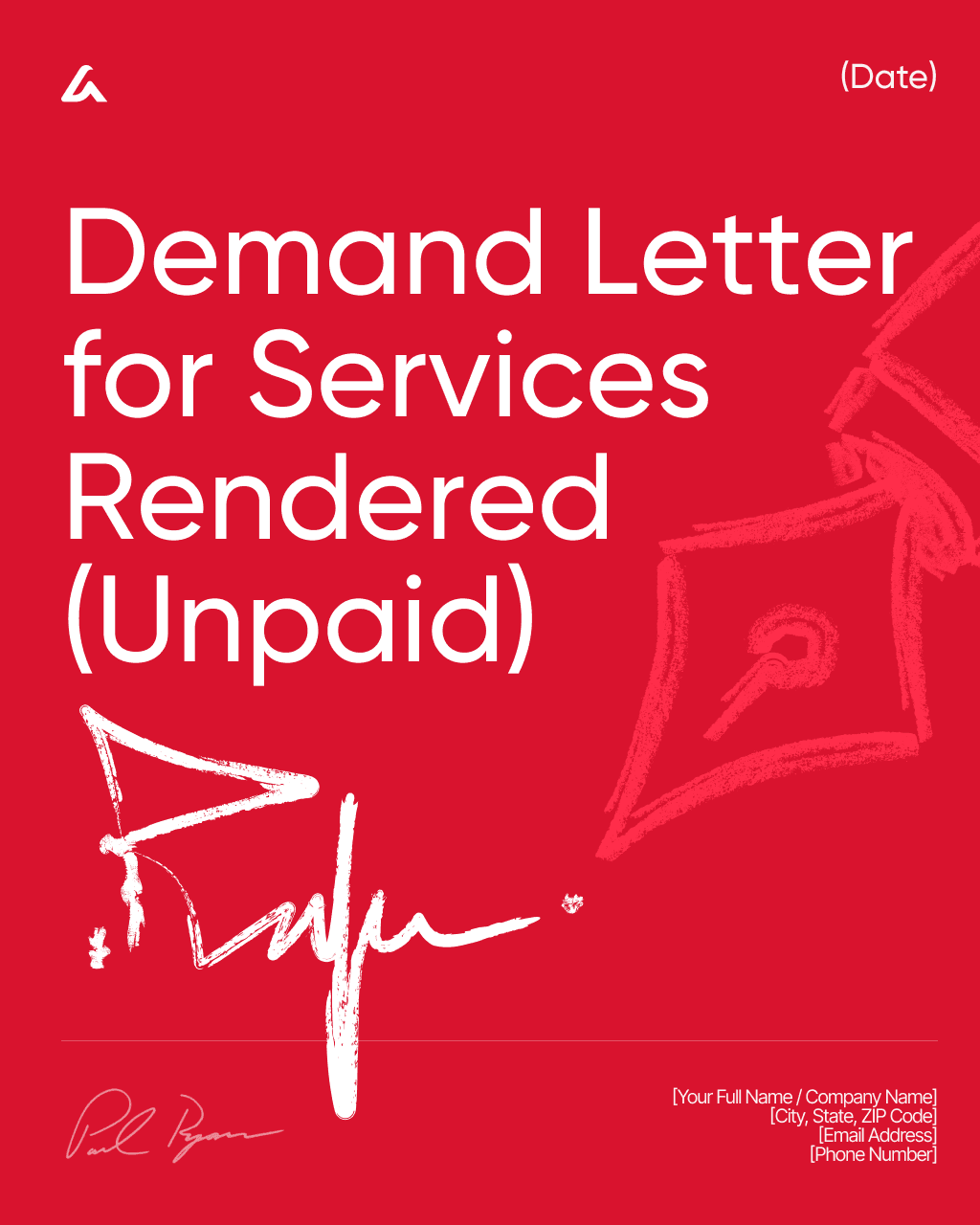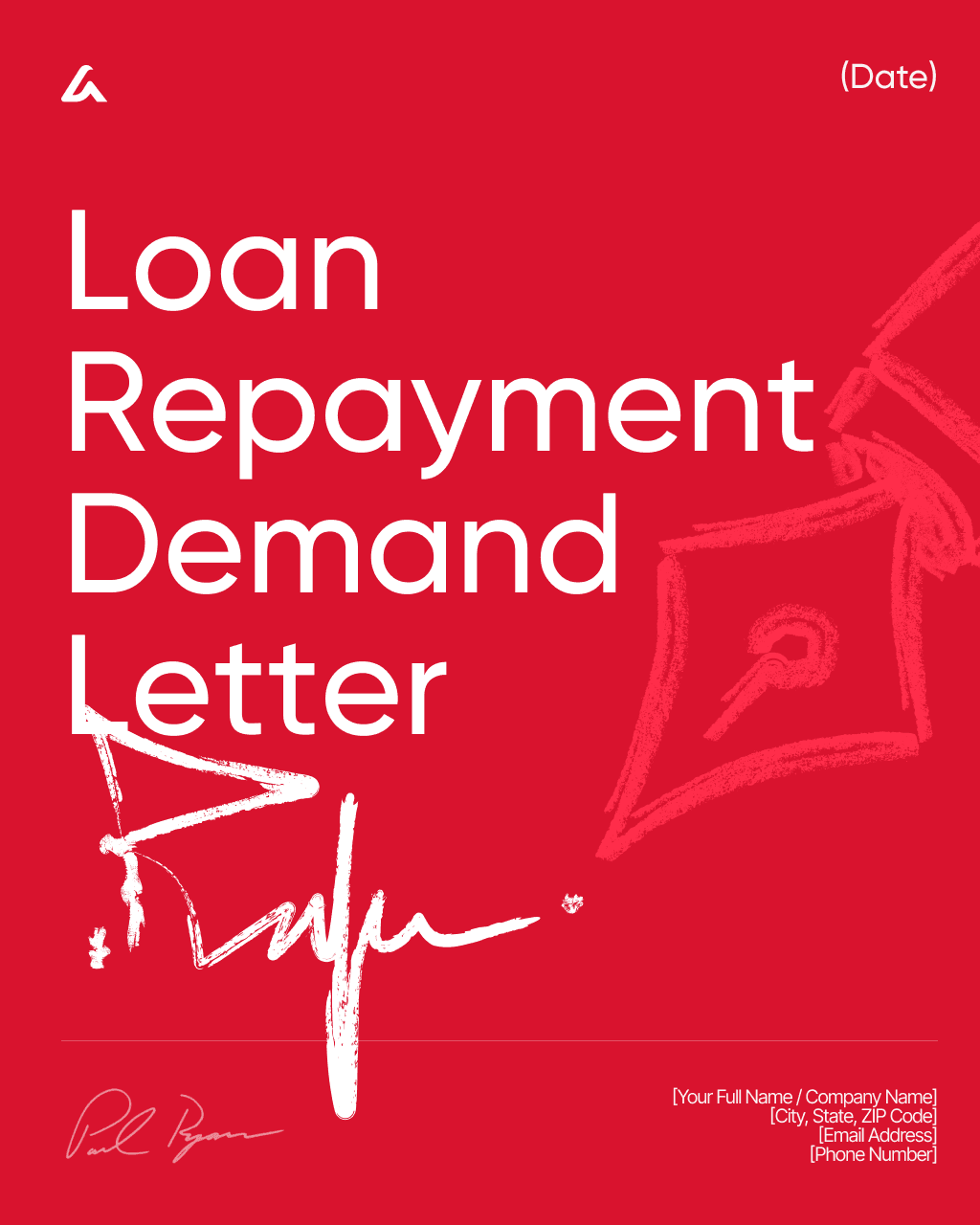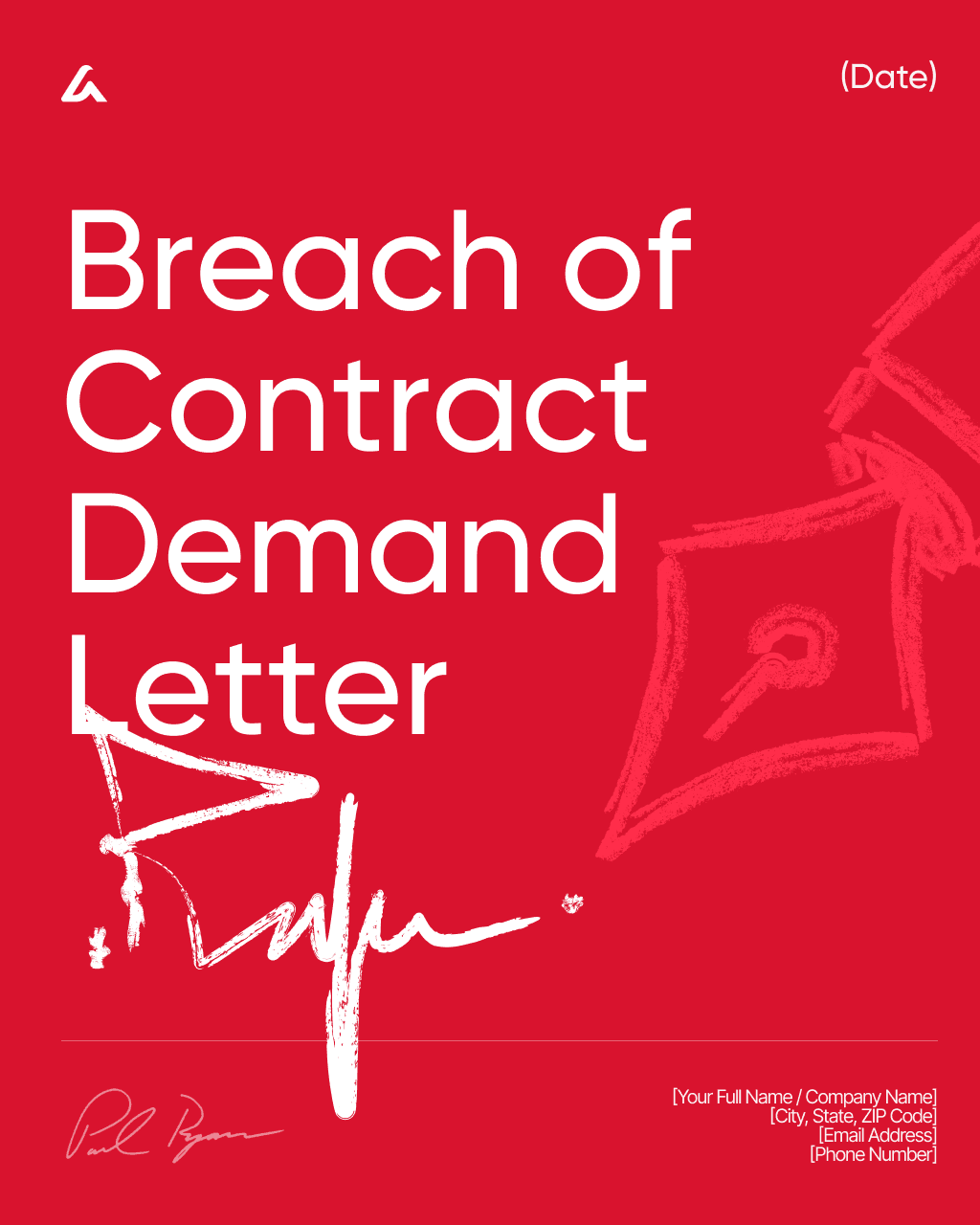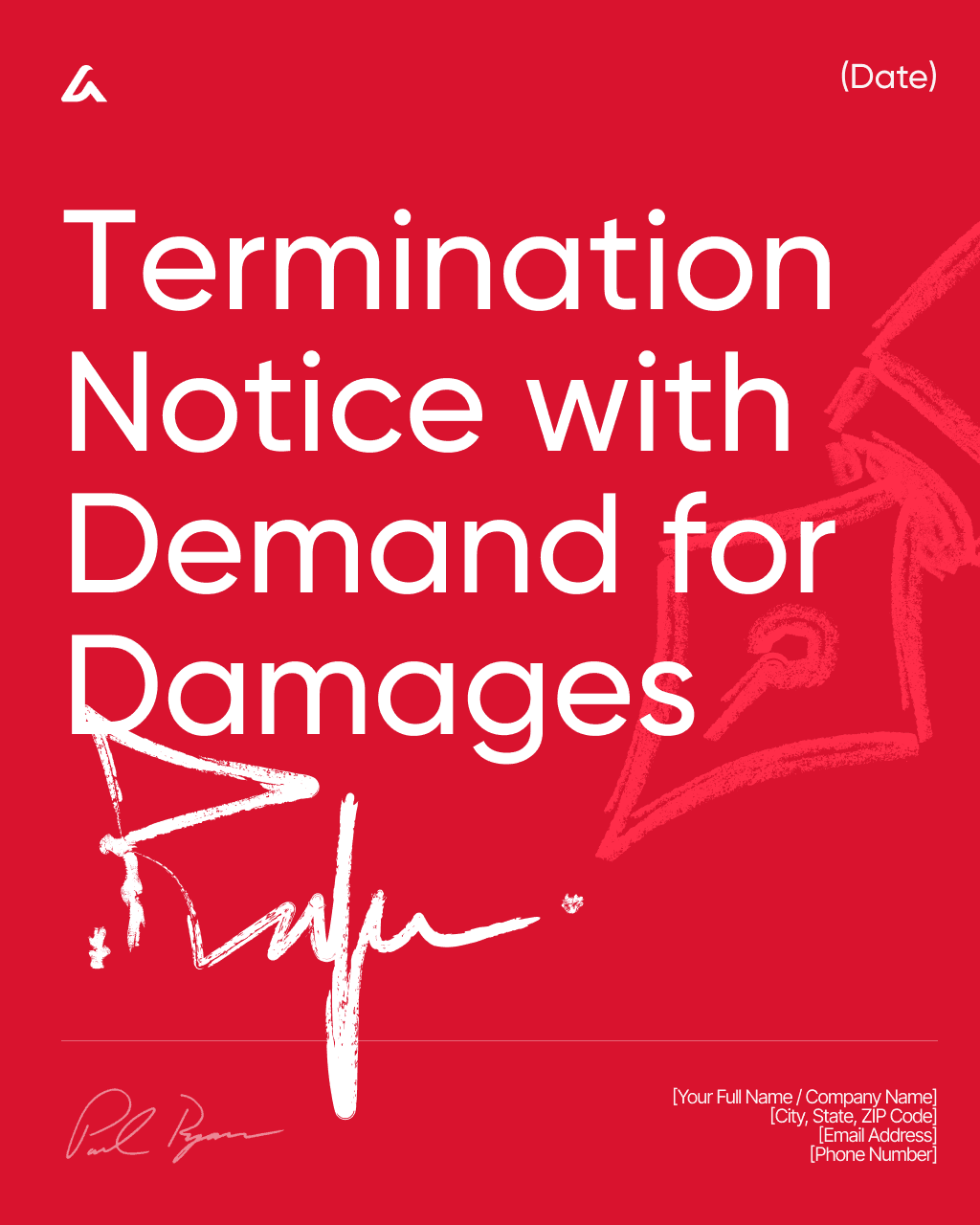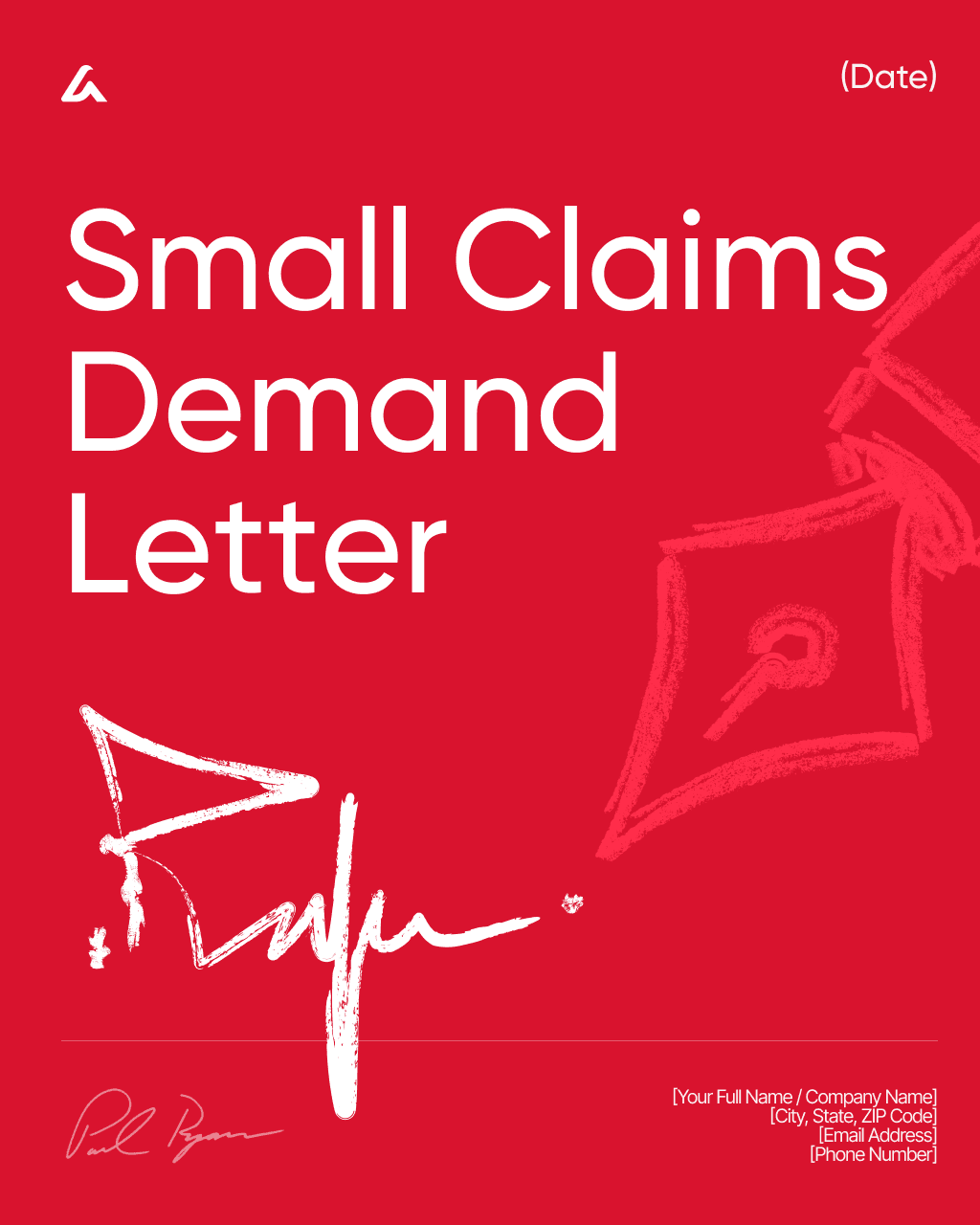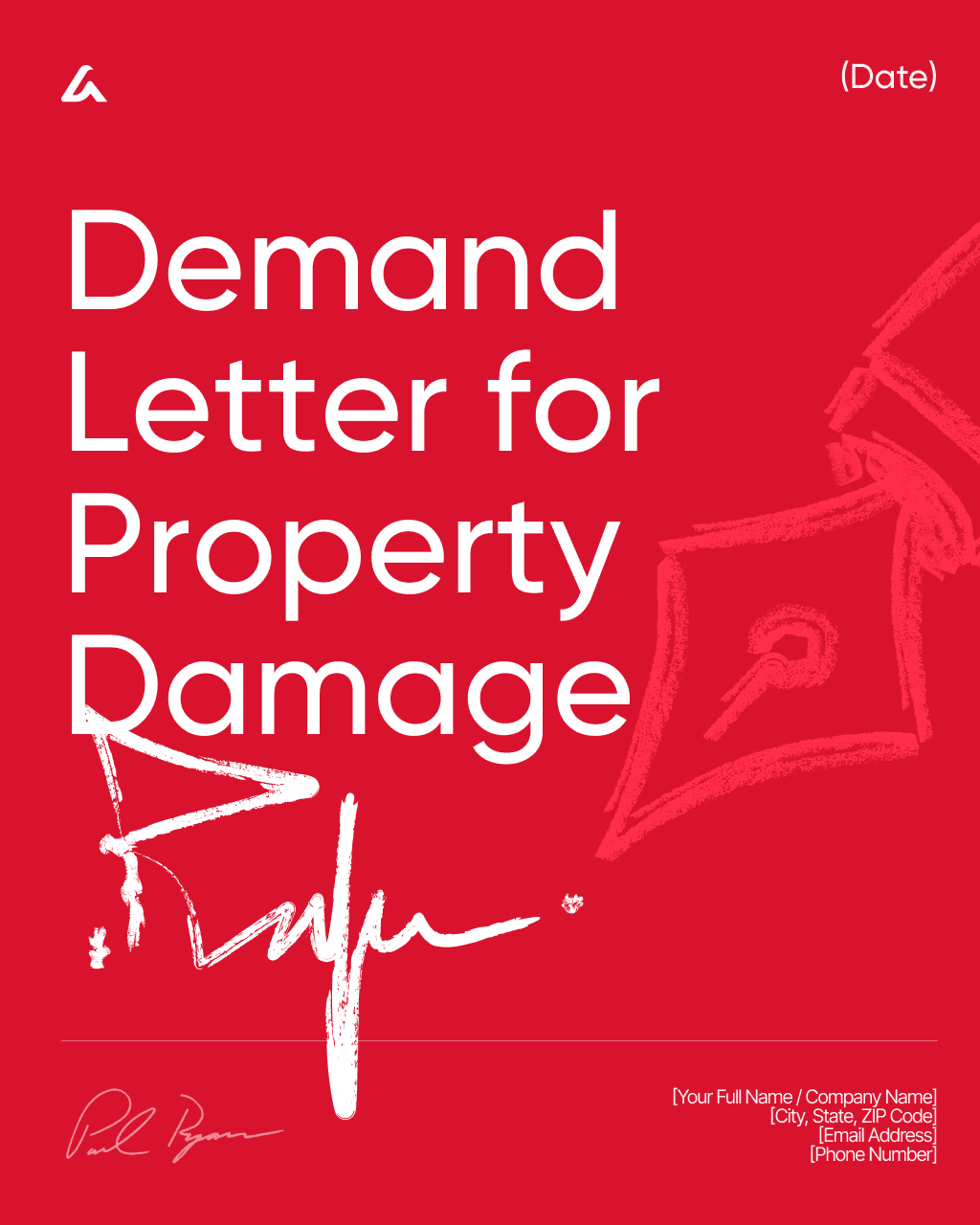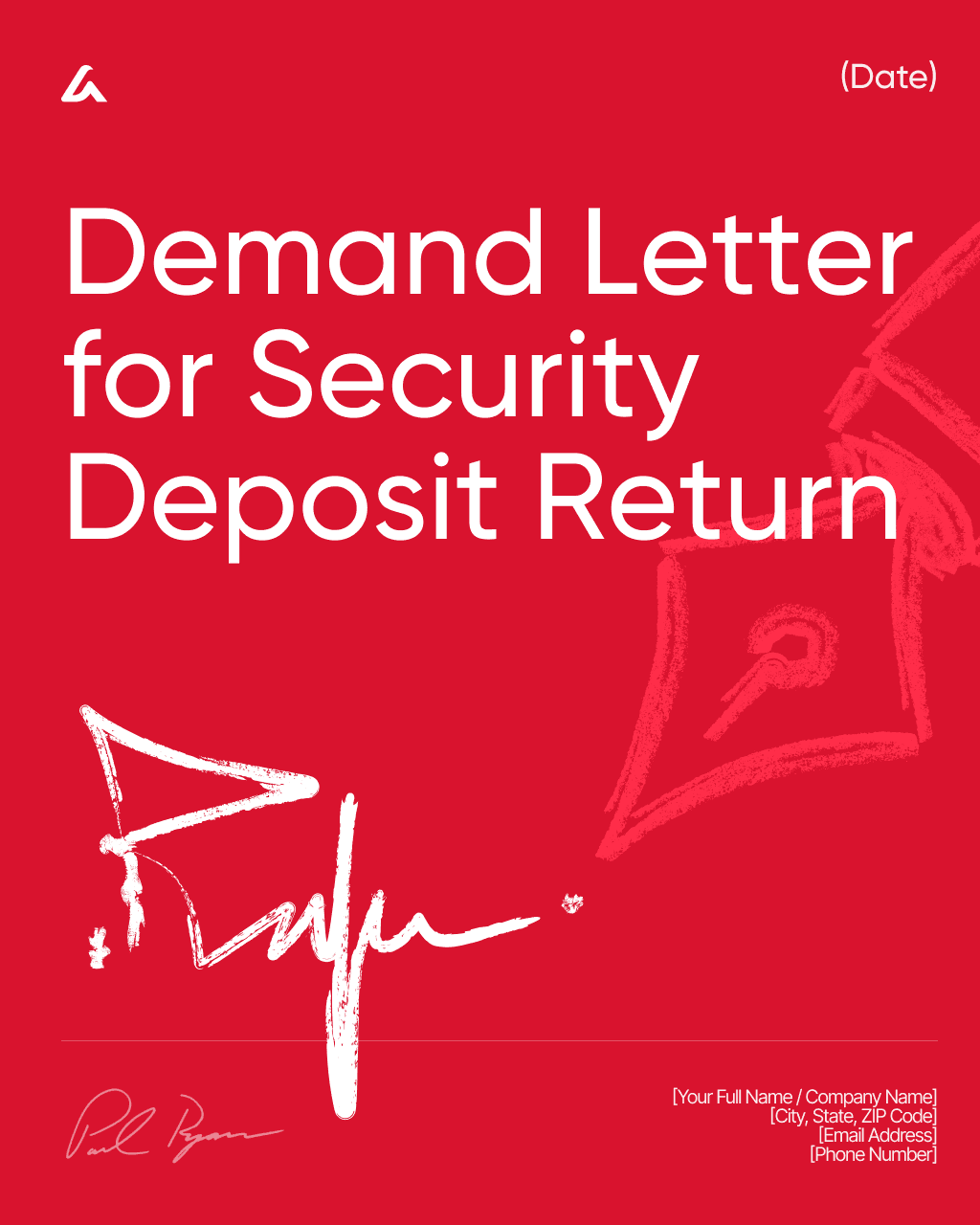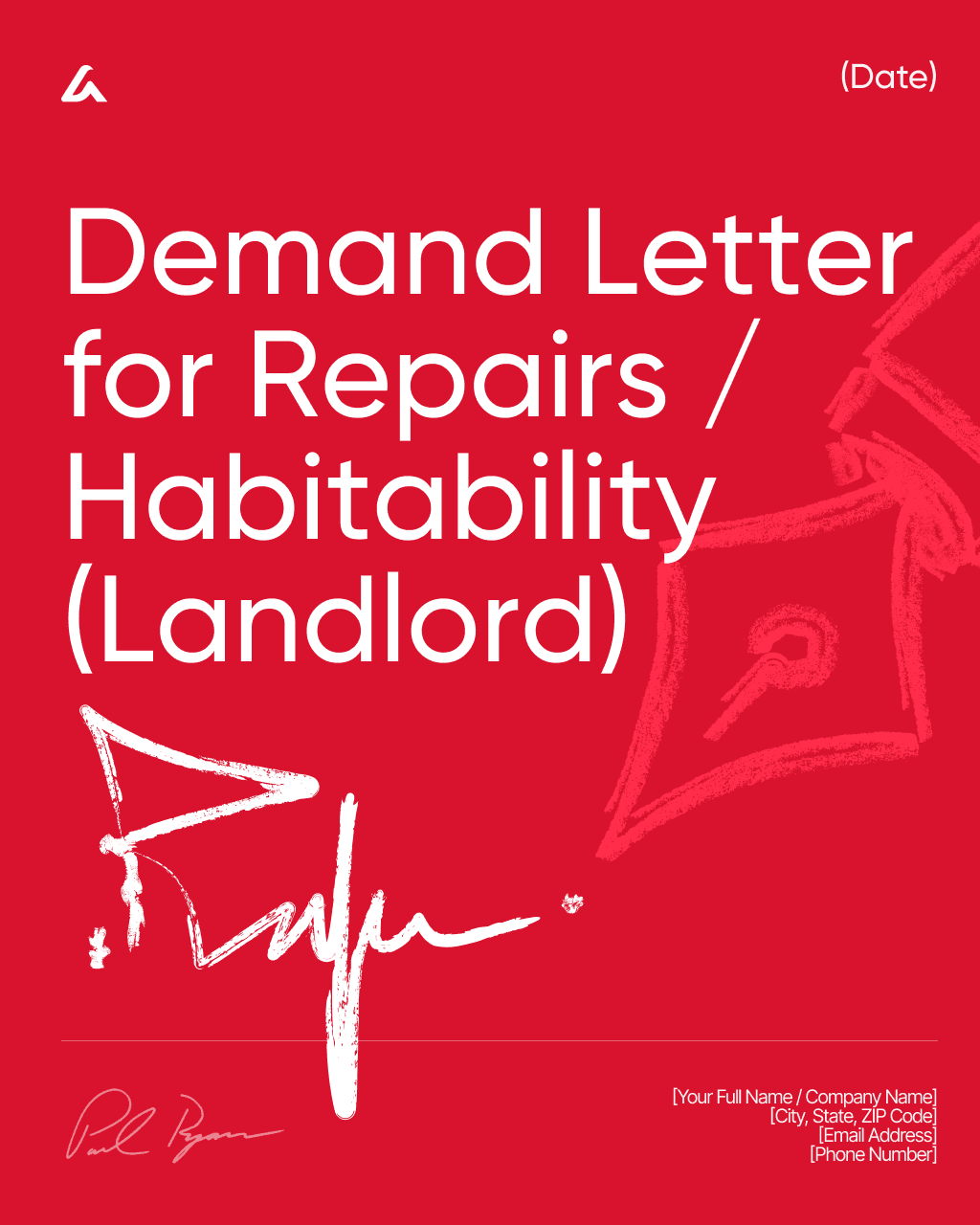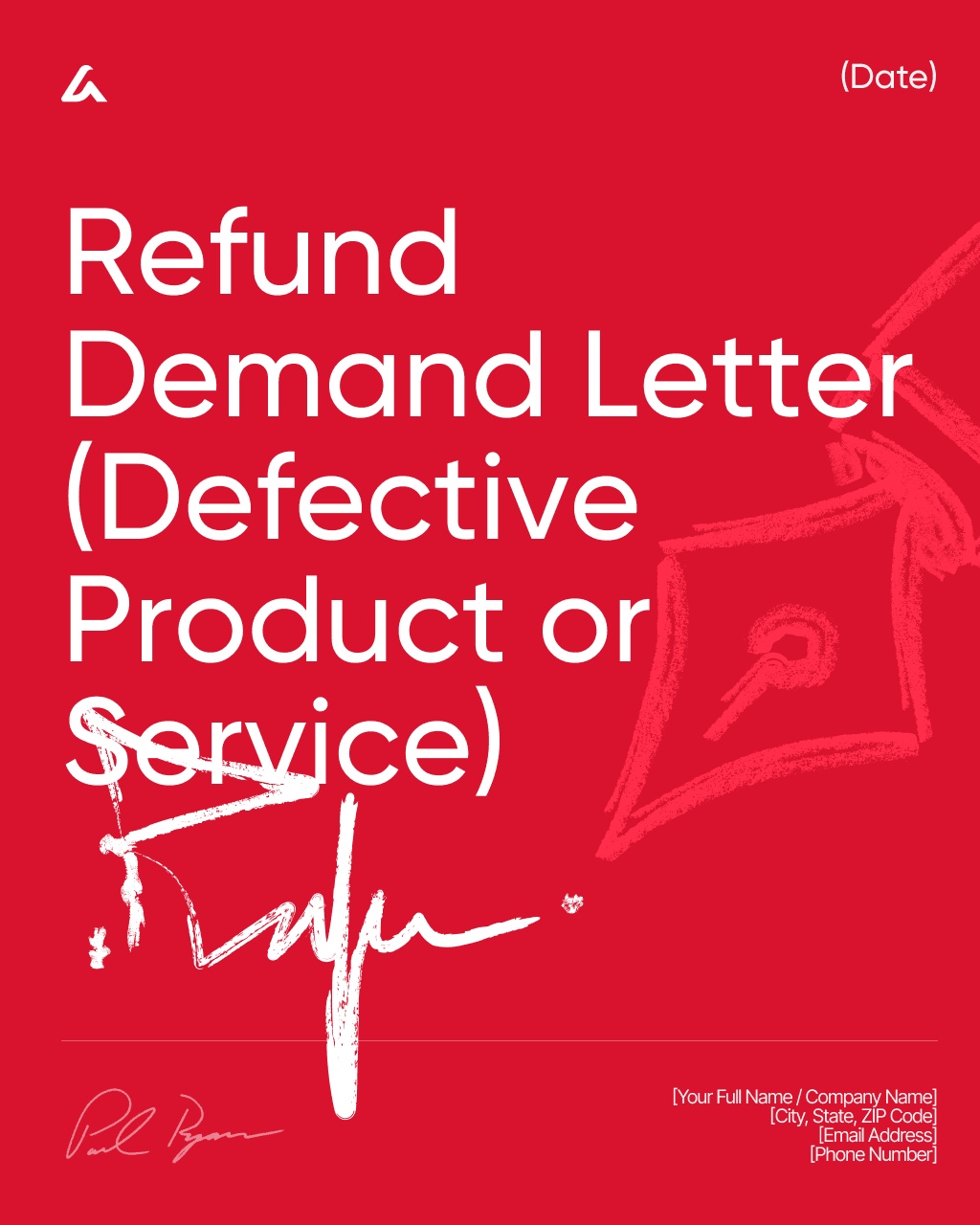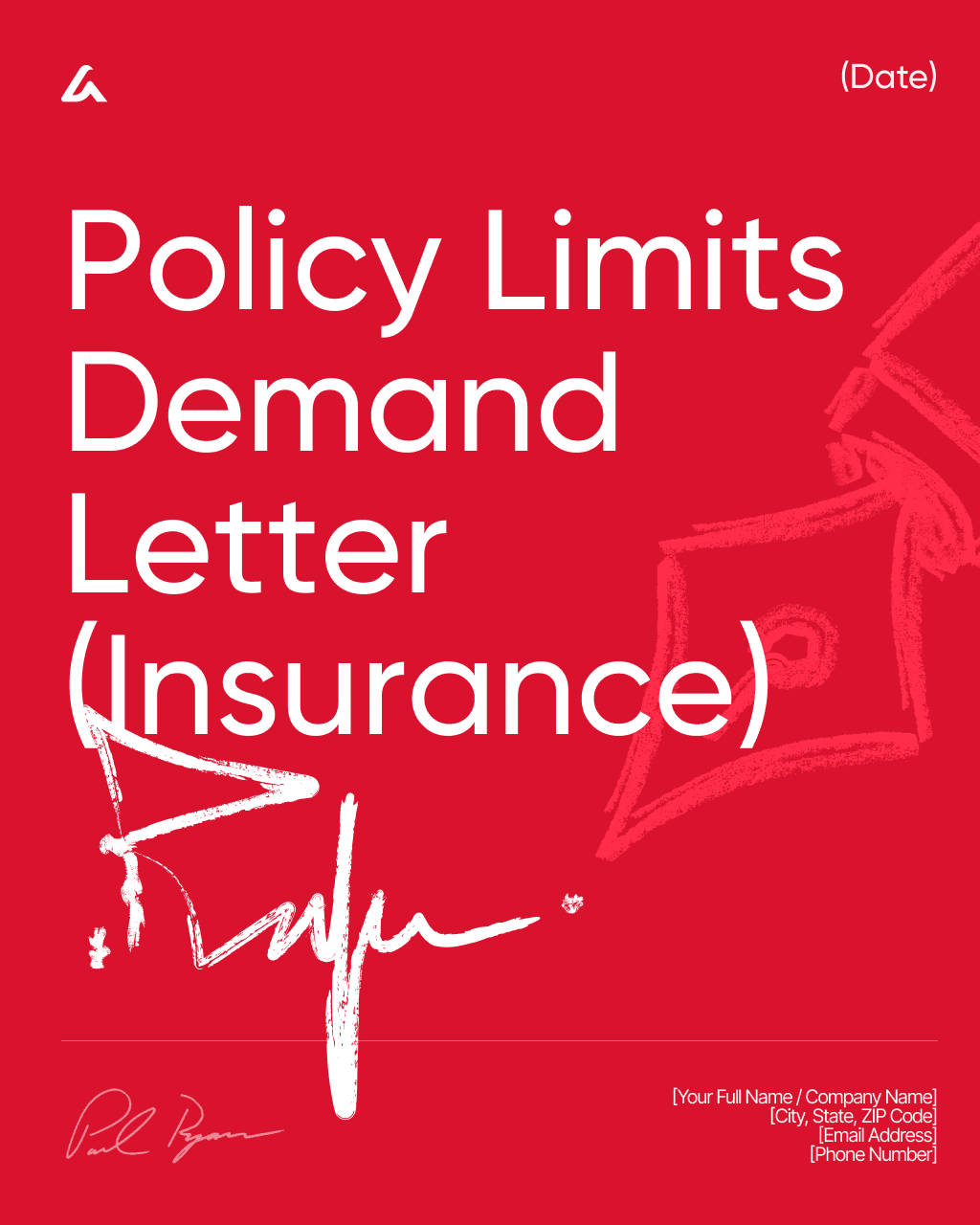Template category
Letters and Notices Templates
Essential templates for invoices, receipts, order forms, client agreements, and more.
Letters and Notices Templates
Table of Contents
1. Essential Letters & Notices Templates
1.1 Reference Letter (Recommendation Letter)
1.2 Operating Agreement
1.3 Letter of Intent (LOI)
1.4 Demand Letter
1.5 Cease and Desist Letter
1.6 Final Demand Letter
1.7 Witness Statement Template
1.8 Product Defect Notice
1.9 Notice of Default in Payment
1.10 Loss Notice Letter
1.11 Layoff Notice Letter
1.12 Invitation Letter for Visa
1.13 Immigration Support Letter (Character Reference)
1.14 Immigration Recommendation Letter
1.15 FOIA Request Letter
1.16 Event Liability Waiver
1.17 Employment Reference Request Letter
1.18 Demand for Payment
1.19 Car Donation Letter
1.20 Business Letter of Recommendation
1.21 Academic Letter of Recommendation
1.22 Final Notice Before Legal Action
1.23 Activity Waiver and Release Form
1.24 Contract Termination Letter
1.25 DUI Incident Narrative Personal Statement Template
1.26 DUI Timeline of Events Template
1.27 DUI Apology Letter to the Court Template
1.28 DUI Hardship or Restricted License Statement Template
1.29 DUI Financial Hardship Statement for Costs and Fines Template
1.30 DUI Treatment and Sobriety Summary Letter for Court Template
1.31 DUI Stop Medical and Physical Condition Statement Template
1.32 DUI Safety and Compliance Plan for Court Template
1.33 Driver’s License Reinstatement Letter to DMV or Licensing Authority Template
1.34 Ignition Interlock Device Removal Request Letter Template
1.35 DMV Administrative Hearing Request Letter after DUI Arrest Template
1.36 DUI Explanation Letter for Job Application or Background Check Template
1.37 DUI Explanation Letter to Current Employer (HR Notification) Template
1.38 Professional License Disclosure Letter Explaining DUI (Board Notification) Template
1.39 DUI Explanation Letter for College / University / Graduate Program Application Template
1.40 DUI Explanation Letter for Rental Application / Tenant Screening Template
1.41 AA / NA Meeting Attendance Log (Fillable Form) Template
1.42 AA / NA Sponsor Verification Letter Template
1.43 Therapist / Counselor Treatment Verification Letter (DUI-Related) Template
1.44 Probation Compliance Progress Report (Client Statement) Template
1.45 Relapse Prevention / Sobriety Maintenance Plan Template
1.46 Cover Letter for DUI Expungement / Record-Sealing Petition Template
1.47 Early Termination of Probation Request Letter (DUI Case) Template
1.48 General Letter of Support Template for DUI Case (Family / Friends / Employer)
1.49 Teacher Cover Letter Template
1.50 Affidavit Letter of Support for Immigration Template
1.51 USCIS Denial Appeal Letter Template
1.52 Bona Fide Marriage Letter Template
1.53 USCIS Cover Letter Template
1.54 Financial Support Letter for Immigration Template
1.55 Good Moral Character Letter for Immigration Template
1.56 Immigration Letter of Support for Marriage Template
1.57 Hardship Letter for Immigration Template
1.58 Letter of Support for Asylum Applicant Template
1.59 Family or Friend Letter of Support for Immigration Template
1.60 Letter to Congressman for Immigration Case Template
1.61 Explanation Letter for Unlawful Presence / Visa Overstay Template
1.62 I-129 Petition for a Nonimmigrant Worker Cover Letter Template
1.63 I-129F Petition for Alien Fiancé(e) Cover Letter Template
1.64 USCIS Expedite Request Letter Template
1.65 Relationship Letter for Immigration Interview Template
1.66 Withdraw Petition Letter for Immigration Template
1.67 I-130 Petition for Alien Relative Cover Letter Template
1.68 I-130A Supplemental Information for Spouse Beneficiary Cover Letter Template
1.69 I-131 Application for Travel Document (Advance Parole) Cover Letter Template
1.70 I-140 Immigrant Petition for Alien Worker Template
1.71 I-212 Application for Permission to Reapply for Admission After Deportation or Removal Template
1.72 I-485 Application to Register Permanent Residence or Adjust Status Template
1.73 I-526 Immigrant Petition by Standalone Investor Template
1.74 I-526E Immigrant Petition by Regional Center Investor Template
1.75 I-589 Application for Asylum and for Withholding of Removal Personal Statement Template
1.76 I-601 Application for Waiver of Grounds of Inadmissibility Personal Statement Template
1.77 I-601A Application for Provisional Unlawful Presence Waiver Personal Statement Template
1.78 I-751 Petition to Remove Conditions on Residence Personal Statement Template
1.79 I-765 Application for Employment Authorization Cover Letter Template
1.79 I-821 Application for Temporary Protected Status Personal Statement Template
1.80 I-821D Consideration of Deferred Action for Childhood Arrivals Personal Statement Template
1.81 I-90 Application to Replace Permanent Resident Card Cover Letter Template
1.82 N-400 Application for Naturalization Cover Letter Template
1.83 N-565 Application for Replacement Naturalization/Citizenship Document Cover Letter Template
1.84 N-600 Application for Certificate of Citizenship Cover Letter Template
2. Jurisdictional Peculiarities of Letters & Notices in the USA
2.1 West Coast: California and Washington
2.2 Northeast: New York
2.3 Southern States: Texas and Florida
2.4 Midwest: Illinois
3. News & Legal Updates (2024–2025)
3.1 Federal Push on Non-Competes – and State Bans
3.2 NLRB and Employment Agreements – Impact on Letters
3.3 Corporate Transparency Act (2024) – LLC Operating Agreements
3.4 Cease and Desist Letters Go Public
3.5 Demand Letters as Evidence of Good Faith (or Bad)
3.6 AI and Letters: 2025 Regulatory Attention
4. Conclusion: Clear Templates = Confidence and Trust
1. Essential Letters & Notices Templates for Your Business
Every business correspondence — from formal letters to legal notices — is an opportunity to protect your interests and project professionalism. Using standardized, AI‑powered templates ensures your message is clear, legally sound, and tailored to prevent disputes before they start. By relying on well‑crafted templates, companies can avoid misunderstandings and costly legal conflicts, as standardized structure and language minimize ambiguity, reducing the likelihood of miscommunication or missed legal details. In fact, taking the time to formalize intentions or grievances in writing often keeps matters out of court: roughly 95–96 % of U.S. civil cases settle before trial, with only about 4–5 % reaching that stage (source: Omar Ochoa Law – “95–96 % of civil cases settle before trial”). In short, clear written communication — powered by templates and AI — translates to fewer surprises and stronger legal protection.
AI-powered document generators make it easy to create polished, legally compliant letters and notices. By guiding you through key clauses and local requirements, they ensure each template covers the essentials, from proper formatting to state-specific language.
Modern AI Lawyer tools go beyond basic boilerplates. They actively help you include the right provisions (and exclude risky ones), drawing on up-to-date legal knowledge. The result is correspondence that not only looks professional but also holds up under scrutiny. Whether you’re writing a Letter of Intent to kick off a business deal or firing off a Cease and Desist to halt infringements, using a vetted template means you’re backing your words with legal substance. This comprehensive guide will explore five essential letter and notice templates, compare their uses and legal weight, address state-by-state quirks (California, New York, Texas, Florida, Illinois, Washington), and highlight recent legal updates (2024–2025) that affect how these documents are used and enforced. By the end, you’ll see how leveraging AI-generated templates leads to clearer communication, reduced liability, and greater trust from partners and clients.
Related Templates for Smarter Communication & Deals:
Quick Highlights:
Why Standardized Letters Matter: How templates prevent disputes and ensure professional tone from the start.
State Laws to Know: Key regional laws (from California’s stance on LOIs to Texas’s demand letter rules) that can impact your letters.
2024–2025 Updates: New legal developments (non-compete bans, transparency rules) and how AI Lawyer keeps your documents compliant.
1.1 Reference Letter (Recommendation Letter)

A reference letter serves to formally endorse an individual’s qualifications or character for a job, academic program, immigration application, or other opportunity. It provides a written record of someone’s skills, experience, and trustworthiness as observed by a credible recommender. Legally, reference letters are generally low-risk, but they should remain truthful and factual – a dishonest recommendation could potentially lead to liability if a third party relies on it to their detriment. Common use cases include job reference letters (supporting a former employee’s job hunt), academic recommendations (for students or researchers), or immigration letters of support (vouching for someone’s good moral character in visa or citizenship processes).
Using a standardized template for recommendation letters offers key benefits. It ensures you cover all essential points – the recommender’s relationship to the candidate, specific examples of the candidate’s strengths or accomplishments, and a clear endorsement – in a concise format that hiring managers or officials expect. A good template also sets a professional tone, which reflects well on both the writer and the candidate. AI-powered tools can further tailor the letter’s wording to avoid biased language and stick to objective facts. AI Lawyer notes that many people struggle with where to begin when writing recommendations; a template provides an efficient framework, cutting drafting time significantly and producing a polished letter that carries weight.
Download Template: Reference Letter
For more information please refer to our article: Reference Letter (Recommendation) Template- A complete Guide (Free Download + AI Generator)
Or create your own document yourself with the help of AI.
1.2 Operating Agreement

An Operating Agreement is a foundational policy document for LLCs. Standardizing this agreement helps align members on rules and safeguards the company against internal conflicts.
An Operating Agreement is a formal contract among the members of a Limited Liability Company (LLC) outlining how the business will be run. This document defines each member’s rights and responsibilities, voting power, profit shares, management structure, and procedures for major events (like adding members or dissolving the company). In legal terms, an operating agreement is crucial for multi-member LLCs – it supersedes default state LLC laws and can prevent disputes by setting clear rules upfront. Many states don’t strictly require an LLC to have one, but some do (New York, for instance, mandates adopting a written operating agreement), and even where not required, it’s strongly recommended. The common use case is during the formation of an LLC or when a new partner joins: the operating agreement is drafted or updated to reflect the new arrangement.
The benefits of using a standardized template for an operating agreement are immense. It ensures no key topic is overlooked – from capital contributions and ownership percentages (preventing later fights over who owns what), to how profits/losses are allocated, to dispute resolution mechanisms. A solid template provides consistency and completeness, covering provisions that a DIY approach might miss. This reduces the risk of costly misunderstandings down the road. For example, a template will prompt you to define what happens if a member wants to sell their stake, or how voting works for major decisions – areas that often cause conflict if undefined. AI Lawyer’s operating agreement template is kept up-to-date with the latest legal requirements (like including clauses required by certain states) and can be customized to your specific business scenario. By starting with a proven template, you create a legally robust agreement that protects the company and its members from internal turmoil and aligns with state laws.
Download Template: Operating Agreement
For more information please refer to our article: Operating Agreement Template Guide(Free Download + AI Generator)
Or create your own document yourself with the help of AI.
1.3 Letter of Intent (LOI)

A Letter of Intent (LOI) is a preliminary document used at the start of a negotiation or deal-making process. It outlines the initial understanding of the parties on key terms before a definitive contract is drafted. Think of it as a roadmap or handshake in writing: it covers the major points like price, timelines, or scope for a potential agreement, without binding the parties to finalize the deal. Legally, most LOIs are written to be non-binding (except for certain clauses like confidentiality or exclusivity), but it’s important to explicitly state that intent – otherwise, if an LOI contains all material terms, courts might treat it as a binding contract. Common use cases include business acquisitions, partnerships, investments, or large purchases (e.g. real estate deals), where the parties want a written record of progress while due diligence or financing steps are underway. An LOI gives each side a level of comfort that they are aligned on the big-picture terms before spending more resources.
Using a standardized LOI template is extremely beneficial. It ensures you address all the critical components: identification of parties, description of the project or transaction, key terms like price or equity split, a timeline for next steps, and which provisions (if any) are binding. A well-crafted template will also include explicit language about the non-binding nature of most provisions (to avoid accidental enforceability) and include a clause about governing law or dispute resolution if things fall through. According to legal experts, a good LOI gives you “an option to back out if things don’t go as planned” while laying a foundation of trust. It also buys time for due diligence by clearly stating intentions and temporarily “freezing” the deal terms. By leveraging an AI Lawyer LOI template, you can generate a letter that balances clarity and flexibility – one that signals commitment and good faith, without inadvertently locking you into terms too early. It’s a delicate balance that a vetted template helps maintain, ultimately protecting both sides as they move toward a final agreement.
Download Template: Letter of Intent (LOI)
Each state has its own rules and nuances — what’s valid in California might not hold in Texas or New York. Choose your jurisdiction-specific sample version for full compliance: California | New York | Texas | Florida | Illinois | Washington
For more information please refer to our article: Letter of Intent (LOI) Template (Free Download + AI Generator)
Or create your own document yourself with the help of AI.
1.4 Demand Letter

A Demand Letter Template provides a formal and professional structure for requesting that another party fulfill a legal or contractual obligation before litigation becomes necessary. It’s typically used when a payment remains overdue, a contract has been breached, or an insurer has failed to honor its duties. In many jurisdictions, such as Texas under the Deceptive Trade Practices Act (DTPA), sending a written demand is not just strategic — it’s required by law. For instance, Texas Business & Commerce Code § 17.505 mandates that a consumer provide at least 60 days’ written notice before filing suit. Beyond compliance, a well-crafted demand letter demonstrates good faith, documents your attempts to resolve the matter, and makes clear that you are prepared to escalate if ignored. Demand letters are most common in business-to-business disputes, consumer claims, employment disagreements, and unpaid service or invoice matters — effectively serving as the final opportunity to settle before legal action begins.
Using a standardized Demand Letter Template ensures your notice is complete, lawful, and persuasive. A reliable template walks you through each key element: identifying the parties, describing the issue and how it breached a contract or statute, stating the specific demand (e.g., payment, performance, or correction), setting a reasonable deadline, and explaining the next step — such as filing a lawsuit or complaint — if the issue remains unresolved. It also helps you include supporting evidence like invoices, communications, or contracts, while avoiding improper threats or overly emotional language that could undermine your credibility. Professionally written templates strike the right tone: firm but civil, making the seriousness of your intent clear without escalating hostility. With AI-powered assistance, templates can be customized for jurisdictional requirements and automatically insert the proper legal citations, deadlines, and formatting. Sending a polished demand letter often achieves quick compliance — showing that you understand your rights and are prepared to act — and if litigation follows, it serves as documented proof that you made every effort to resolve the dispute amicably.
Download Template: Demand Letter
Each state has its own rules and nuances — what’s valid in California might not hold in Texas or New York. Choose your jurisdiction-specific sample version for full compliance: California | New York | Texas | Florida | Illinois | Washington
For more information please refer to our article: Demand Letter Template (Free Download + AI Generator)- All You Need to Know!
Or create your own document yourself with the help of AI.
1.5 Cease and Desist Letter

A Cease and Desist Letter Template is a formal document used to demand that an individual or organization immediately stop unlawful, harmful, or otherwise unauthorized conduct. Unlike a demand letter, which typically seeks affirmative action (such as payment or performance), a cease and desist letter focuses on prohibiting specific behavior — for example, intellectual property infringement, breach of confidentiality, harassment, defamation, or violation of a contractual restriction like a non-compete clause. Though not a court order, this letter serves as a crucial pre-litigation step: it establishes a written record of your objection, provides notice to the offending party, and sets the stage for further legal remedies if the misconduct continues. Cease and desist letters are widely used in business, employment, and personal disputes because they combine warning and opportunity — signaling readiness to enforce rights while still inviting voluntary compliance. Often, receiving such a letter is enough to end the behavior, as most recipients prefer avoiding a public lawsuit or injunction.
Using a standardized Cease and Desist Letter Template ensures the message is assertive, precise, and legally defensible. A well-designed template helps you include all key components — a clear description of the wrongful act, evidence or explanation of your rights, a direct demand to stop the behavior and refrain from repeating it, and a statement of intended legal action if the request is ignored. It also guides tone and structure, maintaining professionalism while underscoring the seriousness of the situation. Including references to relevant laws or contract terms (e.g., copyright statutes or NDA clauses) further strengthens your position. Templates reduce the risk of overly emotional or vague wording, which could undermine the letter’s authority. With AI-assisted drafting, modern templates can adapt language to reflect jurisdictional nuances, such as state-specific defamation laws or anti-SLAPP protections, ensuring compliance and clarity. A properly drafted cease and desist letter demonstrates preparedness and credibility — often achieving compliance swiftly, preserving your rights without immediate court intervention.
Download Template: Cease and Desist Letter
Each state has its own rules and nuances — what’s valid in California might not hold in Texas or New York. Choose your jurisdiction-specific sample version for full compliance: California | New York | Texas | Florida | Illinois | Washington
For more information please refer to our article: Cease and Desist Letter Template (Free Download + AI Generator)
Or create your own document yourself with the help of AI.
1.6 Final Demand Letter

A Final Demand Letter Template provides the structured framework for issuing the last formal notice before pursuing legal action. It’s typically used after prior reminders or an initial demand have gone unanswered, signaling that the sender has exhausted all reasonable avenues for resolution. This document serves as both a professional warning and an opportunity for the recipient to comply before escalation. It sets out a short, definitive deadline for payment or corrective action, explains the breach or outstanding obligation, and outlines the next legal steps—such as filing a lawsuit, arbitration, or referring the matter to collections. Common scenarios include overdue invoices, contract breaches, unreturned deposits, or unfulfilled service obligations. By documenting each attempt to resolve the issue, a final demand letter shows that the claimant acted in good faith before resorting to enforcement measures.
Using a Final Demand Letter Template ensures the communication remains legally sound, complete, and professional. A standardized format prompts you to include all essential details—dates of prior notices, total amount owed or performance required, governing clauses, and the final compliance deadline—without using language that could be interpreted as harassment or threat. Templates also help maintain the right balance between firmness and respect, enhancing credibility if the letter is later reviewed by a court or regulator. For businesses and law firms, digital templates save time and promote consistency across departments. AI-assisted drafting tools can automatically adapt tone, deadlines, and statutory references to your jurisdiction, reducing errors and ensuring compliance with pre-litigation requirements. In practice, a well-structured final demand letter often achieves voluntary resolution—recovering debts or securing compliance—without the need for costly legal proceedings.
Download Template: Final Demand Letter
For more information please refer to our article: Final Demand Letter Template (Free Download + AI Generator) – A Complete Guide.
Or create your own document yourself with the help of AI.
1.7 Witness Statement Template

A Witness Statement Template provides a formal, standardized structure for recording a person’s firsthand account of an event, dispute, or incident. In legal, HR, or compliance contexts, it serves as crucial documentary evidence—capturing exactly what a witness saw, heard, or experienced in their own words. Typically, the statement includes the witness’s identifying details (name, address, position, and relationship to the event), a chronological narrative of facts, and a declaration that the statement is true to the best of their knowledge. Witness statements are widely used in workplace investigations, personal injury claims, criminal proceedings, and insurance disputes. In legal practice, clarity and neutrality are essential—statements must reflect facts, not opinions, as any ambiguity or subjective language can weaken credibility or be challenged in court. A well-drafted witness statement not only preserves testimony accurately but also protects both the organization and the individual from later claims of misrepresentation or coercion.
Using a standardized Witness Statement Template ensures consistency, completeness, and legal reliability. It prompts the witness to include all necessary components—dates, times, descriptions, and signatures—while guiding them to avoid speculation or unnecessary detail. For HR teams and legal departments, standardized templates simplify internal investigations, helping maintain compliance with procedural fairness and data protection rules (such as confidentiality obligations under GDPR or U.S. privacy laws). Moreover, electronic versions with digital signature fields streamline record-keeping and reduce administrative errors. According to legal analysts, disputes often falter not due to lack of evidence, but because evidence was documented improperly. An AI-generated or AI-assisted witness statement template helps prevent such issues by enforcing a clear structure, neutral tone, and traceable formatting. Ultimately, it turns testimony into an organized, admissible record—reducing risks, saving time, and strengthening the credibility of your evidence.
Download Template: Witness Statement Template
For more information please refer to our article:
Or create your own document yourself with the help of AI.
1.8 Product Defect Notice

A Product Defect Notice Template is a formal document used to notify customers, suppliers, or distributors of a discovered defect in a product and outline the corrective steps being taken. It’s an essential tool for maintaining transparency, protecting consumers, and complying with product safety and warranty laws. A well-drafted notice includes details such as the affected product name or model, batch or serial numbers, nature of the defect, potential risks, and the recommended actions (for example, returning the product, halting use, or requesting a replacement). Businesses commonly issue product defect notices in industries like manufacturing, automotive, consumer goods, and electronics—especially when defects pose safety concerns or violate regulatory standards such as the Consumer Product Safety Act (CPSA) in the U.S. or the General Product Safety Regulation (GPSR) in the EU. Legally, issuing a defect notice demonstrates due diligence: it shows the company acted promptly to mitigate harm, reducing exposure to liability and reputational damage.
Using a standardized Product Defect Notice Template ensures consistency, compliance, and clarity in all communications. It provides a structured format to include the technical description of the issue, risk classification, customer instructions, and contact details for further assistance. Templates also help align messaging between departments (legal, quality assurance, and customer service), ensuring that all recipients receive the same verified information. Including recall or warranty response options in the template can help expedite resolution and document compliance with reporting requirements to agencies like the U.S. Consumer Product Safety Commission (CPSC) or the European Safety Gate (RAPEX). AI-powered tools can automatically adjust notices to fit jurisdictional language, product categories, and notification obligations, while maintaining a professional, customer-friendly tone. A properly written product defect notice not only fulfills legal duties but also reinforces brand credibility — turning a potential crisis into an opportunity to demonstrate accountability and commitment to consumer safety.
Download Template: Product Defect Notice
For more information please refer to our article:
Or create your own document yourself with the help of AI.
1.9 Notice of Default in Payment

A Notice of Default in Payment Template is a formal document issued when a borrower, tenant, or contracting party fails to make a required payment by the agreed-upon due date. It serves as an official warning that the account or obligation is in default and that further action may follow if payment is not made promptly. In business, finance, and real estate contexts, this notice is a critical part of the creditor’s record—it shows that reasonable notice was given before pursuing remedies such as late fees, repossession, foreclosure, or termination of contract. A well-drafted notice identifies the overdue amount, references the governing agreement, specifies how long the default has persisted, and provides a clear deadline (often 10–30 days) for payment to be made. Legally, this step often precedes acceleration of the debt or legal proceedings, as required by statutes or loan documents. Common use cases include unpaid rent under a lease, missed loan installments, or delinquent accounts in supplier contracts.
Using a standardized Notice of Default in Payment Template ensures the letter is both legally compliant and professional. A proper template guides the sender to include all key information: the total outstanding balance, due dates, relevant contract or invoice numbers, payment instructions, and consequences of continued default (such as enforcement actions or reporting to credit agencies). It also helps maintain the right tone—firm but factual—avoiding language that could be construed as harassment or intimidation. Consistent formatting and precise language strengthen the creditor’s position if the dispute later escalates to court or arbitration. For lenders and landlords, templates also ensure compliance with local laws that may require specific default notice content or delivery methods before further action can be taken. AI-assisted drafting tools can tailor notices to jurisdictional rules, automatically calculate interest or penalties, and produce polished communications quickly. By sending a clear and well-structured notice of default, organizations uphold professionalism, preserve legal rights, and often secure prompt payment without needing to initiate costly recovery proceedings.
Download Template: Notice of Default in Payment
For more information please refer to our article:
Or create your own document yourself with the help of AI.
1.10 Loss Notice Letter

A Loss Notice Letter Template is a formal document used to notify an insurance company, business partner, or relevant authority that a loss, damage, or incident has occurred which may result in a claim. It serves as the first official record of an event such as property damage, theft, accident, injury, or other covered occurrence. In insurance contexts, submitting a loss notice is often a contractual requirement — most policies mandate prompt written notification to preserve coverage rights. The letter typically includes key details such as the date and location of the incident, description of what happened, estimated loss amount, parties involved, and any immediate actions taken (e.g., police report, mitigation efforts). Common use cases include notifying insurers of a car accident, a warehouse fire, a workplace injury, or a cyber breach affecting insured systems.
Using a standardized Loss Notice Letter Template ensures compliance, clarity, and timeliness — three crucial elements for valid claims handling. A well-designed template prompts you to include all essential data fields that insurers expect: policy number, claim type, point of contact, and any attachments (photos, invoices, or reports). It also helps prevent common errors such as missing claim deadlines or providing incomplete information, which could delay or jeopardize reimbursement. In corporate contexts, standardized loss notices allow risk management and legal teams to track incidents consistently across departments, ensuring internal documentation aligns with external insurer reporting. AI-powered templates can further streamline this process by automatically formatting the letter, summarizing the loss description from uploaded evidence, and adjusting the language to meet the reporting standards of different insurers or jurisdictions.
By using a Loss Notice Letter Template, organizations demonstrate prompt and responsible reporting — a key factor in both preserving insurance coverage and mitigating potential liabilities. It formalizes the communication channel between the insured and the insurer, helping claims proceed efficiently while maintaining a professional and compliant record of the loss.
Download Template: Loss Notice Letter
For more information please refer to our article:
Or create your own document yourself with the help of AI.
1.11 Layoff Notice Letter

A Layoff Notice Letter Template is an official document used by employers to inform employees that their position is being terminated due to organizational, financial, or operational reasons—rather than individual performance. It serves both as a legal notification and as a professional communication tool that explains the reason for the layoff, the effective date of termination, and any available benefits or support options. Common causes include company restructuring, downsizing, mergers, loss of funding, or project completion. In many jurisdictions, such as under the U.S. Worker Adjustment and Retraining Notification (WARN) Act, employers are legally required to provide advance written notice (typically 60 days) before conducting mass layoffs or plant closures, ensuring employees have time to prepare or seek alternative employment.
Using a standardized Layoff Notice Letter Template ensures compliance with employment laws and consistency across all communications. A well-crafted template helps HR teams include all essential details: the employee’s name and role, termination date, reason for the layoff, final paycheck and benefits information, and any severance or continuation of health coverage (such as under COBRA in the U.S.). It also guides employers in maintaining a respectful and empathetic tone—acknowledging the employee’s contributions and offering assistance resources like job placement support or references. For organizations conducting group layoffs, standardized templates reduce the risk of inconsistent or noncompliant notices that could lead to legal challenges or reputational harm.
AI-powered templates, such as those provided by AI Lawyer, can adapt the notice to local labor regulations (for instance, state-specific WARN laws or EU redundancy directives), ensuring legal accuracy and clarity. By issuing a transparent, professionally worded layoff notice, employers demonstrate fairness and compliance, helping protect both the company’s legal position and its long-term relationship with departing staff.
Download Template: Layoff Notice Letter
For more information please refer to our article:
Or create your own document yourself with the help of AI.
1.12 Invitation Letter for Visa

An Invitation Letter for Visa Template is a formal document written to support a visa application by inviting a foreign individual—such as a friend, family member, employee, or business associate—to visit the host’s country. This letter serves as proof of the relationship between the inviter and the invitee and provides details about the purpose, duration, and nature of the visit. While it does not guarantee visa approval, it is a key supporting document often required by immigration authorities to demonstrate the applicant’s travel intent and ties to the host. Common use cases include inviting relatives for holidays or events, sponsoring a business visitor for meetings or conferences, or hosting participants for academic or cultural programs.
A proper invitation letter typically includes the inviter’s full name, address, citizenship or residence status, contact details, relationship to the visitor, and a statement taking responsibility for accommodation and travel arrangements. It should also specify the visitor’s full name, passport number, travel dates, and the purpose of the trip. For business or official visits, company letterhead and signature from an authorized representative are recommended. Some countries, like the United States (under B-2 or B-1 visas), Canada, or the United Kingdom, may also request a copy of the inviter’s ID, proof of legal status, or financial documents to validate the invitation.
Using a standardized Invitation Letter for Visa Template ensures you include all the required elements in a clear, formal, and legally appropriate way. It helps avoid common mistakes such as vague trip purposes or missing contact information, which can delay visa processing. A good template also maintains a polite and professional tone while aligning with embassy or consulate formatting expectations. AI-assisted templates, such as those from AI Lawyer, can tailor your letter to match the specific embassy’s requirements, automatically insert relevant legal phrasing, and adjust for visit type (tourism, business, study, or medical).
By using a well-structured visa invitation letter, you present a credible, organized, and transparent case—enhancing the applicant’s chances of approval while maintaining compliance with immigration guidelines.
Download Template: Invitation Letter for Visa
For more information please refer to our article:
Or create your own document yourself with the help of AI.
1.13 Immigration Support Letter (Character Reference)

An Immigration Support Letter (Character Reference) is a formal statement written to support an individual’s immigration, residency, or citizenship application by attesting to their moral character, integrity, and community contribution. It’s typically authored by someone who knows the applicant personally—such as an employer, teacher, clergy member, or long-time friend—and can speak credibly about their honesty, reliability, and respect for the law. These letters play an important role in discretionary immigration cases, such as naturalization reviews, deportation defenses, or hardship waivers, where officials assess not only eligibility but also the applicant’s reputation and social value. A strong character reference includes the writer’s identity and relationship to the applicant, the duration of acquaintance, and specific examples that demonstrate good moral standing (such as volunteer work, family commitment, or consistent employment). Legally, such letters carry persuasive weight by providing a human context to the applicant’s file, though they must remain factual and sincere—false statements can damage credibility and even affect the outcome of the case.
Using a standardized Immigration Support Letter template helps ensure consistency, structure, and legal appropriateness. A well-designed template guides the writer to include all required sections: introduction and relationship background, specific examples of the applicant’s character, and a formal endorsement with contact details for verification. This ensures the letter meets immigration standards and reads professionally to reviewers who process hundreds of similar submissions. Templates also help avoid common mistakes, such as emotional exaggeration or missing factual anchors, which can weaken the applicant’s case. AI-powered drafting tools, like those from AI Lawyer, further enhance accuracy by tailoring the language to the specific immigration process—whether it’s a visa, green card, or citizenship application—and maintaining a respectful, formal tone. By starting from a proven framework, the recommender produces a letter that is authentic, credible, and aligned with official expectations, giving the applicant the strongest possible support in their immigration journey.
Download Template: Immigration Support Letter (Character Reference)
For more information please refer to our article:
Or create your own document yourself with the help of AI.
1.14 Immigration Recommendation Letter

An Immigration Recommendation Letter is a formal document written to support an individual’s immigration, residency, or citizenship application by emphasizing their professional qualifications, moral character, and contributions to society. Unlike a general character reference, this letter is often written by an employer, professor, community leader, or mentor who can credibly describe the applicant’s achievements, skills, and personal integrity in a structured, professional manner. It serves as supplemental evidence that the applicant is a trustworthy, valuable member of their community or field. Immigration officers reviewing such applications look for authenticity, consistency, and relevance — meaning the letter should clearly state how the writer knows the applicant, for how long, and under what circumstances. Typical use cases include employment-based visas (such as H-1B or EB categories), family-based immigration, asylum cases, or naturalization petitions where the applicant’s moral and professional reputation is under review. When properly written, an immigration recommendation letter adds a human dimension to the application, offering decision-makers credible insights into the applicant’s conduct and reliability.
Using a standardized Immigration Recommendation Letter Template ensures the document includes every essential component immigration authorities expect: the writer’s full details and relationship to the applicant, factual examples demonstrating integrity or skill, and a clear endorsement stated in professional, non-emotional language. A well-structured template guides the recommender through proper formatting — introduction, qualifications of the writer, main body with examples, and a formal closing with contact information for verification. This not only ensures consistency across multiple recommendation letters but also enhances credibility by avoiding vague or exaggerated statements. AI-powered templates, such as those from AI Lawyer, further refine tone and structure to align with specific visa or immigration requirements, automatically adjusting phrasing for work-based, family, or humanitarian contexts. By using a trusted template, writers produce clear, persuasive, and compliant letters that strengthen the applicant’s case and reflect genuine, credible support in a professional way.
Download Template: Immigration Recommendation Letter
Each state has its own rules and nuances — what’s valid in California might not hold in Texas or New York. Choose your jurisdiction-specific sample version for full compliance: California | New York | Texas | Florida | Illinois | Washington
For more information please refer to our article:
Or create your own document yourself with the help of AI.
1.15 FOIA Request Letter

A FOIA Request Letter (Freedom of Information Act Request) is a formal written request submitted to a government agency to obtain access to public records or information. Under the Freedom of Information Act (5 U.S.C. § 552) in the United States, any person—citizen, journalist, researcher, or organization—has the right to request records held by federal agencies, except for materials protected by specific exemptions (such as national security, trade secrets, or personal privacy). This type of letter is essential for promoting transparency, accountability, and informed public discourse. It can be used to obtain government reports, contracts, correspondence, or data relevant to public policy, investigations, or research. While many agencies allow electronic submissions, the FOIA Request Letter remains a key formal document because it creates a traceable written record of the request, including the requester’s identity, a clear description of the records sought, and a statement specifying the preferred form of access (digital copies, inspection, or certified duplicates).
Using a standardized FOIA Request Letter Template ensures that your request is complete, compliant, and processed efficiently. A good template prompts you to include all legally required elements—your name and contact information, a precise description of the documents requested, the statutory citation to FOIA, and a statement of your willingness to pay reasonable search or duplication fees (or a fee waiver justification, if applicable). It also includes standard phrasing that preserves your rights to appeal or challenge a denial. Proper formatting and tone help convey professionalism and seriousness, improving the likelihood of timely responses. AI-powered templates, like those provided by AI Lawyer, can automatically tailor the language to the specific federal or state agency, adjust for jurisdictional FOIA equivalents (such as state open records laws), and insert the correct regulatory references. By using a vetted FOIA Request Letter template, individuals and organizations can make legally sound, clear, and persuasive requests that uphold the principles of government transparency while ensuring efficiency in the disclosure process.
Download Template: FOIA Request Letter
For more information please refer to our article:
Or create your own document yourself with the help of AI.
1.16 Event Liability Waiver

An Event Liability Waiver is a legal document that releases event organizers, sponsors, or venues from liability in the event of injury, loss, or damages sustained by participants. It’s commonly used for public gatherings, sports activities, corporate events, workshops, concerts, and charity functions—anywhere there’s potential physical risk or property damage. By signing the waiver, participants acknowledge they understand and voluntarily accept those risks, agreeing not to pursue legal action against the organizer for ordinary negligence. Legally, this document plays a critical role in risk management: it can significantly reduce exposure to lawsuits, provided it is clearly written, properly executed, and consistent with local laws. Courts often uphold liability waivers when the language is conspicuous, specific about potential risks, and signed voluntarily by an adult of sound mind. Common clauses include assumption of risk, release of claims, indemnification, and medical authorization. In some jurisdictions, like California or New York, courts scrutinize these waivers carefully, so clarity and compliance are essential to ensure enforceability.
Using a standardized Event Liability Waiver Template ensures that all legally required elements are included and properly worded to maximize protection. A strong template includes clearly labeled sections for participant information, acknowledgment of risks, signature blocks, and emergency contact details. It also provides adaptable clauses depending on the event type—whether a corporate retreat, athletic competition, or public festival—and includes jurisdiction-specific language where required. Templates eliminate common drafting errors, such as vague risk descriptions or missing indemnity terms, which can invalidate a waiver in court. AI-powered drafting tools, such as those from AI Lawyer, further enhance these templates by automatically adjusting legal phrasing to match applicable state laws and tailoring risk disclosures based on the activity’s nature. By starting with a professionally designed event liability waiver template, organizers demonstrate due diligence, strengthen their legal defense, and foster transparency with participants—creating safer, more compliant events while reducing potential legal exposure.
Download Template: Event Liability Waiver
For more information please refer to our article:
Or create your own document yourself with the help of AI.
1.17 Employment Reference Request Letter

An Employment Reference Request Letter is a formal document sent by an employer, recruiter, or background screening agency to verify a candidate’s employment history, performance, and conduct. It serves as an essential part of the hiring process, helping confirm that the information provided by the applicant is accurate and that their previous employer can vouch for their professional behavior and reliability. Typically, this letter requests confirmation of job title, employment dates, key responsibilities, and eligibility for rehire, but it may also ask for qualitative feedback such as teamwork, punctuality, and communication skills—depending on company policy and local privacy laws. Many jurisdictions, including those in the U.S. and EU, regulate how much information can be disclosed, requiring references to be factual, objective, and non-defamatory. This letter provides a professional, traceable means to collect that information while ensuring compliance with data protection and employment laws.
Using a standardized Employment Reference Request Letter Template ensures that the request is clear, lawful, and consistent across all candidates. A well-structured template guides HR teams or recruiters to include necessary identification details (such as the candidate’s full name, position, and consent), specify what information is being requested, and outline how the reference should be returned (e.g., by email or official form). It also incorporates neutral and legally compliant phrasing to avoid unintentionally prompting subjective or discriminatory comments. AI-powered templates, like those offered by AI Lawyer, can automatically adjust the content to fit local legal standards—such as GDPR data processing requirements or state-specific employment privacy laws—while maintaining a professional tone. By using a vetted template, organizations streamline their hiring verification process, minimize legal risks, and ensure all employment references are obtained ethically, efficiently, and with full documentation for future recordkeeping.
Download Template: Employment Reference Request Letter
For more information please refer to our article:
Or create your own document yourself with the help of AI.
1.18 Demand for Payment

A Demand for Payment Letter is a formal written notice sent to request the settlement of an overdue financial obligation. It is typically used when an invoice remains unpaid, a loan is in arrears, or a contractually owed amount has not been fulfilled. The letter serves as both a professional reminder and a legal record of the creditor’s attempt to collect payment before pursuing further action, such as mediation, arbitration, or litigation. A well-drafted demand for payment outlines the debt details clearly — including the original amount, due date, accrued interest or late fees, and relevant contract or invoice references — and provides a firm but reasonable deadline for payment. In many jurisdictions, sending a written demand is a required preliminary step before filing a lawsuit or claiming damages, as it demonstrates good faith and gives the debtor an opportunity to resolve the matter amicably. Typical use cases include unpaid commercial invoices, overdue rent, unreturned deposits, or breach of payment terms in service agreements.
Using a standardized Demand for Payment Template ensures clarity, professionalism, and compliance with debt collection laws. A strong template includes all the critical elements: a factual summary of the debt, amount owed with a detailed breakdown, payment instructions, a firm deadline (commonly 7–14 days), and a clear notice of potential consequences if payment is not received — such as legal proceedings, interest accrual, or credit reporting. It also helps maintain the right tone: assertive and formal, but not aggressive or unlawful, avoiding language that could be construed as harassment or extortion under consumer protection regulations. AI-powered templates, like those from AI Lawyer, automatically adjust for jurisdictional nuances, including statutory notice periods or specific disclosure requirements (such as those under the Fair Debt Collection Practices Act in the U.S.). By using a verified, well-structured template, businesses and individuals can issue effective, legally sound payment demands that encourage compliance while preserving professionalism and protecting their rights in any subsequent legal process.
Download Template: Demand for Payment
Each state has its own rules and nuances — what’s valid in California might not hold in Texas or New York. Choose your jurisdiction-specific sample version for full compliance: California | New York | Texas | Florida | Illinois | Washington
For more information please refer to our article:
Or create your own document yourself with the help of AI.
1.19 Car Donation Letter

A Car Donation Letter is a formal document provided to acknowledge the donation of a vehicle to a nonprofit or charitable organization. It serves as both a record of the transaction and, in many cases, proof required by tax authorities (such as the IRS in the United States) for the donor to claim a deduction. The letter typically includes details such as the donor’s name and address, the recipient organization’s information, the vehicle’s description (make, model, VIN, and year), the date of donation, and a statement confirming whether the organization provided any goods or services in exchange for the donation. Legally, such documentation is crucial — the IRS requires written acknowledgment for vehicle donations exceeding $500 under IRS Publication 4303 and Form 1098-C rules. Charities use this letter to ensure transparency and compliance, while donors rely on it to substantiate the fair market value of their contribution and qualify for a deduction. Common scenarios include donating used cars, motorcycles, or boats to nonprofits supporting veterans, education, or environmental causes.
Using a standardized Car Donation Letter Template ensures that both the donor and the charity include all information necessary for legal and tax compliance. A well-crafted template helps organizations maintain consistent formatting, include IRS-required disclosures, and specify the donor’s contribution value and acknowledgment of no material benefits received (if applicable). It also guides the writer to include official nonprofit identifiers, such as the organization’s EIN (Employer Identification Number) and 501(c)(3) status, which are often required for tax reporting. AI-powered tools, like those from AI Lawyer, can tailor donation letters automatically by incorporating region-specific tax references, generating compliant acknowledgment language, and formatting the letter for both electronic and printed use. By using a reliable template, charities can issue professional, audit-ready documentation, and donors can ensure their contributions are properly recognized — making the car donation process transparent, legally sound, and beneficial for both parties.
Download Template: Car Donation Letter
For more information please refer to our article:
Or create your own document yourself with the help of AI.
1.20 Business Letter of Recommendation

A Business Letter of Recommendation is a formal endorsement written to support a company, professional, or service provider by attesting to their reliability, quality of work, and ethical standards. It’s commonly used in B2B contexts — for example, when a vendor seeks new contracts, a consultant applies for government tenders, or a business partner needs credibility with investors or clients. The letter is typically written by someone with direct experience working with the business, such as a client, partner, or supervisor, who can speak to the company’s professionalism, performance, and integrity. A strong business recommendation highlights key accomplishments, consistent delivery, and positive outcomes from collaboration, offering both factual and reputational support. While not legally binding, such letters can carry significant persuasive weight in due diligence, partnership decisions, or procurement reviews. They provide an independent affirmation of trustworthiness, helping recipients evaluate the business beyond marketing claims.
Using a standardized Business Letter of Recommendation Template ensures clarity, structure, and a professional tone that aligns with corporate expectations. A well-designed template guides the recommender through all essential sections — introduction and relationship disclosure, specific examples of successful work or project outcomes, and a strong closing endorsement with contact details for verification. It ensures the letter remains concise, factual, and free from ambiguous or exaggerated statements that could weaken its credibility. Templates also help maintain consistent formatting and language across multiple letters, which is especially useful for organizations providing references frequently. AI-powered templates, such as those from AI Lawyer, can further customize tone and structure based on context — whether the recommendation is for a small business, vendor, or professional service firm — and ensure compliance with confidentiality or non-disparagement obligations. By using a proven, professional template, businesses and individuals can craft persuasive and polished recommendation letters that build trust, reinforce reputation, and facilitate new partnerships or opportunities.
Download Template: Business Letter of Recommendation
For more information please refer to our article:
Or create your own document yourself with the help of AI.
1.21 Academic Letter of Recommendation

An Academic Letter of Recommendation is a formal document written to endorse a student, researcher, or academic professional for admission, scholarships, research grants, or employment within academia. It provides an authoritative assessment of the individual’s intellectual abilities, character, and potential for future success, typically written by a professor, advisor, or mentor familiar with the applicant’s work. Such letters are a crucial component of academic evaluation processes, as universities and committees rely on them to distinguish candidates with comparable grades or test scores. A strong academic recommendation highlights the student’s achievements, analytical skills, research aptitude, leadership qualities, and contributions to coursework or projects. Legally, while academic recommendations carry minimal risk, they must remain truthful and objective — false or misleading statements could undermine both the recommender’s credibility and the institution’s integrity. Common use cases include university or graduate school applications, fellowship or PhD funding proposals, and academic job searches.
Using a standardized Academic Letter of Recommendation Template ensures the letter follows proper structure, tone, and formatting expected in academic contexts. A well-designed template guides the writer through essential sections — an introduction identifying the recommender and relationship to the student, a detailed evaluation of academic performance and skills, and a strong closing endorsement tailored to the opportunity. It helps maintain consistency across multiple letters while ensuring compliance with institutional or program-specific guidelines, such as length limits or confidentiality expectations. AI-powered templates, like those from AI Lawyer, can further optimize clarity and language, suggesting phrasing that aligns with academic conventions while avoiding bias or vague praise. By using a structured, professionally written academic recommendation letter template, educators and mentors can provide credible, persuasive support that highlights the candidate’s unique strengths — ensuring their endorsement carries weight in competitive selection processes.
Download Template: Academic Letter of Recommendation
For more information please refer to our article:
Or create your own document yourself with the help of AI.
1.22 Final Notice Before Legal Action

A Final Notice Before Legal Action is a formal written warning sent to an individual or business to demand payment or compliance before pursuing legal remedies. It serves as the last attempt to resolve a dispute outside of court and informs the recipient that failure to act within a specified timeframe will result in legal proceedings. This document clearly outlines the issue, prior attempts to resolve it, the amount owed or corrective action required, and the deadline for compliance.
Using a standardized Final Notice Before Legal Action template ensures that all crucial elements are included—such as the parties’ information, detailed description of the outstanding obligation, references to previous notices, the final deadline, accepted payment or resolution methods, and a statement of intent to proceed with legal action if unresolved. The template may also include consequences such as attorney fees, interest, or reporting to credit agencies where permitted by law. AI-powered tools like AI Lawyer help users generate clear, professional, and jurisdiction-compliant notices that communicate urgency while maintaining proper legal structure. This results in a strong, enforceable notice that encourages prompt resolution and reduces the likelihood of litigation.
Download Template: Final Notice Before Legal Action
For more information please refer to our article:
Or create your own document yourself with the help of AI.
1.23 Activity Waiver and Release Form

An Activity Waiver and Release Form is a legal document used to protect organizations, event hosts, instructors, and businesses from liability when participants engage in activities that involve physical, recreational, or inherent risks. By signing the waiver, the participant acknowledges the potential dangers, accepts responsibility for their own safety, and agrees not to pursue legal claims for injuries, damages, or losses that may occur during the activity. This form is commonly used for sports events, fitness classes, adventure activities, workshops, recreational programs, and volunteer events.
Using a standardized Activity Waiver and Release Form template ensures that all essential elements are included—such as a description of the activity, risks involved, participant acknowledgment, assumption-of-risk clauses, liability waiver language, emergency contact information, and signatures. The template may also contain indemnification provisions, medical consent clauses, and statements confirming the participant’s physical readiness and understanding of safety rules. AI-powered tools like AI Lawyer help users generate clear, enforceable, and jurisdiction-compliant waivers that use precise legal language to limit liability and ensure participants are properly informed. This results in a well-structured document that provides significant legal protection for organizers while promoting transparency and safety for all participants.
Download Template: Activity Waiver and Release Form
For more information please refer to our article:
Or create your own document yourself with the help of AI.
1.24 Contract Termination Letter

A Contract Termination Letter is a formal written notice used to end a contract between two parties in accordance with the terms outlined in the agreement or applicable law. This document informs the recipient that the contract will be terminated, specifies the effective termination date, and outlines the reasons for ending the agreement—such as breach of contract, non-performance, expiration of the term, or mutual agreement. It helps ensure clarity, provides a record of notice, and reduces the risk of disputes about whether proper termination procedures were followed.
Using a standardized Contract Termination Letter template ensures that all necessary elements are clearly addressed—such as identification of the parties, reference to the original contract, grounds for termination, required notice period, final obligations, return of property, and any outstanding payments. The template may also include instructions for transition tasks, confidentiality reminders, and statements regarding any surviving provisions (such as non-compete, indemnity, or intellectual property clauses). AI-powered tools like AI Lawyer help users generate precise, professional, and legally compliant termination letters that follow contractual requirements and minimize exposure to liability. This results in a clear and enforceable notice that protects both parties and supports a smooth conclusion of the contractual relationship.
Download Template: Contract Termination Letter
For more information please refer to our article:
Or create your own document yourself with the help of AI.
1.25 DUI Incident Narrative Personal Statement Template

A DUI Incident Narrative Personal Statement is a written account prepared by an individual involved in a DUI (Driving Under the Influence) incident to explain the circumstances, context, and personal perspective surrounding the event. This statement is often required for court proceedings, probation officers, DMV hearings, rehabilitation programs, or legal counsel. Its purpose is to present a clear and honest description of what happened, demonstrate accountability, and provide insight into contributing factors such as stress, personal struggles, or lack of judgment.
Using a standardized DUI Incident Narrative Personal Statement template ensures that all essential elements are addressed—such as the date and location of the incident, events leading up to the arrest, the individual's emotional state, reflections on decision-making, acknowledgment of responsibility, and steps taken since the incident (e.g., counseling, alcohol education programs, lifestyle changes). The template may also include sections for expressing remorse, describing personal impact, and outlining plans to prevent future occurrences. AI-powered tools like AI Lawyer help users craft clear, structured, and professionally written narratives that balance accountability with context, ensuring the statement is respectful, coherent, and suitable for legal or administrative review.
Download Template: DUI Incident Narrative Personal Statement Template
For more information please refer to our article: Online DUI Case Help: Process, Letters & Steps
Or create your own document yourself with the help of AI.
1.26 DUI Timeline of Events Template

A DUI Timeline of Events is a structured document used to create a clear, chronological record of all significant actions, decisions, and interactions surrounding a DUI incident. This template helps individuals, attorneys, probation officers, and treatment providers understand the exact sequence of events—from the moments leading up to the stop, through the arrest, testing procedures, court proceedings, and any follow-up requirements. It serves as an organizational tool that supports legal defense, compliance tracking, and personal reflection.
Using a standardized DUI Timeline of Events template ensures that all critical information is captured—such as the date and time of each event, location, officer interactions, field sobriety test details, chemical test results, statements made, court appearances, deadlines, and post-incident steps like classes, evaluations, or treatment programs. The template helps break down complex events into clear, manageable entries that can be referenced easily by legal professionals or authorities. AI-powered tools like AI Lawyer assist users in generating accurate, comprehensive, and well-formatted timelines that improve clarity, support legal strategy, and demonstrate responsibility and organization during DUI proceedings.
Download Template: DUI Timeline of Events Template
For more information please refer to our article: Online DUI Case Help: Process, Letters & Steps
Or create your own document yourself with the help of AI.
1.27 DUI Apology Letter to the Court Template

A DUI Apology Letter to the Court is a formal written statement expressing remorse, accountability, and understanding of the seriousness of a DUI offense. Individuals typically submit this letter during sentencing, probation hearings, or as part of required court documentation. Its purpose is to show the judge that the defendant recognizes the potential harm caused, has reflected on their actions, and is committed to making responsible changes moving forward.
Using a standardized DUI Apology Letter to the Court template ensures that all key elements are included—such as a respectful greeting, a clear acknowledgment of guilt, an explanation of personal reflection, the impact of the incident on the individual’s life, steps taken toward rehabilitation (e.g., alcohol education classes, counseling, community service), and a sincere expression of regret. The template may also include space for outlining future commitments to avoid repeat behavior and demonstrating genuine respect for the court’s time and authority. AI-powered tools like AI Lawyer help users craft structured, heartfelt, and court-appropriate apology letters that convey responsibility while maintaining a professional tone. This results in a meaningful and effective statement that judges can take into consideration during sentencing or case review.
Download Template: DUI Apology Letter to the Court Template
For more information please refer to our article: Online DUI Case Help: Process, Letters & Steps
Or create your own document yourself with the help of AI.
1.28 DUI Hardship or Restricted License Statement Template

A DUI Hardship or Restricted License Statement is a written declaration submitted to the court or Department of Motor Vehicles to request limited driving privileges after a DUI arrest or conviction. Its purpose is to demonstrate that the loss of a full driver’s license creates significant hardship—such as inability to commute to work, attend school, transport dependents, or complete court-ordered programs. This statement helps officials determine whether the individual qualifies for a restricted license that allows essential travel under specific conditions.
Using a standardized DUI Hardship or Restricted License Statement template ensures that all necessary elements are clearly presented—such as the applicant’s personal details, employment or family obligations, transportation challenges, explanation of financial or medical hardships, and reasons a restricted license is necessary. The template may also include supporting information regarding compliance with DUI requirements, such as ignition interlock installation, enrollment in alcohol education classes, or proof of SR-22 insurance. AI-powered tools like AI Lawyer help users create structured, persuasive, and jurisdiction-compliant statements that highlight genuine hardship while demonstrating responsibility and commitment to legal compliance. This results in a clear and effective document that supports eligibility for restricted driving privileges.
Download Template: DUI Hardship or Restricted License Statement Template
For more information please refer to our article: Online DUI Case Help: Process, Letters & Steps
Or create your own document yourself with the help of AI.
1.29 DUI Financial Hardship Statement for Costs and Fines Template

A DUI Financial Hardship Statement for Costs and Fines is a formal written declaration submitted to the court or a probation department to request reduced payments, extended deadlines, or a modified payment plan related to DUI fines, fees, court costs, treatment expenses, or ignition interlock charges. Its purpose is to demonstrate that the individual cannot reasonably afford the required financial obligations without experiencing significant hardship that affects basic living needs.
Using a standardized DUI Financial Hardship Statement for Costs and Fines template ensures that all essential elements are included—such as detailed income information, monthly living expenses, dependents, outstanding debts, employment status, and an explanation of why current financial obligations cannot be met. The template may also allow space to propose an alternative payment plan, provide documentation of financial strain, and show compliance with DUI-related requirements such as classes or treatment. AI-powered tools like AI Lawyer help users prepare clear, organized, and jurisdiction-appropriate hardship statements that accurately reflect financial limitations while demonstrating responsibility and willingness to comply with court orders. This results in a compelling and professional document that supports requests for financial relief.
Download Template: DUI Financial Hardship Statement for Costs and Fines Template
For more information please refer to our article: Online DUI Case Help: Process, Letters & Steps
Or create your own document yourself with the help of AI.
1.30 DUI Treatment and Sobriety Summary Letter for Court Template

A DUI Treatment and Sobriety Summary Letter for Court is a formal document prepared to demonstrate an individual’s progress in alcohol education, rehabilitation, counseling, or sobriety programs following a DUI incident. Courts, probation officers, or DMV officials often require this type of letter to verify participation in mandated treatment, show commitment to rehabilitation, and assess compliance with sentencing requirements. The letter provides a concise but comprehensive overview of the individual’s treatment history, sobriety milestones, and behavioral improvements.
Using a standardized DUI Treatment and Sobriety Summary Letter for Court template ensures that all essential information is clearly addressed—such as enrollment dates, treatment program details, attendance records, counselor observations, participation quality, completion status, and documentation of sobriety efforts (e.g., clean test results, support group attendance, lifestyle changes). The template may also include space for professional signatures, program contact information, and a final recommendation or statement of progress from a counselor or treatment provider. AI-powered tools like AI Lawyer help users create structured, court-appropriate letters that communicate accountability, growth, and a commitment to long-term sobriety. This results in a credible, well-organized summary that judges and probation officers can easily evaluate during legal proceedings.
Download Template: DUI Treatment and Sobriety Summary Letter for Court Template
For more information please refer to our article: Online DUI Case Help: Process, Letters & Steps
Or create your own document yourself with the help of AI.
1.31 DUI Stop Medical and Physical Condition Statement Template

A DUI Stop Medical and Physical Condition Statement is a detailed personal report used to explain how a medical condition, injury, physical limitation, or temporary health issue may have affected an individual’s behavior, appearance, or performance during a DUI stop. This document is often submitted to attorneys, courts, or DMV hearing officers to provide context for observations made by law enforcement—such as unsteady balance, slurred speech, difficulty following instructions, or abnormal eye movements—when these symptoms may not have been caused by alcohol impairment.
Using a standardized DUI Stop Medical and Physical Condition Statement template ensures that all critical information is clearly documented—such as the specific condition or injury, how it affects mobility or coordination, relevant medications and side effects, recent illness, fatigue, physical disabilities, or chronic health issues. The template may also include descriptions of how the condition influenced performance during field sobriety tests, whether medical documentation is available, and explanations of any physical limitations present on the date of the stop. AI-powered tools like AI Lawyer help users produce thorough, credible, and well-organized statements that align with jurisdictional expectations and support legal-defense strategies. This results in a clear and persuasive document that helps clarify the individual’s physical condition at the time of the DUI stop.
Download Template: DUI Stop Medical and Physical Condition Statement Template
For more information please refer to our article: Online DUI Case Help: Process, Letters & Steps
Or create your own document yourself with the help of AI.
1.32 DUI Safety and Compliance Plan for Court Template

A DUI Safety and Compliance Plan for Court is a structured written document that outlines the specific steps an individual will take to comply with court orders, reduce the risk of reoffending, and prioritize road safety after a DUI incident. Courts, probation officers, or attorneys may request such a plan to evaluate how seriously the individual takes the offense and what measures they are putting in place to prevent future violations. The plan demonstrates responsibility, foresight, and a proactive approach toward legal compliance and personal behavior change.
Using a standardized DUI Safety and Compliance Plan for Court template ensures that all key elements are clearly presented—such as completion or enrollment in alcohol education or treatment programs, participation in counseling or support groups, installation and compliance with ignition interlock devices, adherence to license restrictions, transportation alternatives (e.g., rideshare, public transit), and commitments regarding abstinence or controlled alcohol use. The template may also include sections for monitoring and reporting (such as regular check-ins, testing, or documentation), strategies for avoiding high-risk situations, and concrete long-term goals for maintaining safe driving habits. AI-powered tools like AI Lawyer help users create organized, court-appropriate plans that are realistic, detailed, and tailored to jurisdictional requirements, resulting in a credible document that can positively influence how the court views their commitment to safety and compliance.
Download Template: DUI Safety and Compliance Plan for Court Template
For more information please refer to our article: Online DUI Case Help: Process, Letters & Steps
Or create your own document yourself with the help of AI.
1.33 Driver’s License Reinstatement Letter to DMV or Licensing Authority Template

A Driver’s License Reinstatement Letter is a formal written request submitted to the Department of Motor Vehicles or another licensing authority to restore driving privileges after a suspension or revocation. This letter outlines the reasons for reinstatement, demonstrates compliance with all legal and administrative requirements, and provides evidence of rehabilitation or corrective actions taken since the suspension. Its purpose is to show that the individual is responsible, compliant, and capable of safely resuming driving.
Using a standardized Driver’s License Reinstatement Letter template ensures that all essential information is clearly addressed—such as personal identification details, the original reason for suspension, steps taken to meet reinstatement conditions (e.g., completing DUI classes, paying fines, installing an ignition interlock device, securing SR-22 insurance), and an explanation of why reinstatement is necessary for employment, family responsibilities, or daily life. The template may also include supporting documentation, proof of sobriety or treatment completion, and a respectful statement acknowledging past mistakes. AI-powered tools like AI Lawyer help users produce clear, well-organized, and jurisdiction-appropriate reinstatement letters that effectively communicate responsibility and readiness to comply with all driving regulations. This results in a persuasive and professional request that increases the likelihood of reinstatement approval.
Download Template: Driver’s License Reinstatement Letter to DMV or Licensing Authority Template
For more information please refer to our article: Online DUI Case Help: Process, Letters & Steps
Or create your own document yourself with the help of AI.
1.34 Ignition Interlock Device Removal Request Letter Template

An Ignition Interlock Device (IID) Removal Request Letter is a formal written request submitted to the court, probation department, or DMV to approve the removal of an ignition interlock device after the required compliance period has been successfully completed. This letter explains that the individual has met all legal obligations, followed IID program rules, and has had no violations that would extend the installation period. Its purpose is to demonstrate full compliance and request authorization to discontinue the restricted driving requirement.
Using a standardized Ignition Interlock Device Removal Request Letter template ensures that all key elements are properly included—such as personal identification information, dates of IID installation, proof of compliance, absence of program violations, and confirmation that all related court or DMV requirements have been satisfied. The template may also provide space to attach supporting documents, such as compliance reports, service logs, or certificates of program completion. AI-powered tools like AI Lawyer help users produce clear, well-structured, and jurisdiction-appropriate letters that convey responsibility, demonstrate adherence to legal standards, and present a compelling case for IID removal authorization. This results in a professional and convincing request that can help expedite removal approval.
Download Template: Ignition Interlock Device Removal Request Letter Template
For more information please refer to our article: Online DUI Case Help: Process, Letters & Steps
Or create your own document yourself with the help of AI.
1.35 DMV Administrative Hearing Request Letter after DUI Arrest Template

A DMV Administrative Hearing Request Letter is a formal written request submitted to the Department of Motor Vehicles to contest an administrative driver’s license suspension following a DUI arrest. In many states, drivers must request this hearing within a strict deadline—often 7 to 14 days—or the suspension automatically goes into effect. The purpose of the letter is to preserve the individual’s right to challenge the suspension, review the evidence, and present arguments regarding the legality of the stop, arrest procedures, or chemical test results.
Using a standardized DMV Administrative Hearing Request Letter template ensures that all crucial elements are clearly included—such as the driver’s personal information, arrest date, officer details if known, the notice of suspension received, and a formal request for an administrative hearing within the statutory timeframe. The template may also contain space to request specific evidence (e.g., police reports, breathalyzer maintenance logs), designate a representative or attorney, and confirm preferred hearing format (in person, telephonic, or virtual). AI-powered tools like AI Lawyer help users prepare accurate, professional, and jurisdiction-compliant request letters that assert their rights, meet strict deadlines, and initiate the administrative review process effectively. This results in a properly filed request that preserves driving privileges while the case is under review.
Download Template: DMV Administrative Hearing Request Letter after DUI Arrest Template
For more information please refer to our article: Online DUI Case Help: Process, Letters & Steps
Or create your own document yourself with the help of AI.
1.36 DUI Explanation Letter for Job Application or Background Check Template

A DUI Explanation Letter for a Job Application or Background Check is a formal written statement used to address a past DUI conviction or arrest when applying for employment, professional licensing, housing, or positions requiring a background check. Its purpose is to proactively acknowledge the incident, provide clear and honest context, and demonstrate personal growth, responsibility, and rehabilitation since the event. Employers and agencies often value transparency, and a well-written explanation can significantly influence how the record is perceived.
Using a standardized DUI Explanation Letter template ensures that all essential elements are included—such as a brief acknowledgment of the DUI, a factual explanation of the circumstances, expression of accountability and remorse, steps taken toward rehabilitation (e.g., alcohol education classes, counseling, treatment programs), and evidence of positive changes such as stable employment, community involvement, or long-term sobriety. The template may also include a closing statement emphasizing professionalism, reliability, and a commitment to avoiding similar issues in the future. AI-powered tools like AI Lawyer help users craft concise, respectful, and persuasive explanation letters that strike the right balance between honesty and professionalism, resulting in a document that can reduce concerns during hiring or background review processes.
Download Template: DUI Explanation Letter for Job Application or Background Check Template
For more information please refer to our article: Online DUI Case Help: Process, Letters & Steps
Or create your own document yourself with the help of AI.
1.37 DUI Explanation Letter to Current Employer (HR Notification) Template

A DUI Explanation Letter to a Current Employer is a formal written notification used to inform an employer or HR department about a recent DUI arrest or conviction when company policy, licensing requirements, or job duties require disclosure. The letter provides a clear and professional explanation of the incident, demonstrates accountability, and reassures the employer that the situation is being handled responsibly. Its purpose is to maintain transparency, preserve trust, and reduce potential concerns about job performance, safety, or compliance with workplace regulations.
Using a standardized DUI Explanation Letter to Current Employer template ensures that all essential components are included—such as a brief and factual description of the incident, acknowledgment of responsibility, the current legal status of the case, and steps being taken to address the situation (e.g., attending required classes, following court orders, securing legal counsel). The template may also include sections to reassure the employer about continued reliability, explain any anticipated scheduling impacts, and confirm that the employee remains committed to fulfilling all job duties. AI-powered tools like AI Lawyer help users craft clear, concise, and professional disclosure letters that minimize unnecessary detail while maintaining honesty and respect. This results in a well-structured communication that supports workplace transparency and helps preserve the employee’s professional standing.
Download Template: DUI Explanation Letter to Current Employer (HR Notification) Template
For more information please refer to our article: Online DUI Case Help: Process, Letters & Steps
Or create your own document yourself with the help of AI.
1.38 Professional License Disclosure Letter Explaining DUI (Board Notification) Template

A Professional License Disclosure Letter Explaining a DUI is a formal written notice submitted to a licensing board or regulatory authority to disclose a DUI arrest or conviction as required by professional ethics rules, renewal applications, or mandatory reporting laws. This letter provides a clear, factual explanation of the incident, demonstrates accountability, and shows the board that the licensee understands the seriousness of the matter. Its purpose is to maintain compliance with reporting requirements, preserve professional standing, and mitigate disciplinary consequences by demonstrating honesty and rehabilitation.
Using a standardized Professional License Disclosure Letter template ensures that all required information is thoroughly addressed—such as the date and nature of the DUI, circumstances of the incident, acknowledgment of responsibility, and detailed steps taken since the event (such as alcohol education, treatment programs, counseling, or lifestyle changes). The template may also include space to describe ongoing compliance with legal obligations, proof of sobriety or monitoring, and reassurance that the incident does not impact professional competence or public safety. AI-powered tools like AI Lawyer help users prepare clear, respectful, and board-appropriate disclosure letters that meet regulatory expectations and emphasize integrity and professional commitment. This results in a structured, credible communication that supports transparency and reduces the risk of disciplinary action.
Download Template: Professional License Disclosure Letter Explaining DUI (Board Notification) Template
For more information please refer to our article: Online DUI Case Help: Process, Letters & Steps
Or create your own document yourself with the help of AI.
1.39 DUI Explanation Letter for College / University / Graduate Program Application Template

A DUI Explanation Letter for a College, University, or Graduate Program Application is a formal written statement submitted when an academic institution requires applicants to disclose past criminal or disciplinary incidents. This letter helps admissions committees understand the context of the DUI, demonstrates personal accountability, and shows evidence of growth, responsibility, and maturity since the event. Its purpose is to mitigate concerns about character, judgment, or campus safety by providing a thoughtful and honest explanation that reflects genuine self-improvement.
Using a standardized DUI Explanation Letter for Academic Applications template ensures that all essential elements are included—such as a clear acknowledgment of the DUI, a factual and concise description of the incident, reflection on the consequences and lessons learned, and details of rehabilitation or positive steps taken (such as alcohol education programs, counseling, volunteer service, or academic achievements). The template may also include a section to emphasize the applicant’s goals, readiness for academic success, and commitment to maintaining a responsible lifestyle moving forward. AI-powered tools like AI Lawyer help individuals craft polished, respectful, and compelling explanation letters that maintain professionalism while effectively conveying accountability and personal development. This results in a document that strengthens the application and reassures admissions committees of the applicant’s integrity and readiness for higher education.
Download Template: DUI Explanation Letter for College / University / Graduate Program Application Template
For more information please refer to our article: Online DUI Case Help: Process, Letters & Steps
Or create your own document yourself with the help of AI.
1.40 DUI Explanation Letter for Rental Application / Tenant Screening Template

A DUI Explanation Letter for a Rental Application or Tenant Screening is a formal written statement used to address a past DUI arrest or conviction when applying for housing. Landlords and property managers often run background checks, and a DUI may raise concerns about reliability, stability, or behavior. This letter allows the applicant to proactively acknowledge the incident, provide honest context, and demonstrate that they are a responsible, trustworthy tenant despite their record. Its purpose is to reduce hesitation on the part of the landlord by showing maturity, accountability, and positive change since the DUI.
Using a standardized DUI Explanation Letter for Rental Application template ensures that all key elements are clearly covered—such as a brief acknowledgment of the DUI, a factual description of when it occurred, an explanation of the circumstances without making excuses, and a clear statement of responsibility and remorse. The template can also include information about rehabilitation efforts (such as classes, counseling, or treatment), evidence of current stability (steady employment, good rental history, references), and assurances regarding respect for property rules and community standards. AI-powered tools like AI Lawyer help applicants create concise, professional, and respectful explanation letters that present their situation in the best possible light while remaining honest and transparent, increasing the chances of a favorable decision from landlords or property managers.
Download Template: DUI Explanation Letter for Rental Application / Tenant Screening Template
For more information please refer to our article: Online DUI Case Help: Process, Letters & Steps
Or create your own document yourself with the help of AI.
1.41 AA / NA Meeting Attendance Log (Fillable Form) Template

An AA/NA Meeting Attendance Log is a structured form used to document participation in Alcoholics Anonymous or Narcotics Anonymous meetings. Courts, probation departments, treatment programs, and counselors often require individuals to provide proof of consistent meeting attendance as part of DUI sentencing, rehabilitation plans, or sobriety commitments. This log serves as an official record that verifies the date, location, meeting type, and signature of the group leader or chairperson, demonstrating ongoing engagement in recovery activities.
Using a standardized AA/NA Meeting Attendance Log template ensures that all essential fields are properly included—such as participant information, meeting dates, group names, formats (open, closed, speaker, discussion), location details, and signature lines for verification. The template may also provide space for counselor notes, weekly or monthly totals, and additional comments documenting participation quality. AI-powered tools like AI Lawyer help individuals generate clear, fillable, and court-compliant attendance logs that are easy to complete and accepted by legal and treatment authorities. This results in a reliable and organized record that supports accountability, rehabilitation progress, and continued sobriety.
Download Template: AA / NA Meeting Attendance Log (Fillable Form) Template
For more information please refer to our article: Online DUI Case Help: Process, Letters & Steps
Or create your own document yourself with the help of AI.
1.42 AA / NA Sponsor Verification Letter Template

An AA/NA Sponsor Verification Letter is a formal statement prepared by a sponsor in Alcoholics Anonymous or Narcotics Anonymous to confirm their ongoing sponsorship relationship with a participant. Courts, probation officers, treatment programs, and legal representatives may request this letter to verify that the individual is actively engaged in recovery, receiving guidance, and following the structure of a recognized sobriety support program. The letter serves as credible documentation of the participant’s commitment to personal growth, accountability, and continuous improvement.
Using a standardized AA/NA Sponsor Verification Letter template ensures that all key elements are included—such as the sponsor’s contact information, the participant’s name, the length of the sponsorship relationship, the frequency of communication, meeting attendance habits, and general observations about the participant’s engagement in recovery. The template may also include optional sections for the sponsor’s comments on progress, willingness to comply with recovery recommendations, and confirmation that the participant is committed to sobriety. AI-powered tools like AI Lawyer help sponsors create clear, concise, and court-appropriate verification letters that maintain confidentiality while fulfilling legal or program requirements. This results in a professional document that effectively supports the participant’s rehabilitation and compliance efforts.
Download Template: AA / NA Sponsor Verification Letter Template
For more information please refer to our article: Online DUI Case Help: Process, Letters & Steps
Or create your own document yourself with the help of AI.
1.43 Therapist / Counselor Treatment Verification Letter (DUI-Related) Template

A Therapist or Counselor Treatment Verification Letter (DUI-Related) is an official document prepared by a licensed mental health professional to confirm that an individual is actively participating in counseling, therapy, or DUI-related treatment programs. Courts, probation departments, attorneys, and licensing authorities often require this letter to verify compliance with mandated treatment, demonstrate progress in addressing underlying issues, and support rehabilitation claims following a DUI incident. The letter provides credible, professional confirmation that the individual is engaged in structured therapeutic work aimed at reducing the risk of future offenses.
Using a standardized Therapist / Counselor Treatment Verification Letter template ensures that all important information is clearly included—such as the client’s name, dates of enrollment, type and frequency of sessions, treatment goals, attendance record, and general progress within the program. The template may also include sections for confirming participation in evidence-based interventions (such as CBT, relapse-prevention programs, or substance use disorder counseling), statements regarding client cooperation, and any recommendations for continued care. AI-powered tools like AI Lawyer help generate clear, professional, and jurisdiction-appropriate verification letters that maintain confidentiality while satisfying court and administrative requirements. This results in a credible document that supports the individual’s rehabilitation efforts and demonstrates compliance with mandated treatment obligations.
Download Template: Therapist / Counselor Treatment Verification Letter (DUI-Related) Template
For more information please refer to our article: Online DUI Case Help: Process, Letters & Steps
Or create your own document yourself with the help of AI.
1.44 Probation Compliance Progress Report (Client Statement) Template

A Probation Compliance Progress Report (Client Statement) is a structured document prepared by an individual who is currently on probation to demonstrate their ongoing compliance with court-ordered requirements. This report is often requested by probation officers, courts, attorneys, or treatment providers to track progress, verify adherence to conditions, and assess overall rehabilitation efforts. Its purpose is to provide an organized, honest, and detailed summary of actions taken during the probation period, showing responsibility, stability, and commitment to meeting all obligations.
Using a standardized Probation Compliance Progress Report template ensures that all key information is properly included—such as appointment attendance, drug/alcohol testing results, completion of classes or counseling, employment updates, community service hours, restitution payments, and any significant personal developments. The template may also include sections for explaining challenges encountered, steps taken to correct issues, future goals, and a brief self-evaluation of overall progress. AI-powered tools like AI Lawyer help individuals create clear, professional, and court-appropriate compliance reports that are well-structured, factual, and aligned with jurisdictional expectations. This results in a credible, comprehensive statement that supports continued probation success and demonstrates genuine commitment to rehabilitation.
Download Template: Probation Compliance Progress Report (Client Statement) Template
For more information please refer to our article: Online DUI Case Help: Process, Letters & Steps
Or create your own document yourself with the help of AI.
1.45 Relapse Prevention / Sobriety Maintenance Plan Template

A Relapse Prevention / Sobriety Maintenance Plan is a structured written document that outlines the specific strategies, tools, and supports an individual will use to maintain sobriety and reduce the risk of relapse after issues with alcohol or substance use—often following a DUI, treatment program, or court order. This plan helps the individual identify personal triggers, high-risk situations, warning signs, and coping strategies in advance, rather than reacting in the moment. It is commonly used in collaboration with therapists, counselors, probation officers, or support groups to support long-term recovery, stability, and personal responsibility.
Using a standardized Relapse Prevention / Sobriety Maintenance Plan template ensures that all key components are clearly addressed—such as personal triggers and risk factors, early warning signs of relapse, healthy coping skills, emergency strategies, support network contacts (sponsor, therapist, family, friends), meeting or program schedules, and daily routines that reinforce sobriety. The template may also include sections for concrete goals, accountability measures, crisis plans (what to do if cravings intensify or a slip occurs), and periodic self-review or updates. AI-powered tools like AI Lawyer help individuals create detailed, realistic, and personalized sobriety plans that are easy to share with professionals or support persons, resulting in a practical, action-focused document that strengthens long-term recovery and reduces the likelihood of relapse.
Download Template: Relapse Prevention / Sobriety Maintenance Plan Template
For more information please refer to our article: Online DUI Case Help: Process, Letters & Steps
Or create your own document yourself with the help of AI.
1.46 Cover Letter for DUI Expungement / Record-Sealing Petition Template

A Cover Letter for a DUI Expungement or Record-Sealing Petition is a formal written letter submitted alongside the legal petition to request that the court remove, seal, or otherwise limit public access to a past DUI arrest or conviction. Its purpose is to introduce the petition, highlight eligibility, and provide a concise summary of why the applicant is seeking expungement—often focusing on rehabilitation, employment needs, professional opportunities, or long-term stability. The letter helps humanize the request, demonstrate respect for the legal process, and support the overall merits of the petition.
Using a standardized Cover Letter for DUI Expungement or Record-Sealing Petition template ensures that all essential elements are included—such as a respectful opening, a brief explanation of the DUI case, acknowledgment of responsibility, completion of all sentencing requirements, rehabilitation efforts (such as treatment programs, sobriety milestones, community service, or education), and reasons expungement would meaningfully improve the applicant’s life. The template may also include space to reference attached supporting documents and a clear, polite request for the court to grant relief. AI-powered tools like AI Lawyer help individuals craft polished, professional, and persuasive cover letters that reinforce eligibility and demonstrate growth, improving the clarity and strength of an expungement petition.
Download Template: Cover Letter for DUI Expungement / Record-Sealing Petition Template
For more information please refer to our article: Online DUI Case Help: Process, Letters & Steps
Or create your own document yourself with the help of AI.
1.47 Early Termination of Probation Request Letter (DUI Case) Template

An Early Termination of Probation Request Letter (DUI Case) is a formal written request submitted to the court to ask for release from probation before the original completion date. Individuals typically file this type of letter after demonstrating consistent compliance with all probation requirements and showing meaningful personal progress. The purpose of the letter is to highlight rehabilitation, responsible behavior, and successful completion of mandated conditions—while providing the court with a strong, respectful basis to consider ending probation early.
Using a standardized Early Termination of Probation Request Letter template ensures that all critical elements are clearly included—such as the individual's identifying information, the original probation sentence, confirmation of full compliance (including fines, classes, treatment programs, testing, and reporting), and an explanation of personal growth and stability since the DUI incident. The template may also contain sections outlining reasons for requesting early termination, such as employment opportunities, travel restrictions, family responsibilities, or continued educational goals. AI-powered tools like AI Lawyer help individuals craft organized, compelling, and jurisdiction-appropriate letters that present a strong case for early release from probation by emphasizing responsibility, rehabilitation, and a low likelihood of reoffending. This results in a persuasive and professionally structured request that courts are more likely to consider favorably.
Download Template: Early Termination of Probation Request Letter (DUI Case) Template
For more information please refer to our article: Online DUI Case Help: Process, Letters & Steps
Or create your own document yourself with the help of AI.
1.48 General Letter of Support Template for DUI Case (Family / Friends / Employer)

A General Letter of Support for a DUI Case is a written statement provided by a family member, friend, employer, mentor, or community member to highlight the defendant’s character, responsibility, and personal qualities. Courts often consider these letters during sentencing or review hearings because they offer insight into the individual’s conduct, reputation, and efforts toward rehabilitation outside the legal record. A strong support letter can help demonstrate that the person has a stable support network and is committed to positive change.
Using a standardized General Letter of Support template ensures that all essential components are included—such as the writer’s relationship to the individual, length of acquaintance, observations about their character, work ethic, and personal integrity, as well as any positive actions taken since the DUI (such as sobriety efforts, counseling, community involvement, or responsible behavior). The template may also include sections for describing the defendant’s remorse, their commitment to self-improvement, and a respectful request for leniency or fair consideration. AI-powered tools like AI Lawyer help writers produce clear, professional, and court-appropriate support letters that are factual, sincere, and structured in a way that strengthens the defendant’s case. This results in a persuasive and credible character statement that can positively influence court perception.
Download Template: General Letter of Support Template for DUI Case (Family / Friends / Employer)
For more information please refer to our article: Online DUI Case Help: Process, Letters & Steps
Or create your own document yourself with the help of AI.
1.49 Teacher Cover Letter Template

A Teacher Cover Letter is a professional document submitted alongside a résumé when applying for a teaching position at a school, educational institution, or learning center. Its purpose is to introduce the applicant, highlight relevant teaching experience, showcase instructional skills, and demonstrate enthusiasm for working with students. A well-crafted cover letter helps hiring committees understand the candidate’s qualifications, teaching philosophy, and ability to contribute to the academic community.
Using a standardized Teacher Cover Letter template ensures that all essential elements are included—such as a strong opening statement, a summary of teaching credentials, classroom experience, subject-area expertise, and examples of instructional strategies or accomplishments. The template may also include sections for certifications, commitment to student growth, familiarity with curriculum standards, and alignment with the school’s values or mission. AI-powered tools like AI Lawyer help applicants create polished, professional, and compelling cover letters that clearly present their strengths and suitability for the role. This results in a well-structured document that increases the chances of standing out during the hiring process.
Download Template: Teacher Cover Letter Template
For more information please refer to our article: Online DUI Case Help: Process, Letters & Steps
Or create your own document yourself with the help of AI.
1.50 Affidavit Letter of Support for Immigration Template
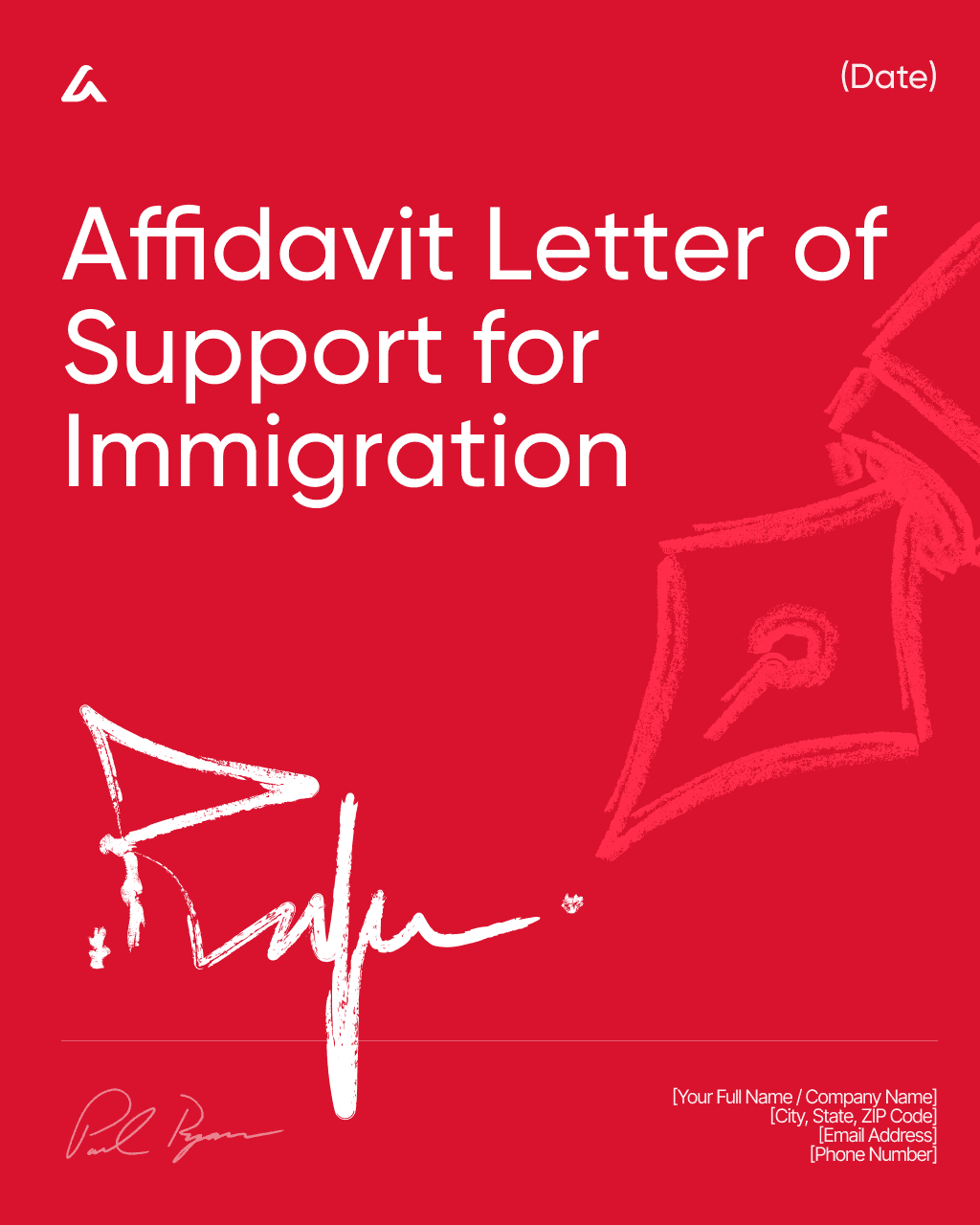
An Affidavit Letter of Support for Immigration is a sworn statement written to support an individual’s immigration application, petition, or case by providing evidence of their character, relationship history, financial stability, or overall suitability for immigration benefits. This type of affidavit is commonly used in family-based immigration cases, marriage-based petitions, asylum or humanitarian applications, and adjustment of status filings. Its purpose is to give immigration authorities credible, firsthand testimony from someone who personally knows the applicant and can affirm important facts relevant to their case.
Using a standardized Affidavit Letter of Support for Immigration template ensures that all legally relevant elements are included—such as the affiant’s identity, immigration status, relationship to the applicant, length of acquaintance, specific observations supporting the applicant’s good moral character or relationship validity, and factual examples that strengthen the case. The template may also include required affidavit language, a sworn declaration under penalty of perjury, notary acknowledgment, and any supporting documents referenced by the affiant. AI-powered tools like AI Lawyer help users create clear, detailed, and well-structured immigration affidavits that comply with USCIS expectations and provide strong, credible support for the applicant’s petition. This results in a persuasive and professionally formatted affidavit that enhances the overall strength of the immigration case.
Download Template: Affidavit Letter of Support for Immigration Template
For more information please refer to our article: U.S. Immigration Forms and Documents: Complete Guide
Or create your own document yourself with the help of AI.
1.51 USCIS Denial Appeal Letter Template
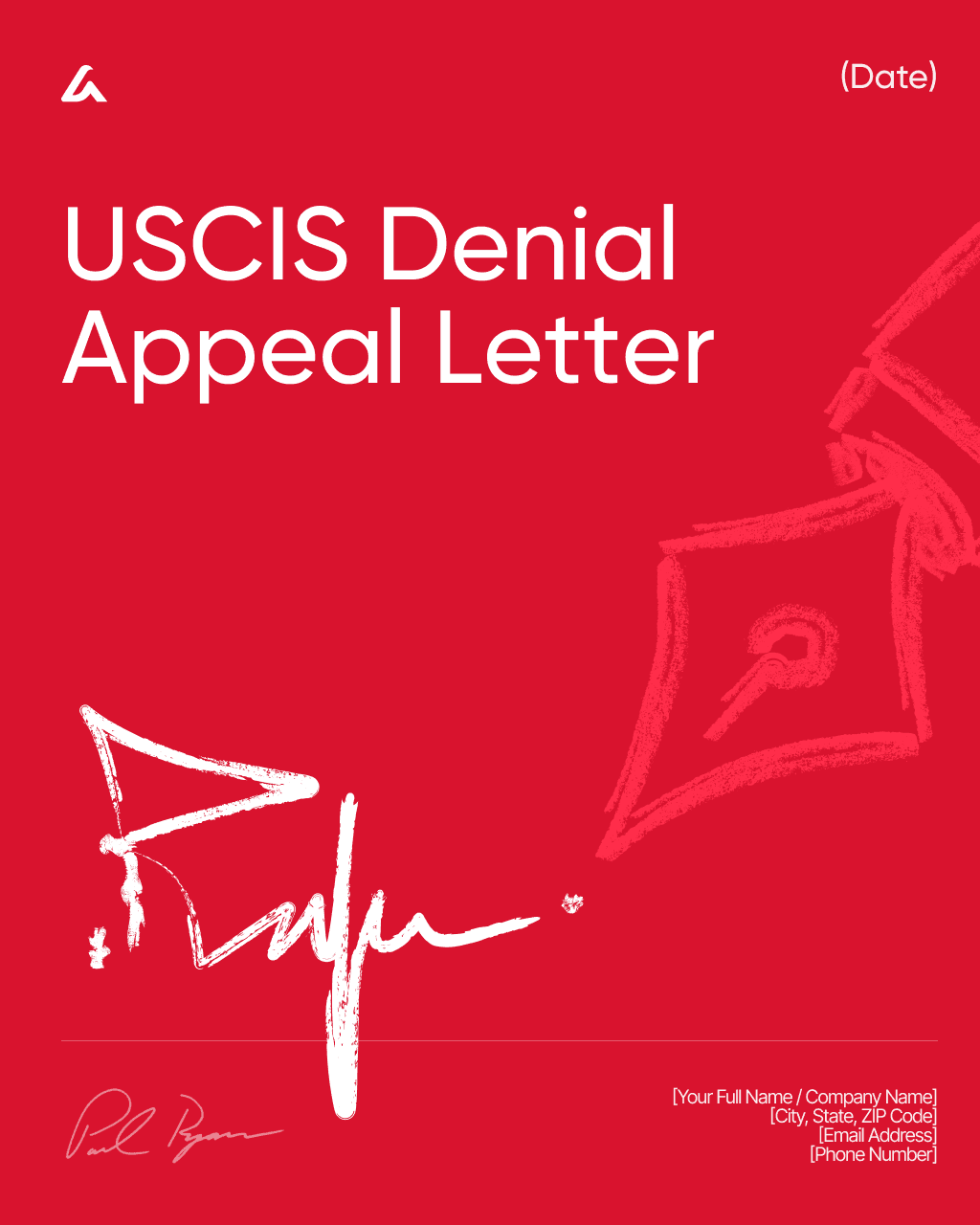
A USCIS Denial Appeal Letter is a formal written request submitted when an applicant wishes to challenge a denial issued by U.S. Citizenship and Immigration Services. This letter is typically used when filing an appeal to the Administrative Appeals Office (AAO), the Board of Immigration Appeals (BIA), or when submitting a Motion to Reopen or Motion to Reconsider (Form I-290B). Its purpose is to explain why the denial was incorrect, present new evidence or clarify existing information, and demonstrate that the applicant meets all legal requirements for the immigration benefit sought.
Using a standardized USCIS Denial Appeal Letter template ensures that all critical elements are included—such as the case receipt number, form type, date of the denial notice, specific reasons USCIS cited for denying the application, and a point-by-point rebuttal supported by law, regulations, or evidence. The template may also include space for presenting new documentation, citing relevant statutes, correcting factual misunderstandings, and explaining how the original application satisfies eligibility criteria. AI-powered tools like AI Lawyer help applicants create clear, well-organized, and legally grounded appeal letters that strengthen the argument for reconsideration and improve the chances of a favorable outcome. This results in a professional, compelling submission that aligns with USCIS standards and supports overturning the denial.
Download Template: USCIS Denial Appeal Letter Template
For more information please refer to our article: U.S. Immigration Forms and Documents: Complete Guide
Or create your own document yourself with the help of AI.
1.52 Bona Fide Marriage Letter Template

A Bona Fide Marriage Letter is a written statement used to support a marriage-based immigration petition by demonstrating that the couple’s relationship is genuine, not entered into for immigration benefits. USCIS often requires strong evidence of a real marital relationship in applications such as Form I-130, Form I-485, or removal of conditions on residence (Form I-751). The letter is typically written by a friend, family member, employer, religious leader, or anyone who knows the couple well. Its purpose is to provide credible third-party testimony confirming the authenticity, history, and day-to-day reality of the marriage.
Using a standardized Bona Fide Marriage Letter template ensures that all key elements are included—such as the writer’s identity and relationship to the couple, how long they have known them, specific examples of interactions with the spouses, observations about their relationship dynamics, shared activities, major life events, and reasons the writer believes the marriage is legitimate. The template may also include a sworn declaration under penalty of perjury, optional notarization fields, and references to supporting evidence (photos, gatherings, travel, communications). AI-powered tools like AI Lawyer help generate clear, credible, and USCIS-compliant letters that meet evidentiary expectations and strengthen the couple’s immigration case by providing detailed, authentic personal testimony.
Download Template: Bona Fide Marriage Letter Template
For more information please refer to our article: U.S. Immigration Forms and Documents: Complete Guide
Or create your own document yourself with the help of AI.
1.53 USCIS Cover Letter Template

A USCIS Cover Letter is a professional document submitted at the front of an immigration application package to clearly outline what is being filed, list included forms and evidence, and help USCIS officers quickly understand the purpose and contents of the submission. Although not required, a well-structured cover letter significantly improves the organization of the case, reduces processing errors, and ensures that the officer can easily navigate the supporting documentation. This type of letter is commonly used for applications such as Form I-130, I-485, I-765, I-131, I-751, N-400, and many others.
Using a standardized USCIS Cover Letter template ensures that all essential elements are included—such as the applicant’s name and identifying information, the form(s) being submitted, a checklist of enclosed evidence, receipt numbers for related cases, and a brief statement of the request being made. The template may also include notes clarifying special circumstances, explanations for missing documents, translation certifications, or cross-references to additional filings. AI-powered tools like AI Lawyer help applicants generate clear, organized, and USCIS-compliant cover letters that make application packages more professional and easier to review. This results in a polished submission that supports smoother processing and reduces the likelihood of delays or RFEs (Requests for Evidence).
Download Template: USCIS Cover Letter Template
For more information please refer to our article: U.S. Immigration Forms and Documents: Complete Guide
Or create your own document yourself with the help of AI.
1.54 Financial Support Letter for Immigration Template

A Financial Support Letter for Immigration is a formal written statement used to affirm that the applicant has financial backing from a sponsor who can help cover living expenses, avoid public charge concerns, or meet minimum income requirements for certain immigration benefits. This type of letter is often used alongside Form I-134 (Affidavit of Support), Form I-864, student visa applications, visitor visa applications, and humanitarian petitions. Its purpose is to demonstrate financial stability, provide assurance that the applicant will not become a financial burden, and strengthen the credibility of the immigration case.
Using a standardized Financial Support Letter for Immigration template ensures that all necessary details are clearly included—such as the sponsor’s identity, immigration status, income sources, employment details, relationship to the applicant, and a clear statement of financial responsibility. The template may also include supporting evidence references (tax returns, pay stubs, bank statements), explanation of how expenses will be covered, duration of support, and a declaration made under penalty of perjury. AI-powered tools like AI Lawyer help sponsors produce clear, professional, and USCIS-ready financial support letters that complement official forms and address common evidentiary concerns. This results in a strong, credible document that helps satisfy financial eligibility requirements and improve application success.
Download Template: Financial Support Letter for Immigration Template
For more information please refer to our article: U.S. Immigration Forms and Documents: Complete Guide
Or create your own document yourself with the help of AI.
1.55 Good Moral Character Letter for Immigration Template

A Good Moral Character Letter for Immigration is a formal written statement used to support an individual’s immigration petition by attesting to their honesty, integrity, responsibility, and overall positive character. USCIS may require proof of good moral character for applications such as naturalization (N-400), certain waivers, cancellation of removal, VAWA petitions, DACA renewals, and other immigration benefits. This letter is typically written by employers, community leaders, religious figures, teachers, landlords, friends, or family members who know the applicant well. Its purpose is to provide credible, firsthand testimony that the applicant consistently demonstrates lawful behavior and strong ethical values.
Using a standardized Good Moral Character Letter template ensures that all essential components are included—such as the writer’s identity and relationship to the applicant, length of acquaintance, specific examples of the applicant’s responsible behavior, community involvement, work ethic, volunteerism, kindness, and positive contributions. The template may also address the applicant’s absence of criminal activity, efforts toward rehabilitation (if applicable), and their overall suitability for immigration benefits. AI-powered tools like AI Lawyer help users create detailed, well-organized, and USCIS-compliant character letters that effectively highlight the applicant’s strengths and credibility. This results in a persuasive, professional document that strengthens the applicant’s case and supports a favorable immigration decision.
Download Template: Good Moral Character Letter for Immigration Template
For more information please refer to our article: U.S. Immigration Forms and Documents: Complete Guide
Or create your own document yourself with the help of AI.
1.56 Immigration Letter of Support for Marriage Template
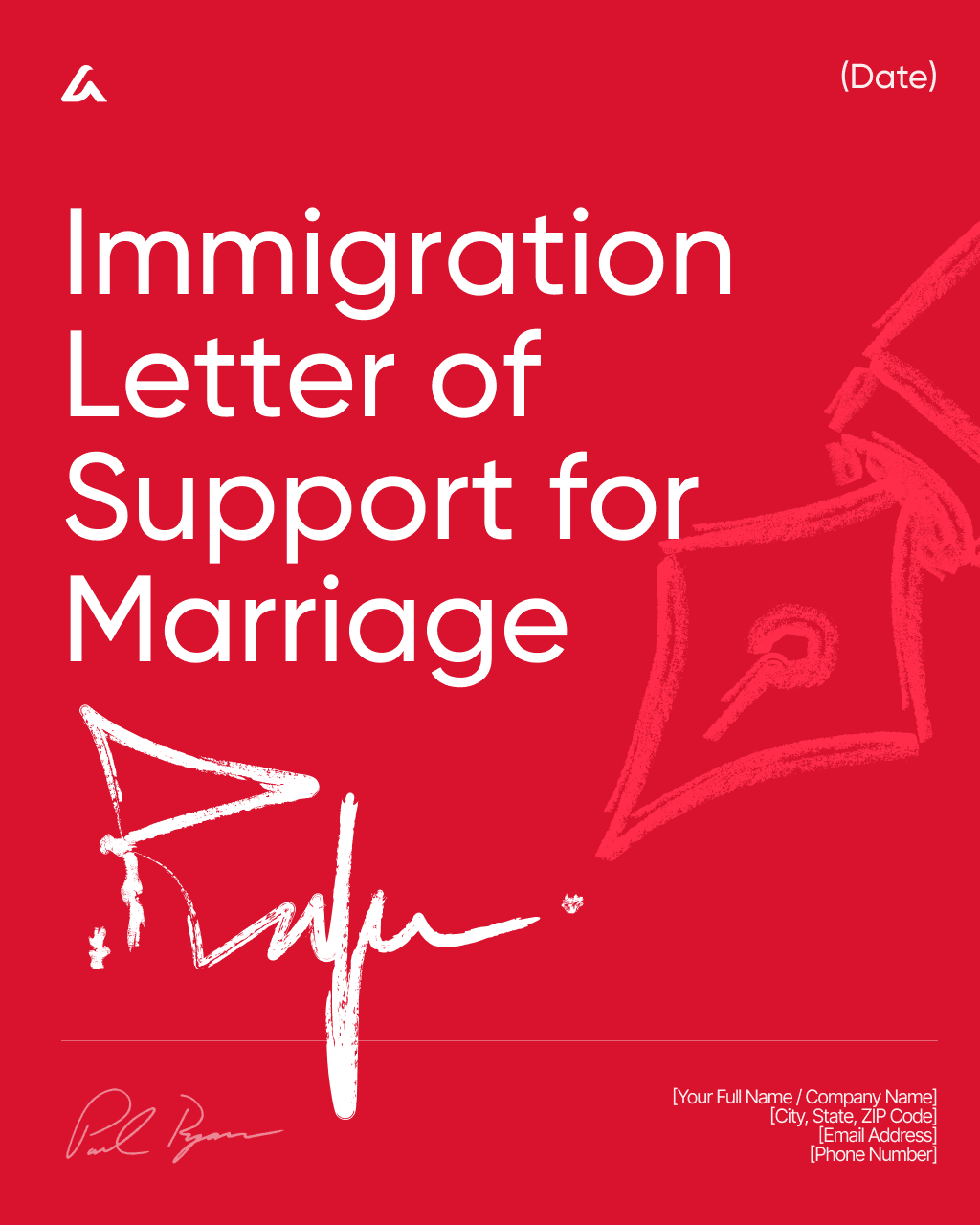
An Immigration Letter of Support for Marriage is a formal statement written by a friend, family member, colleague, or community member to help verify the authenticity of a couple’s marital relationship for immigration purposes. This letter is commonly used in marriage-based immigration filings such as Form I-130, Form I-485, or removal of conditions on residence (Form I-751). Its purpose is to provide credible third-party testimony confirming that the marriage is genuine, emotionally connected, and built on shared life experiences rather than entered into for immigration benefits.
Using a standardized Immigration Letter of Support for Marriage template ensures that all key information is clearly addressed—such as the writer’s full identity, relationship to the couple, length of acquaintance, and meaningful examples demonstrating firsthand knowledge of the couple’s relationship. This may include descriptions of time spent together, celebrations attended, personal observations of affection and commitment, shared responsibilities, and the couple’s long-term plans. The template may also incorporate a sworn declaration under penalty of perjury and optional notarization fields. AI-powered tools like AI Lawyer help users generate clear, detailed, and USCIS-compliant letters that strengthen the overall immigration petition by providing persuasive and authentic testimony regarding the validity of the marriage.
Download Template: Immigration Letter of Support for Marriage Template
For more information please refer to our article: U.S. Immigration Forms and Documents: Complete Guide
Or create your own document yourself with the help of AI.
1.57 Hardship Letter for Immigration Template
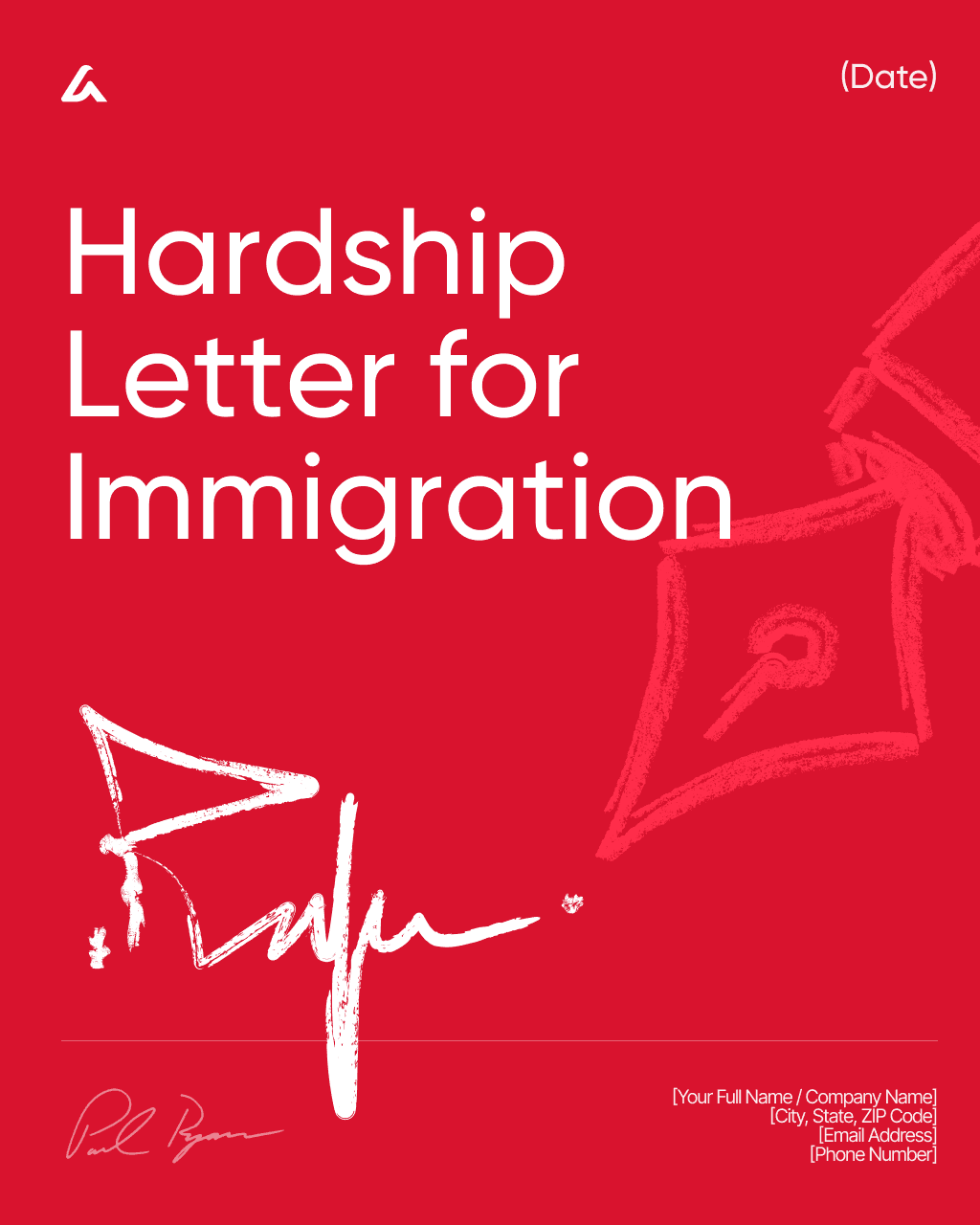
A Hardship Letter for Immigration is a formal written statement used to explain the significant emotional, financial, medical, or family-related difficulties that a U.S. citizen or lawful permanent resident would suffer if their spouse, parent, or child were denied an immigration benefit or removed from the United States. This type of letter is commonly required for I-601 and I-601A waivers, cancellation of removal cases, VAWA-related waivers, and certain humanitarian applications. Its purpose is to clearly demonstrate “extreme hardship,” a high legal threshold that must be supported with detailed, specific, and credible evidence.
Using a standardized Hardship Letter for Immigration template ensures that all critical hardship factors are thoroughly covered—such as medical conditions requiring specialized care, financial dependence or support obligations, psychological or emotional impacts, educational disruptions for children, safety concerns abroad, country conditions, loss of community ties, and the applicant’s essential role within the family. The template may also include sections for personal background, supporting documentation references (medical records, psychological evaluations, financial statements), and a sworn declaration under penalty of perjury. AI-powered tools like AI Lawyer help applicants craft clear, detailed, and USCIS-ready hardship letters that effectively organize facts, highlight strong evidence, and present compelling arguments that meet legal standards. This results in a persuasive and professionally structured submission that strengthens the overall waiver or relief application.
Download Template: Hardship Letter for Immigration Template
For more information please refer to our article: U.S. Immigration Forms and Documents: Complete Guide
Or create your own document yourself with the help of AI.
1.58 Letter of Support for Asylum Applicant Template
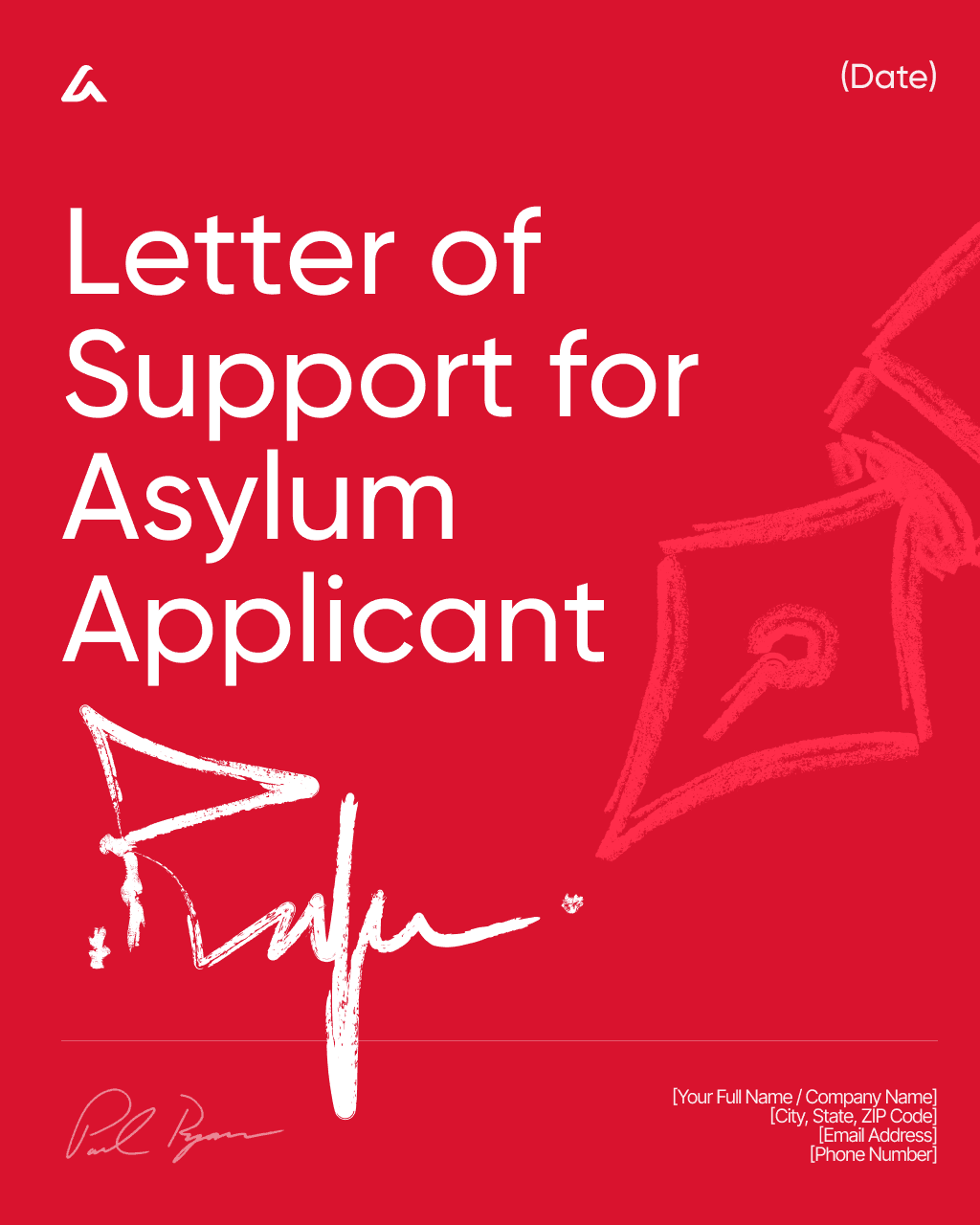
A Letter of Support for an Asylum Applicant is a formal written statement provided by a friend, family member, community member, employer, mentor, religious leader, or other credible individual who can affirm important details about the applicant’s character, history, or the dangers they face in their home country. This type of letter is commonly submitted with an asylum application (Form I-589) or during asylum interviews, immigration court hearings, or appeals. Its purpose is to strengthen the applicant’s claim by providing third-party corroboration that supports the applicant’s fear of persecution, personal background, trauma history, or commitment to rebuilding their life safely in the United States.
Using a standardized Letter of Support for Asylum Applicant template ensures that all crucial elements are included—such as the writer’s identity and relationship to the applicant, length of acquaintance, firsthand knowledge of the applicant’s experiences, character, or vulnerabilities, and any observations of trauma, fear, or threats related to the applicant’s situation. The template may also address conditions in the applicant’s home country, specific reasons the applicant cannot safely return, and relevant personal qualities such as honesty, work ethic, or community involvement. Most versions include a sworn declaration under penalty of perjury and optional notarization to enhance credibility. AI-powered tools like AI Lawyer help users create clear, detailed, and professionally structured asylum support letters that align with USCIS and immigration court expectations, resulting in a compelling and credible document that reinforces the applicant’s asylum claim.
Download Template: Letter of Support for Asylum Applicant Template
For more information please refer to our article: U.S. Immigration Forms and Documents: Complete Guide
Or create your own document yourself with the help of AI.
1.59 Family or Friend Letter of Support for Immigration Template
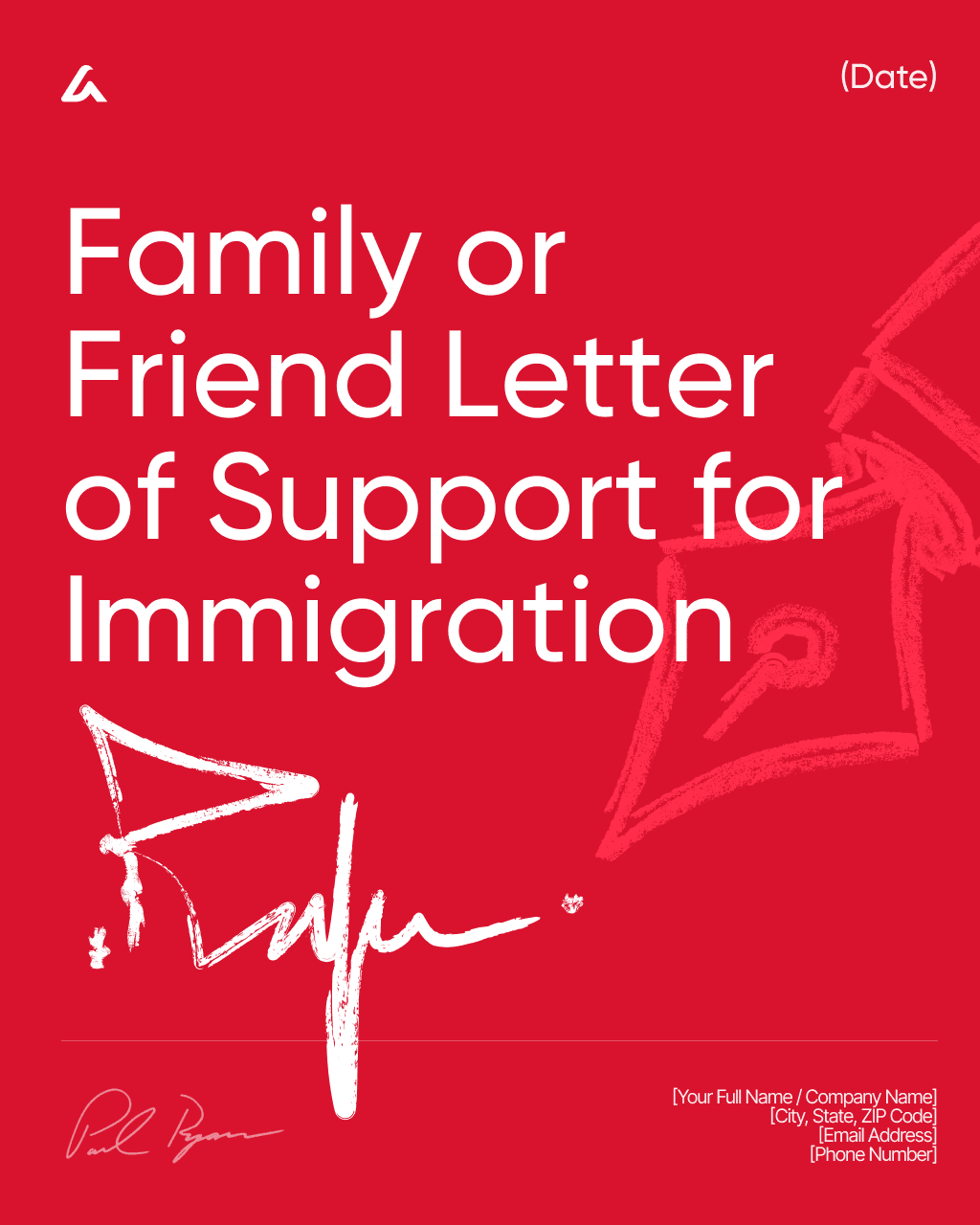
A Family or Friend Letter of Support for Immigration is a personal statement written by someone who knows the immigration applicant well and can offer credible testimony about their character, background, relationship history, or overall suitability for an immigration benefit. This type of letter is often used in family-based petitions, marriage-based cases, naturalization applications, humanitarian cases, and removal-of-conditions filings. Its purpose is to provide USCIS or immigration courts with authentic, firsthand insight into the applicant’s integrity, moral character, community ties, or the legitimacy of a relationship.
Using a standardized Family or Friend Letter of Support template ensures that all key details are clearly included—such as the writer’s full identity, relationship to the applicant, length of acquaintance, and specific examples demonstrating the applicant’s good character, responsibility, contributions to family or community, or genuine marital relationship (if applicable). The template may also include a sworn declaration under penalty of perjury, references to supporting evidence, and optional notarization fields to increase credibility. AI-powered tools like AI Lawyer help users generate well-organized, detailed, and USCIS-compliant support letters that effectively strengthen the applicant’s immigration case through clear, credible, and meaningful personal testimony.
Download Template: Family or Friend Letter of Support for Immigration Template
For more information please refer to our article: U.S. Immigration Forms and Documents: Complete Guide
Or create your own document yourself with the help of AI.
1.60 Letter to Congressman for Immigration Case Template

A Letter to a Congressman for an Immigration Case is a formal request for assistance submitted to a U.S. Representative or Senator when an immigration application is delayed, denied, or experiencing complications with USCIS, the National Visa Center (NVC), a U.S. embassy/consulate, or other immigration authorities. Congressional offices have dedicated caseworkers who can make official inquiries, request status updates, and help resolve administrative delays. While they cannot change the outcome of a case, congressional involvement often accelerates processing or clarifies issues that applicants cannot resolve on their own. The purpose of the letter is to explain the situation clearly, request intervention, and authorize the congressional office to communicate with immigration agencies on the applicant’s behalf.
Using a standardized Letter to Congressman for Immigration Case template ensures that all critical information is included—such as the applicant’s full name, date of birth, A-number, receipt numbers, type of immigration benefit requested, timeline of key events, reason for requesting assistance, and any hardships caused by delays or errors. The template may also include a signed privacy release form (required before congressional offices can act), a brief summary of supporting documentation, and a respectful explanation of what resolution or clarification is being sought. AI-powered tools like AI Lawyer help applicants craft clear, professional, and persuasive congressional assistance letters that present the case effectively and increase the likelihood of timely and helpful intervention.
Download Template: Letter to Congressman for Immigration Case Template
For more information please refer to our article: U.S. Immigration Forms and Documents: Complete Guide
Or create your own document yourself with the help of AI.
1.61 Explanation Letter for Unlawful Presence / Visa Overstay Template
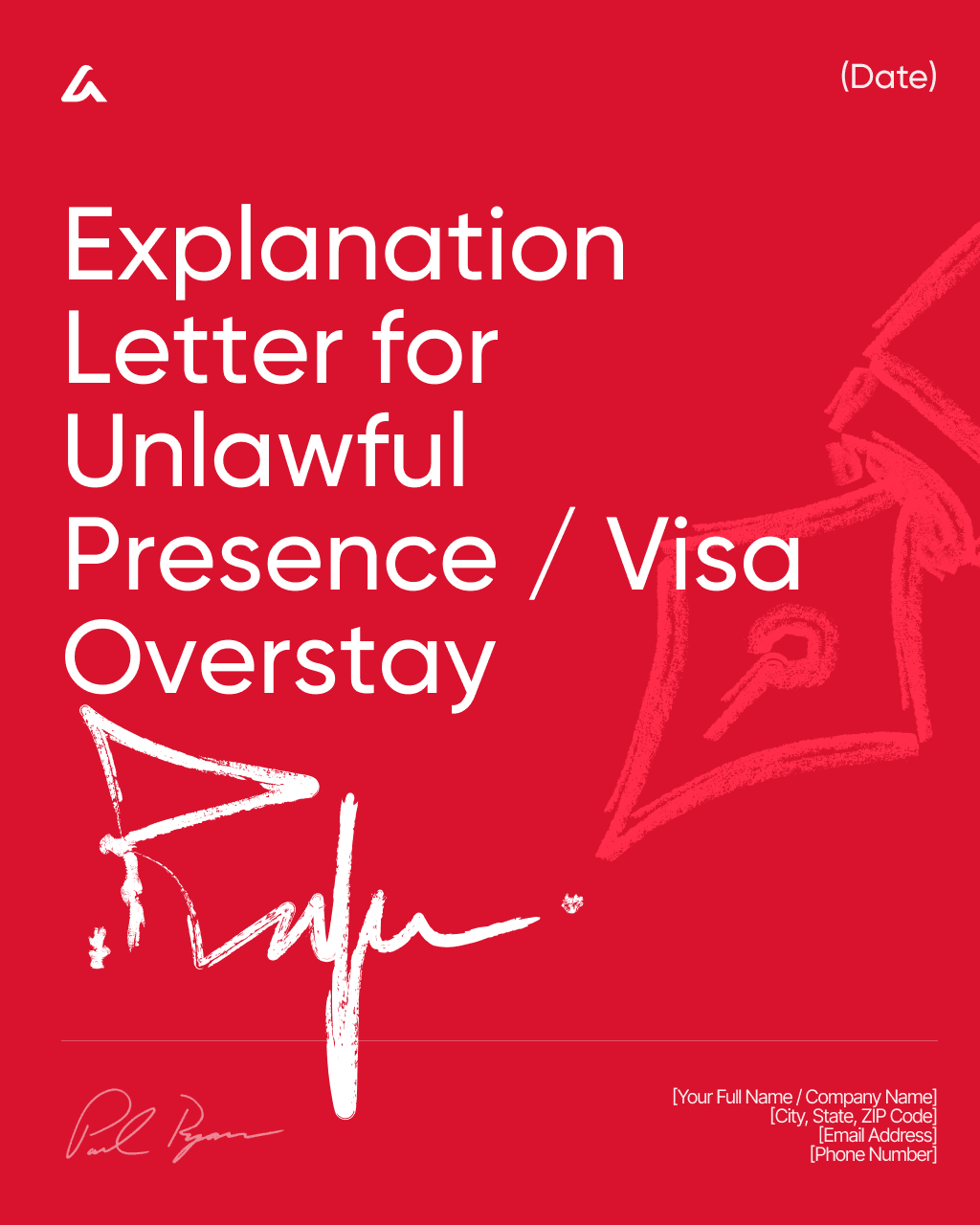
An Explanation Letter for Unlawful Presence or Visa Overstay is a formal written statement submitted to USCIS, a U.S. consulate, or an immigration court to clarify why an applicant remained in the United States beyond their authorized period of stay. This type of letter is often required for waiver applications (such as the I-601 or I-601A waiver), humanitarian cases, consular processing, adjustment of status filings, or responses to Requests for Evidence (RFEs). Its purpose is to explain the circumstances that led to the overstay, demonstrate good faith, and show eligibility for forgiveness or discretionary relief.
Using a standardized Explanation Letter for Unlawful Presence / Visa Overstay template ensures that all essential elements are addressed—such as the applicant’s immigration history, reasons for the overstay (e.g., medical issues, emergencies, misinformation, fear, trafficking, or extraordinary circumstances), acknowledgment of responsibility, supporting documentation, and evidence of good moral character. The template may also include sections explaining why the applicant poses no immigration risk, how they have complied with all other legal requirements, and why a waiver or favorable consideration should be granted. AI-powered tools like AI Lawyer help applicants create clear, honest, and USCIS-appropriate explanation letters that present facts respectfully and persuasively, resulting in a strong supporting document that improves the chances of approval.
Download Template: Explanation Letter for Unlawful Presence / Visa Overstay Template
For more information please refer to our article: U.S. Immigration Forms and Documents: Complete Guide
Or create your own document yourself with the help of AI.
1.62 I-129 Petition for a Nonimmigrant Worker Cover Letter Template
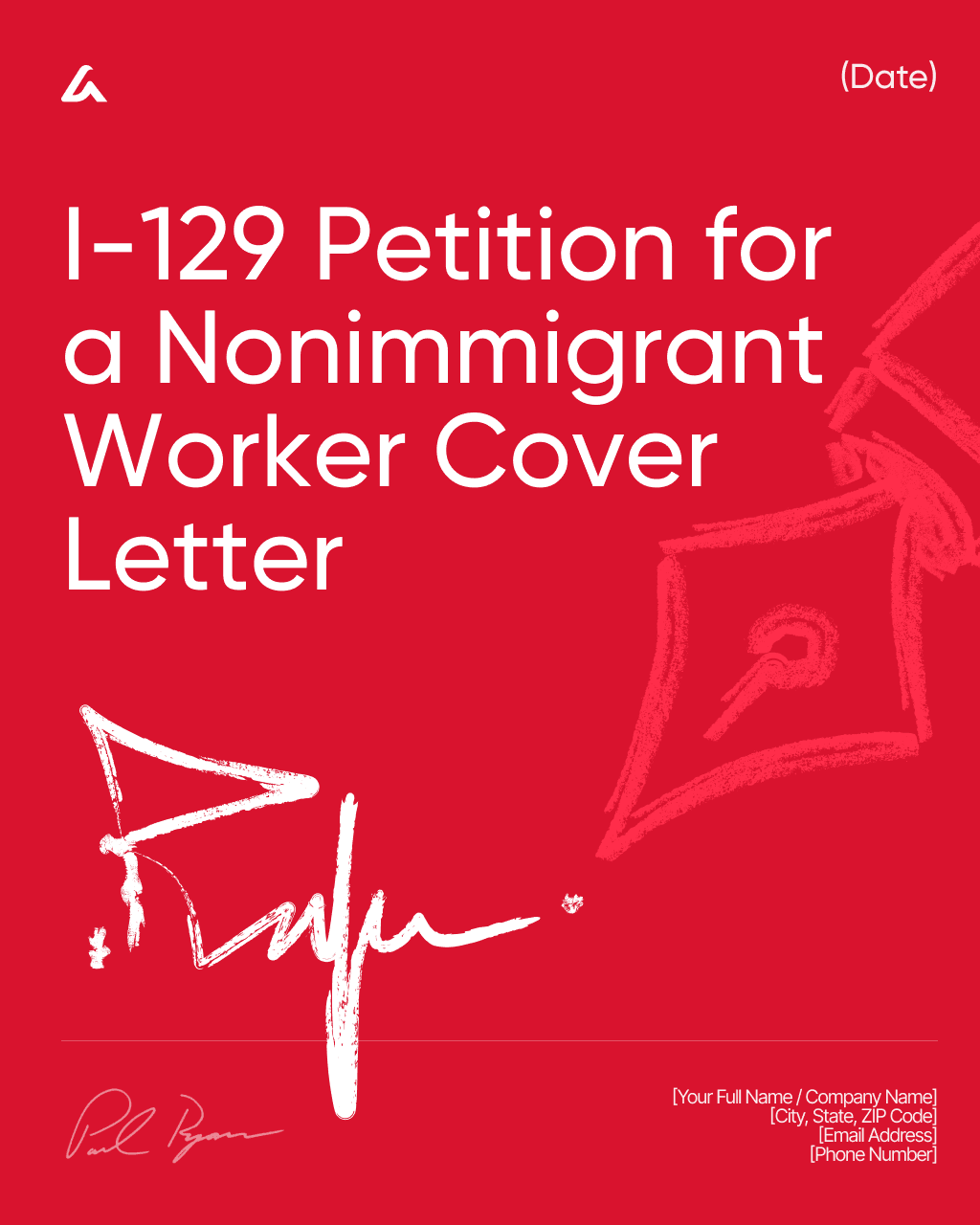
An I-129 Petition for a Nonimmigrant Worker Cover Letter is a professional summary document submitted at the front of an I-129 petition package to help USCIS officers quickly understand the purpose of the filing and the evidence included. It provides a clear overview of the visa category being requested (such as H-1B, L-1, O-1, P-1, TN, E-3, etc.), the employer’s information, the beneficiary’s qualifications, and the petition’s supporting documentation. Its purpose is to ensure the petition is well-organized, easy to review, and properly framed in terms of regulatory requirements.
Using a standardized I-129 Petition Cover Letter template ensures that all necessary components are clearly presented—such as the employer’s name and address, the beneficiary’s identifying information, the requested visa classification, job description summary, wage and worksite details, and a point-by-point explanation of how the petition meets USCIS eligibility criteria. The template may also include a detailed exhibit list, references to regulatory citations, explanations of the beneficiary’s credentials, and descriptions of supporting documents such as contracts, itineraries, academic degrees, expert letters, and corporate statements. AI-powered tools like AI Lawyer help employers, HR professionals, and attorneys create polished, well-structured, and USCIS-compliant cover letters that improve petition clarity, reduce RFEs, and support efficient reviewing by USCIS adjudicators. This results in a professional and legally grounded introduction that strengthens the overall I-129 petition.
Download Template: I-129 Petition for a Nonimmigrant Worker Cover Letter Template
For more information please refer to our article: U.S. Immigration Forms and Documents: Complete Guide
Or create your own document yourself with the help of AI.
1.63 I-129F Petition for Alien Fiancé(e) Cover Letter Template
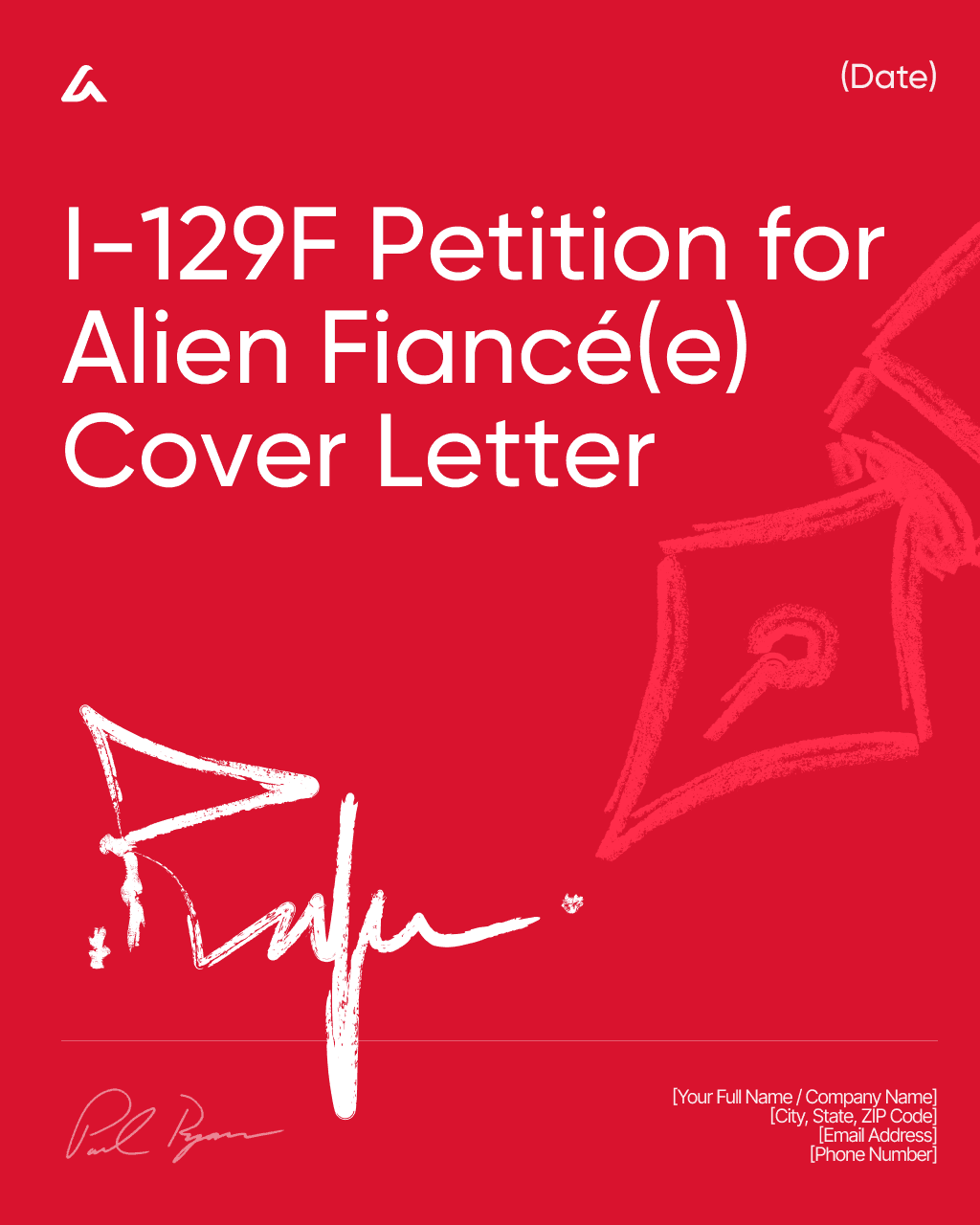
An I-129F Petition for Alien Fiancé(e) Cover Letter is a professional summary document submitted at the front of a K-1 fiancé(e) visa petition package. It helps USCIS quickly understand what the petitioner is requesting, who the beneficiary is, and what evidence is included to prove a bona fide relationship. Although not required by USCIS, a well-structured cover letter improves organization, reduces the chance of misplacement of documents, and helps officers navigate the petition more efficiently. Its purpose is to introduce the filing, list all enclosed forms and supporting exhibits, and clearly reference eligibility requirements under U.S. immigration law.
Using a standardized I-129F Petition for Alien Fiancé(e) Cover Letter template ensures that all essential components are properly included—such as petitioner and beneficiary information, the nature of the relationship, proof of having met in person within the required timeframe, intent to marry within 90 days of entry, and a detailed exhibit list referencing supporting documents. The template may also include explanations for any special circumstances, clarifications of missing documentation, translations, or additional notes that USCIS may need for review. AI-powered tools like AI Lawyer help petitioners generate clear, organized, and USCIS-compliant cover letters that present the relationship evidence persuasively and professionally. This results in a polished submission that enhances clarity, supports efficient processing, and strengthens the overall I-129F petition.
Download Template: I-129F Petition for Alien Fiancé(e) Cover Letter Template
For more information please refer to our article: U.S. Immigration Forms and Documents: Complete Guide
Or create your own document yourself with the help of AI.
1.64 USCIS Expedite Request Letter Template

A USCIS Expedite Request Letter is a formal written request asking U.S. Citizenship and Immigration Services to accelerate the processing of a pending application or petition. Expedite requests are granted only under specific, limited criteria—such as severe financial loss, urgent humanitarian reasons, emergency situations, nonprofit interests, government interests, or clear USCIS error. This letter is typically submitted through a congressional office, the USCIS Contact Center, or as part of an online service request. Its purpose is to clearly explain why the case meets USCIS expedite standards and to support the request with compelling evidence.
Using a standardized USCIS Expedite Request Letter template ensures that the request is complete, well-organized, and aligned with USCIS policy. The template includes essential elements such as the applicant’s identifying information, receipt number, form type, a brief case history, and a concise explanation of why an expedite is warranted. It may also provide structured sections for describing financial hardship, medical emergencies, humanitarian concerns, nonprofit work, or other qualifying categories. Supporting documentation (such as medical records, employer letters, contracts, financial statements, or evidence of government interest) is typically referenced and attached. AI-powered tools like AI Lawyer help applicants craft strong, professional, and USCIS-appropriate expedite request letters that clearly address eligibility, present evidence effectively, and increase the likelihood of a favorable response.
Download Template: USCIS Expedite Request Letter Template
For more information please refer to our article: U.S. Immigration Forms and Documents: Complete Guide
Or create your own document yourself with the help of AI.
1.65 Relationship Letter for Immigration Interview Template
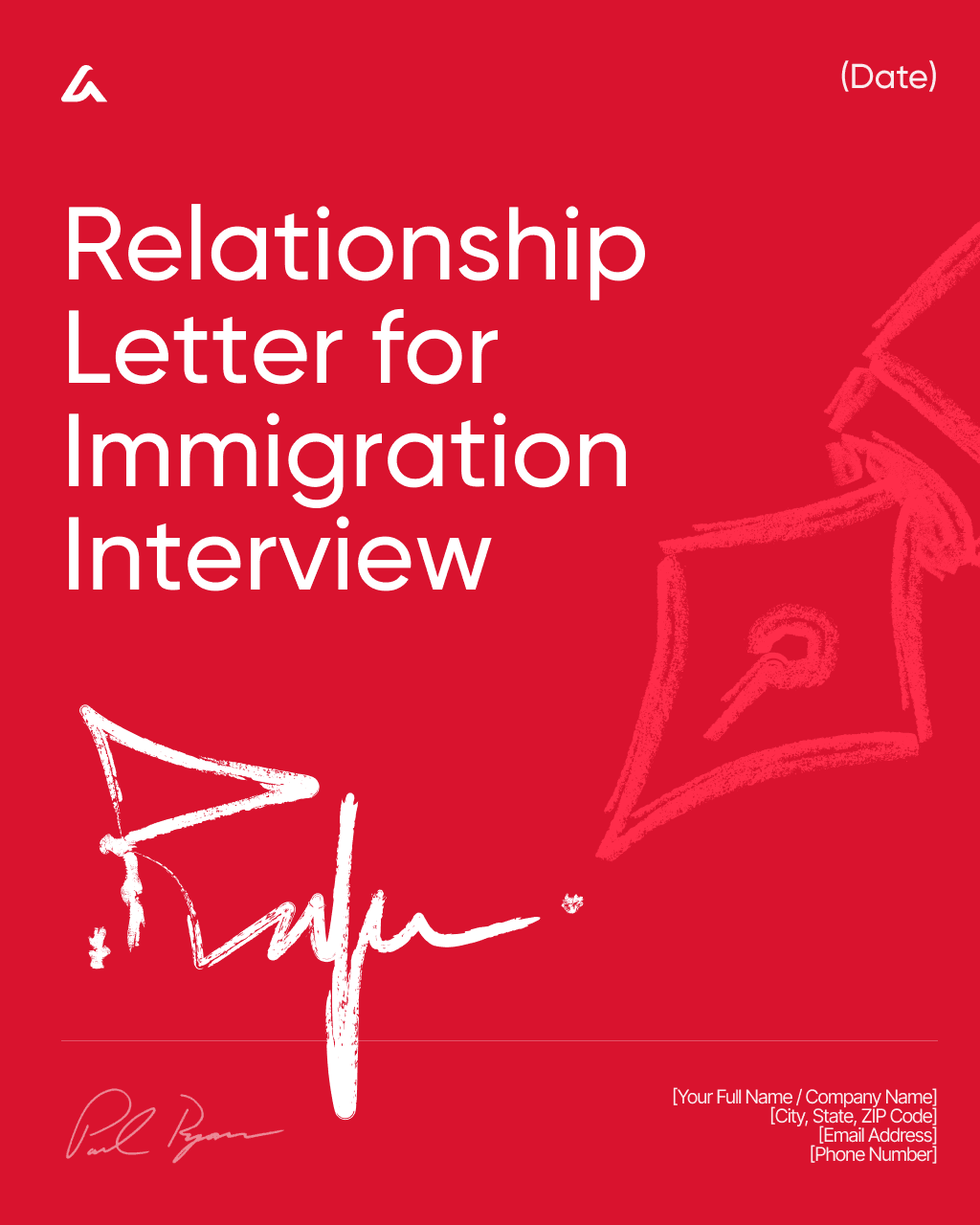
A Relationship Letter for an Immigration Interview is a formal written statement used to support a marriage-based or fiancé(e)-based immigration case by demonstrating the authenticity and history of the couple’s relationship. This letter is often submitted during marriage-based green card interviews, K-1 visa processing, or removal of conditions (Form I-751). Its purpose is to help USCIS or consular officers understand the genuine nature of the relationship, corroborate details provided during the interview, and demonstrate ongoing commitment between the partners.
Using a standardized Relationship Letter for Immigration Interview template ensures that all important elements are addressed—such as how and when the couple met, key milestones in the relationship, shared responsibilities, daily routines, family involvement, emotional connection, and long-term plans. The template may also include space for describing cultural or religious ceremonies, cohabitation details, financial interdependence, joint travel, and personal anecdotes that illustrate a real partnership. AI-powered tools like AI Lawyer help applicants create clear, well-organized, and persuasive relationship letters that are consistent with USCIS expectations and interview questions. This results in a credible and supportive document that strengthens the overall marriage-based immigration case.
Download Template: Relationship Letter for Immigration Interview Template
For more information please refer to our article: U.S. Immigration Forms and Documents: Complete Guide
Or create your own document yourself with the help of AI.
1.66 Withdraw Petition Letter for Immigration Template
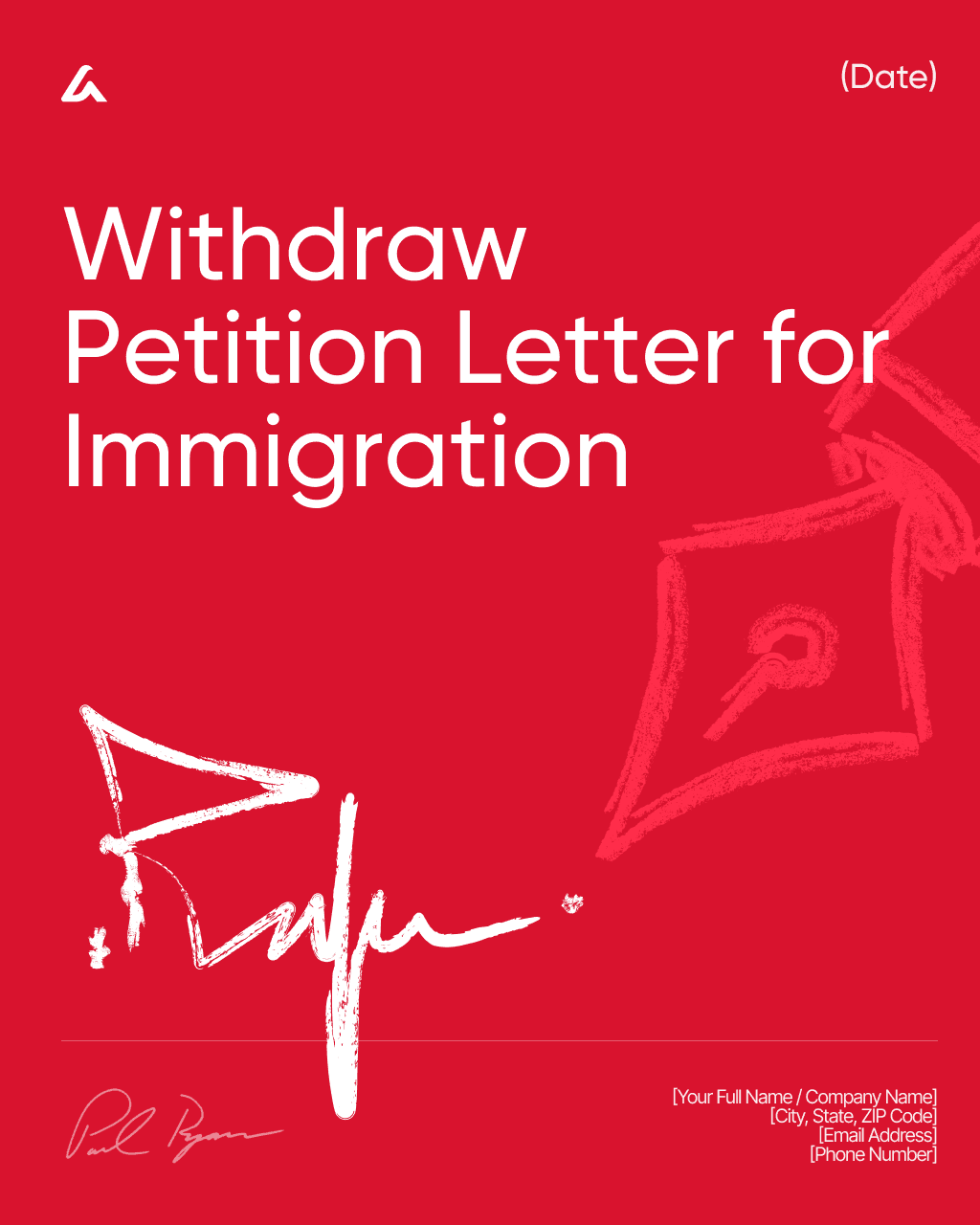
A Withdraw Petition Letter for Immigration is a formal written request submitted to USCIS, the National Visa Center (NVC), or a U.S. embassy/consulate to voluntarily withdraw a pending immigration petition or application. This letter is typically used when a petitioner no longer wishes to proceed with the case—for example, in marriage-based petitions after separation, employment-based petitions no longer needed by the employer, or duplicate filings submitted by mistake. Its purpose is to clearly notify immigration authorities that the petitioner is canceling the request and to prevent further processing, interviews, or visa issuance based on that petition.
Using a standardized Withdraw Petition Letter template ensures that all necessary information is included—such as the petitioner’s identifying details, the beneficiary’s information, the type of petition filed, the receipt number, and the reason for withdrawal. The template may also include a statement confirming that the withdrawal is voluntary, acknowledgment that USCIS fees are nonrefundable, and a request for written confirmation of the withdrawal. AI-powered tools like AI Lawyer help users create clear, professional, and USCIS-appropriate withdrawal letters that avoid processing confusion, close cases cleanly, and ensure accurate immigration records. This results in an effective and properly formatted request that immigration authorities can act on without delay.
Download Template: Withdraw Petition Letter for Immigration Template
For more information please refer to our article: U.S. Immigration Forms and Documents: Complete Guide
Or create your own document yourself with the help of AI.
1.67 I-130 Petition for Alien Relative Cover Letter Template
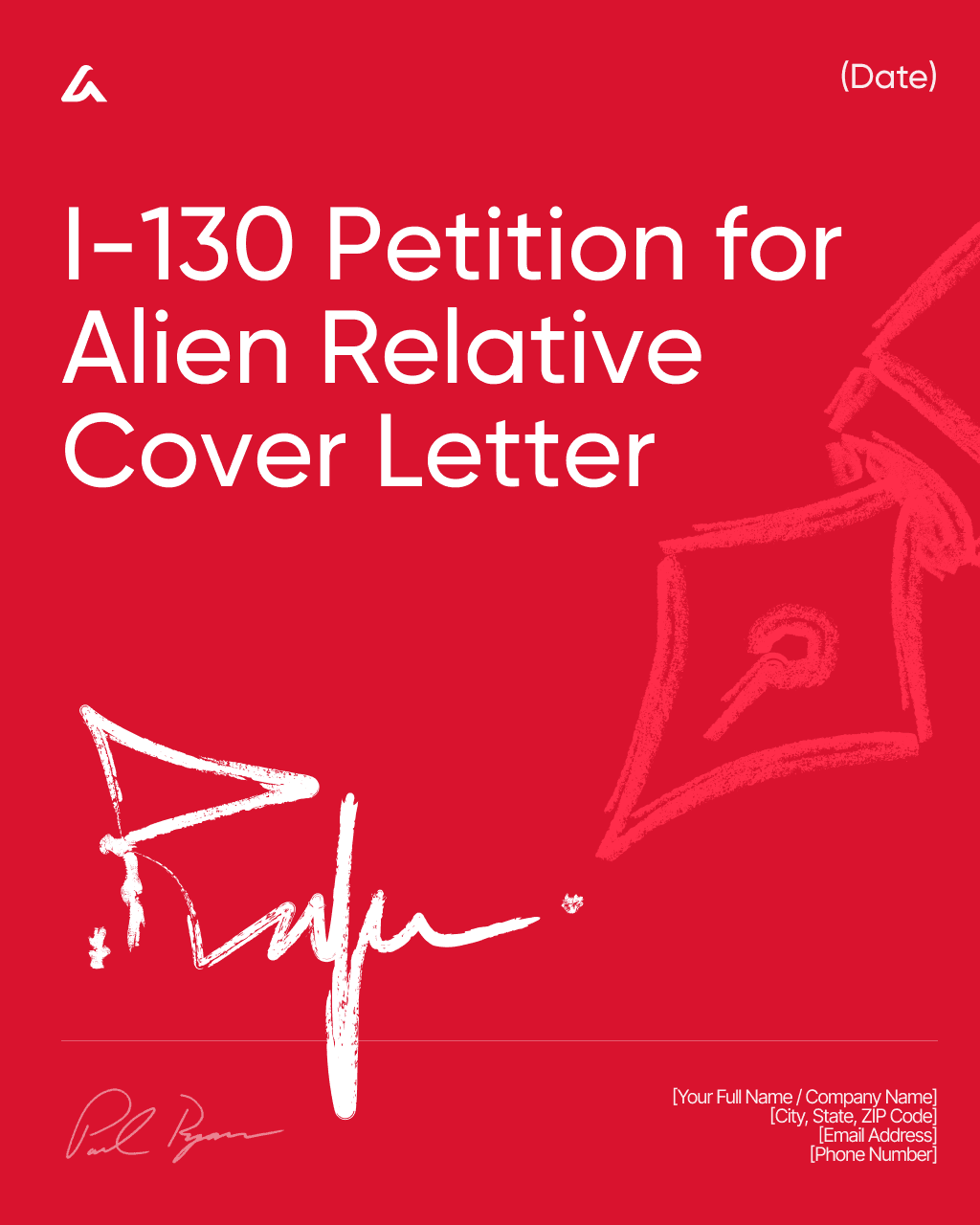
An I-130 Petition for Alien Relative Cover Letter is a professional summary document placed at the front of an I-130 petition package to help USCIS officers quickly understand the relationship being claimed, the purpose of the filing, and the evidence included. While not required by USCIS, a well-prepared cover letter improves clarity, reduces confusion, and helps ensure that the officer can easily navigate the documents. This type of cover letter is commonly used for spousal petitions, parent–child petitions, and other qualifying family relationships.
Using a standardized I-130 Petition for Alien Relative Cover Letter template ensures that all essential components are included—such as the petitioner’s and beneficiary’s full identifying information, the nature of the relationship, receipt numbers for related applications (if any), and a clear, organized exhibit list of all supporting evidence (marriage certificates, birth certificates, passports, photos, joint financial records, etc.). The template may also contain brief explanations of any unusual circumstances, translations submitted, clarifications regarding name variations, or notes about prior filings. AI-powered tools like AI Lawyer help petitioners create clean, structured, and USCIS-compliant cover letters that professionally introduce the petition, support efficient review, and reduce the likelihood of errors or Requests for Evidence (RFEs).
Download Template: I-130 Petition for Alien Relative Cover Letter Template
For more information please refer to our article: U.S. Immigration Forms and Documents: Complete Guide
Or create your own document yourself with the help of AI.
1.68 I-130A Supplemental Information for Spouse Beneficiary Cover Letter Template
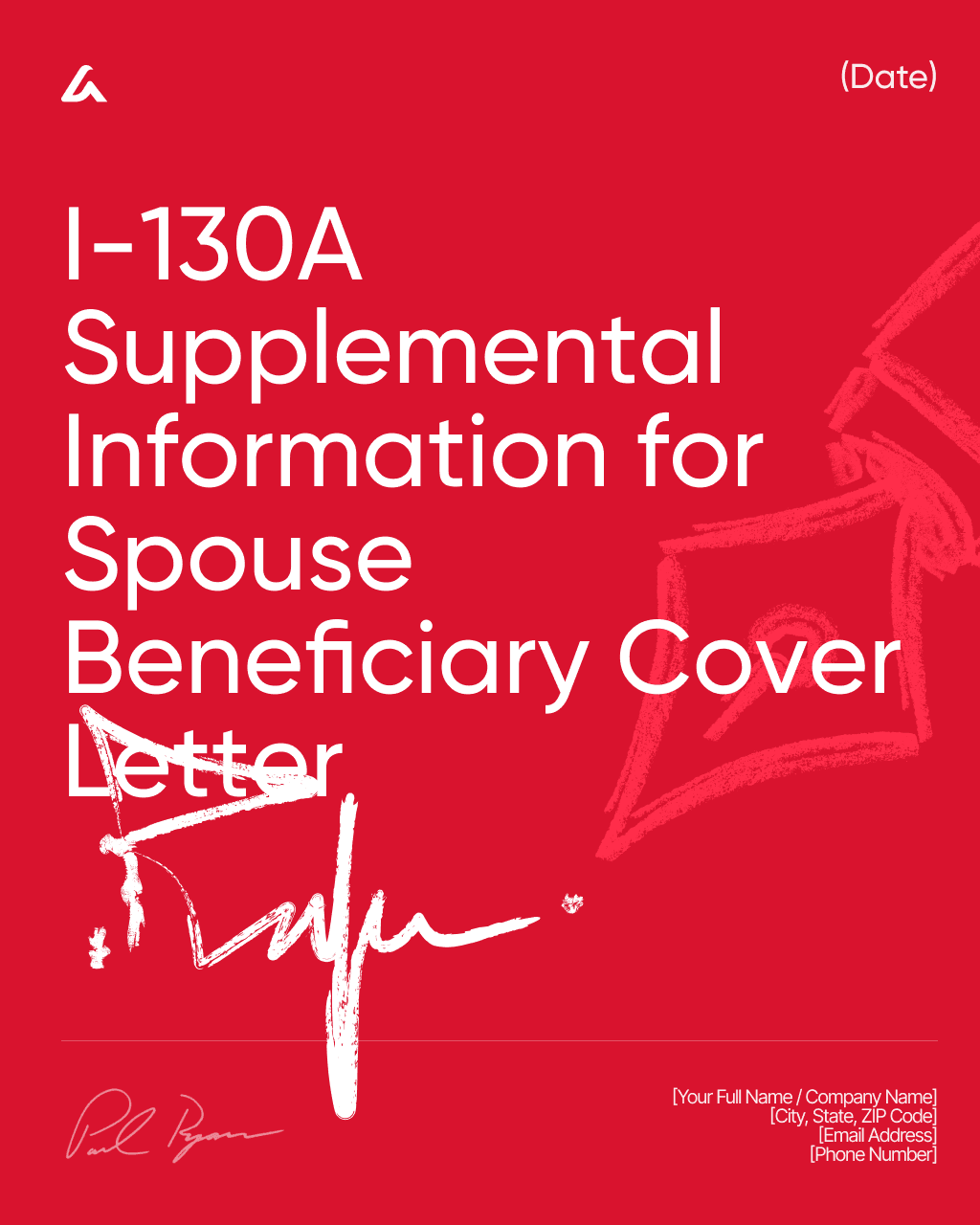
An I-130A Supplemental Information for Spouse Beneficiary Cover Letter is a professional document submitted along with Form I-130A to help USCIS clearly understand the beneficiary’s background information and the purpose of the filing. Although not required, this cover letter helps organize the packet, reduces confusion, and ensures that the officer can easily verify that all required documents are included. It is commonly used in marriage-based green card applications when the beneficiary is a spouse residing either inside or outside the United States.
Using a standardized I-130A Cover Letter template ensures that all important elements are properly addressed—such as the beneficiary’s identifying details, the petitioner’s information, the relationship to the petitioner, and a concise description of what forms and evidence are enclosed. The template may also include clarifications about names, addresses, missing information, prior marriages, or any special circumstances that USCIS should be aware of. AI-powered tools like AI Lawyer help create clear, well-organized, and USCIS-compliant cover letters that present the supplemental information professionally and improve the efficiency of case review. This results in a polished submission that strengthens the overall I-130/I-130A petition package and minimizes the likelihood of delays or RFEs.
Download Template: I-130A Supplemental Information for Spouse Beneficiary Cover Letter Template
For more information please refer to our article: U.S. Immigration Forms and Documents: Complete Guide
Or create your own document yourself with the help of AI.
1.69 I-131 Application for Travel Document (Advance Parole) Cover Letter Template
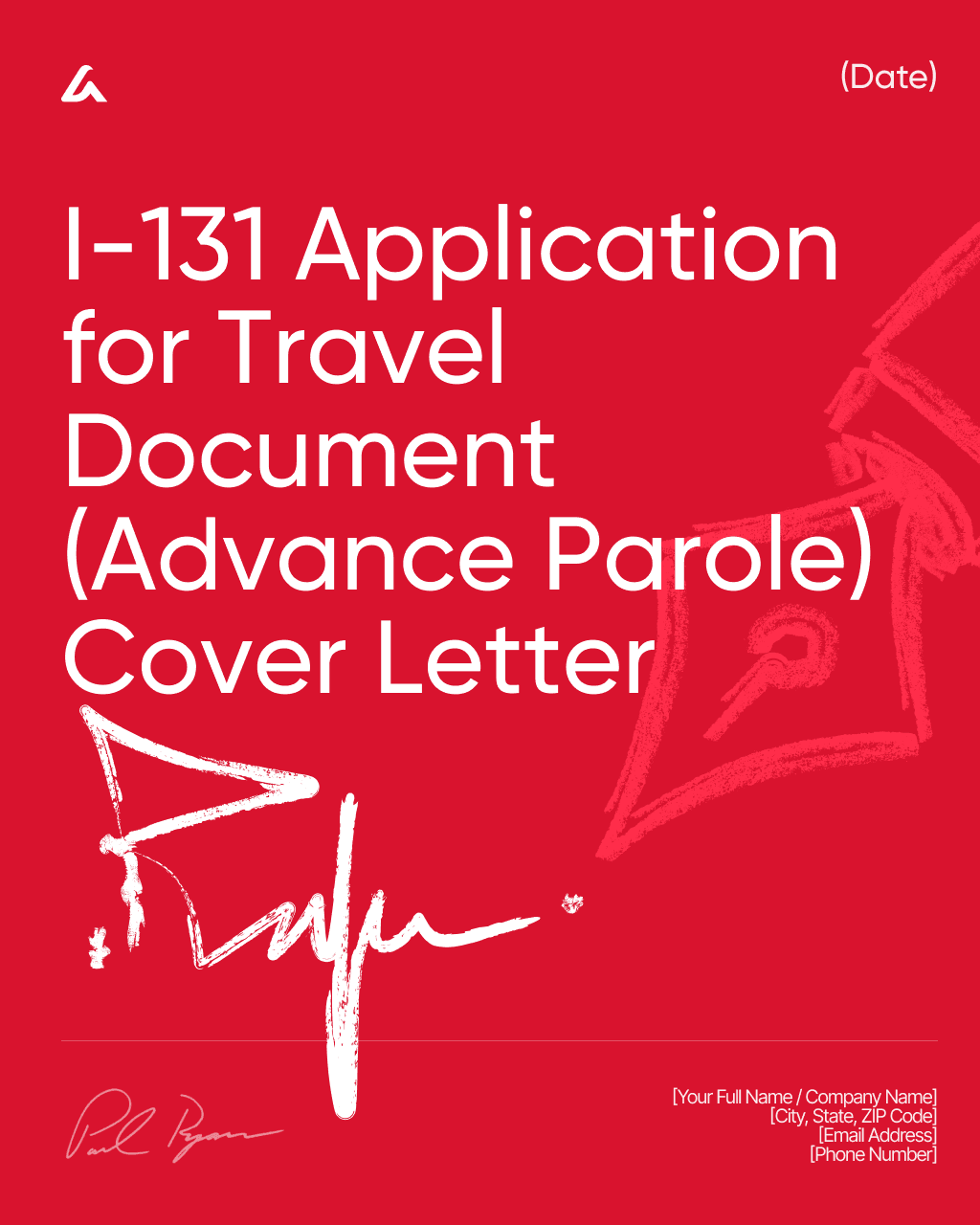
An I-131 Application for Travel Document (Advance Parole) Cover Letter is a professional document placed at the front of an Advance Parole application package to help USCIS understand the purpose of the request and identify the supporting evidence included. Although a cover letter is not required, it greatly improves organization, clarifies the reason for travel, and reduces the likelihood of errors or delays in processing. This type of cover letter is commonly used by individuals with pending Form I-485 applications, DACA recipients, asylum applicants, and others eligible for Advance Parole.
Using a standardized I-131 Cover Letter template ensures that all essential details are provided—such as the applicant’s identifying information, the basis of eligibility for Advance Parole, the specific purpose of travel, expected travel dates, and a clear list of enclosed evidence (passport copy, I-485 receipt, supporting documents for humanitarian, employment, or educational travel, etc.). The template may also include clarifications of special circumstances, explanations for urgent requests, or references to attached translations and supporting statements. AI-powered tools like AI Lawyer help applicants generate organized, professional, and USCIS-compliant cover letters that enhance clarity, streamline officer review, and support a smooth and timely Advance Parole approval process.
Download Template: I-131 Application for Travel Document (Advance Parole) Cover Letter Template
For more information please refer to our article: U.S. Immigration Forms and Documents: Complete Guide
Or create your own document yourself with the help of AI.
1.70 I-140 Immigrant Petition for Alien Worker Template
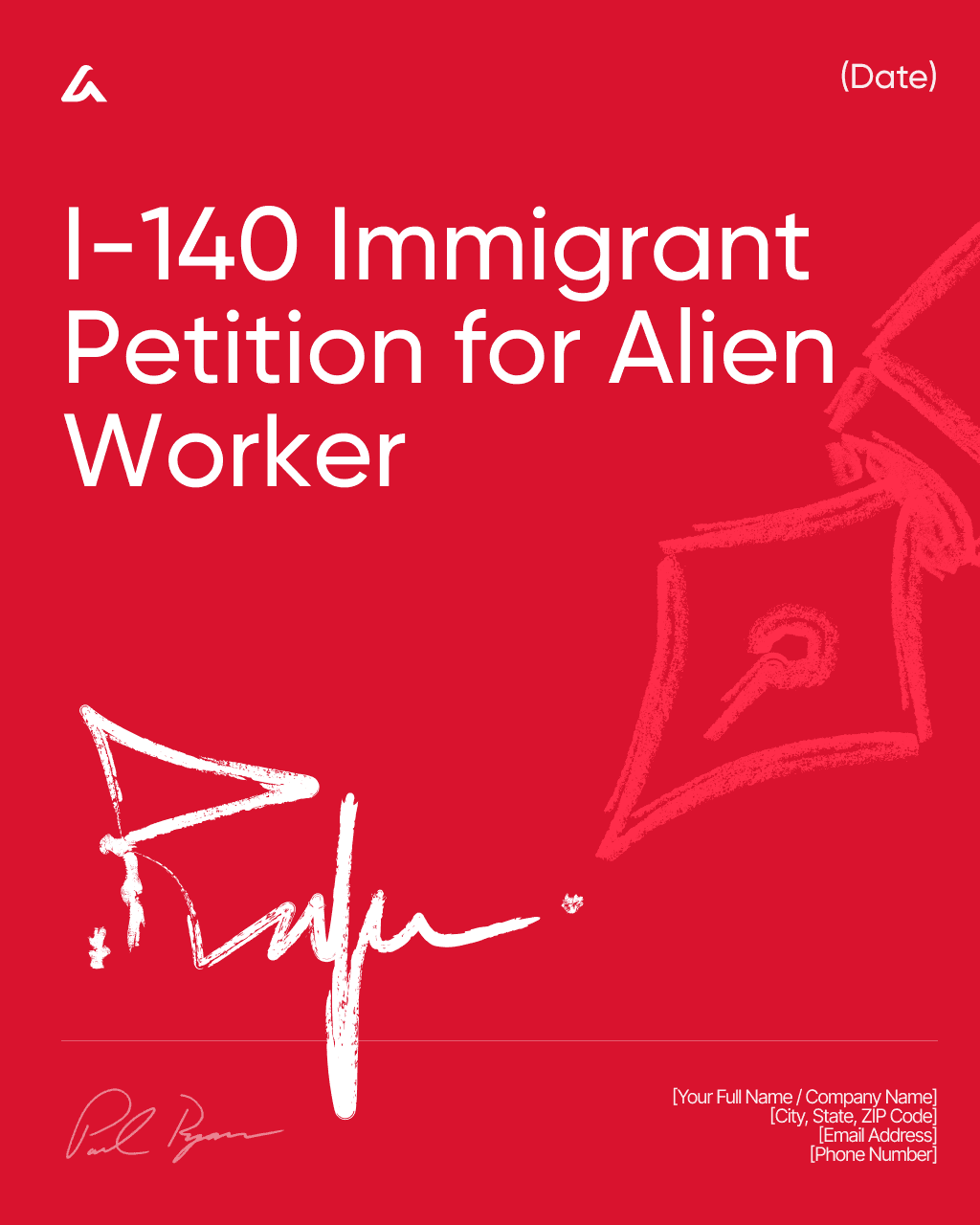
An I-140 Immigrant Petition for Alien Worker Template is a structured document used to prepare and organize the information necessary for filing Form I-140 with USCIS. This petition is submitted by a U.S. employer—or, in certain categories, by the individual applicant—to classify a worker as eligible for an employment-based immigrant visa (EB-1, EB-2, or EB-3). Its purpose is to clearly present the beneficiary’s qualifications, the employer’s eligibility, and the legal basis under which the immigrant classification is requested.
Using a standardized I-140 Petition Template ensures that all required components are properly included—such as the employer's business details, job offer information, labor certification status (if applicable), and evidence of the beneficiary’s education, experience, extraordinary achievements, or specialized skills. The template may also provide structure for attaching academic degrees, professional evaluations, letters of experience, publications, citations, business necessity justifications, expert opinion letters, and proof of the employer’s ability to pay the proffered wage. AI-powered tools like AI Lawyer help employers and applicants generate clear, organized, and USCIS-compliant I-140 petition packages that align with regulatory requirements, reduce errors, and strengthen the overall presentation of eligibility. This results in a professional and compelling submission that supports efficient case review and improves the likelihood of approval.
Download Template: I-131 Application for Travel Document (Advance Parole) Cover Letter Template
For more information please refer to our article: U.S. Immigration Forms and Documents: Complete Guide
Or create your own document yourself with the help of AI.
1.71 I-212 Application for Permission to Reapply for Admission After Deportation or Removal Template
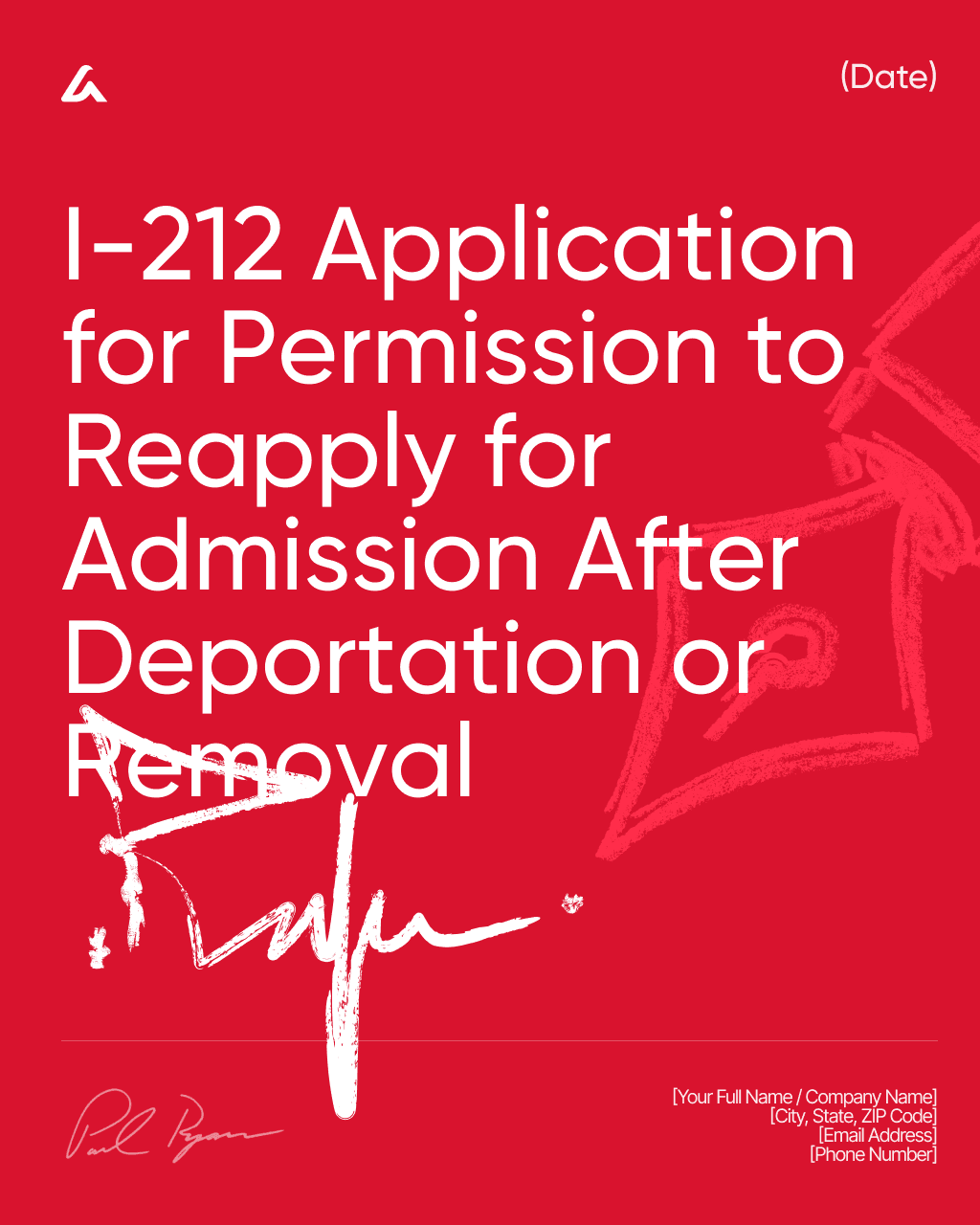
An I-212 Application for Permission to Reapply for Admission After Deportation or Removal Template is a structured document designed to help applicants prepare the information and supporting explanation required when requesting permission to return to the United States after having been removed, deported, or departing under certain bars of inadmissibility. Form I-212 is often submitted alongside waivers (such as Form I-601) or as part of consular processing. Its purpose is to provide a clear, persuasive rationale for why the applicant should be granted legal permission to reapply before the mandatory waiting period expires.
Using a standardized I-212 Application Template ensures that all crucial elements are properly addressed—such as the applicant’s immigration history, circumstances surrounding removal or deportation, ties to the United States, family hardship, evidence of rehabilitation, good moral character, compliance with prior immigration orders, and reasons the applicant does not pose a risk to public safety or immigration integrity. The template may also include structured sections for presenting supporting evidence such as marriage certificates, medical documents, financial records, psychological evaluations, proof of rehabilitation, and character reference letters. AI-powered tools like AI Lawyer help applicants prepare clear, well-organized, and legally grounded I-212 applications that comply with USCIS and consular requirements, resulting in a compelling submission that improves the likelihood of approval.
Download Template: I-212 Application for Permission to Reapply for Admission After Deportation or Removal Template
For more information please refer to our article: U.S. Immigration Forms and Documents: Complete Guide
Or create your own document yourself with the help of AI.
1.72 I-485 Application to Register Permanent Residence or Adjust Status Template
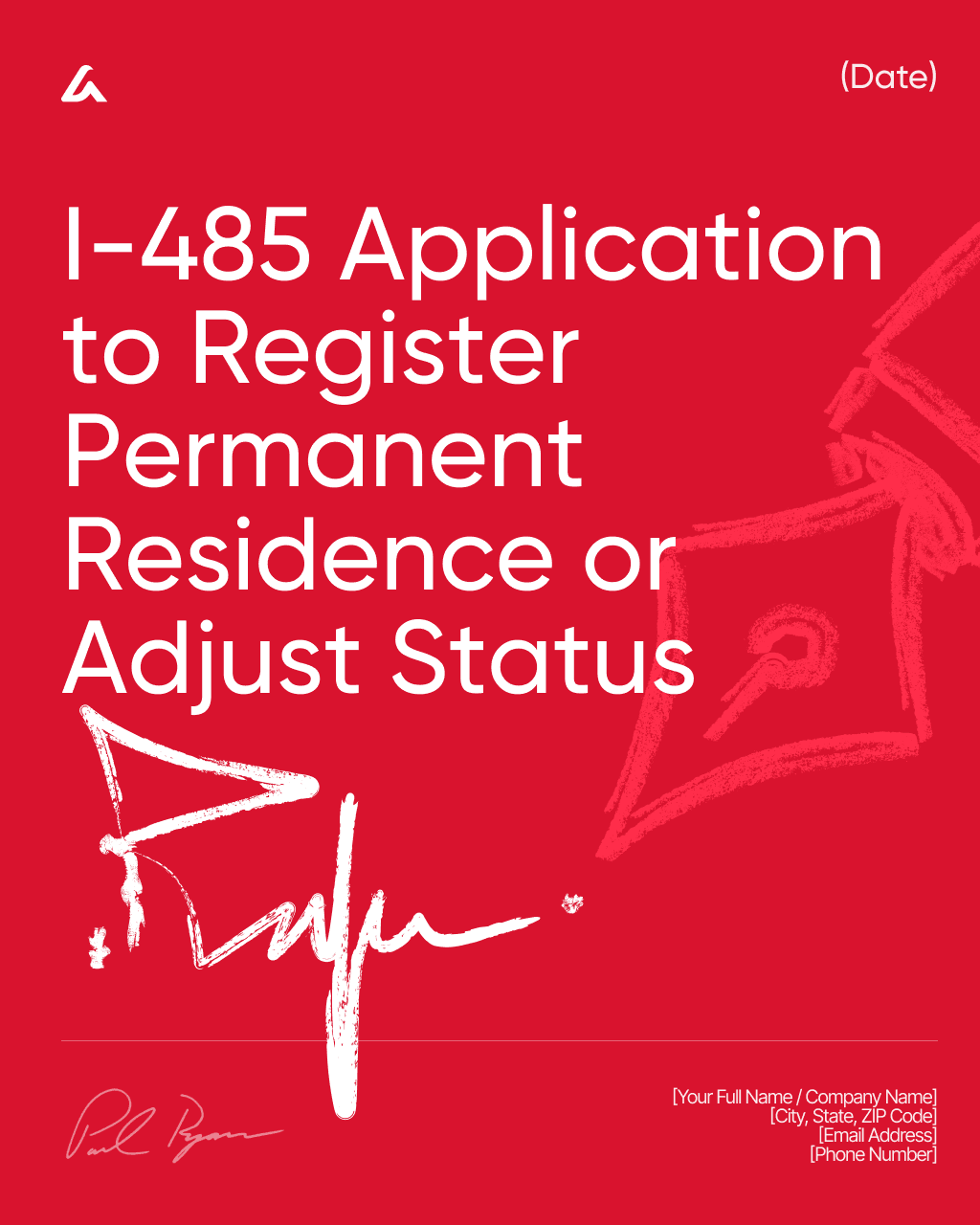
An I-485 Application to Register Permanent Residence or Adjust Status Template is a structured document designed to help applicants organize and prepare all required information and evidence needed for submitting Form I-485 to USCIS. This form is used by eligible individuals already in the United States to apply for a green card without having to leave the country. Its purpose is to clearly present biographical details, immigration history, eligibility category, supporting documents, and required affidavits so the application is complete, accurate, and aligned with USCIS standards.
Using a standardized I-485 Application Template ensures that all essential components are properly included—such as the basis of eligibility (family, employment, asylum, special immigrant, etc.), identity documents, medical exam requirements, financial sponsorship materials, prior immigration records, and evidence supporting admissibility. The template may also organize key items like birth certificates, marriage certificates, passport copies, I-94 records, prior visa documents, relationship evidence, employment records, and affidavits. It can include structured checklists, cover letter prompts, and guidance for assembling additional forms typically filed with the I-485 (such as I-864, I-765, or I-131). AI-powered tools like AI Lawyer help applicants create clear, complete, and USCIS-compliant adjustment-of-status packets, reducing errors, preventing delays, and improving the chances of smooth processing and approval.
Download Template: I-485 Application to Register Permanent Residence or Adjust Status Template
For more information please refer to our article: U.S. Immigration Forms and Documents: Complete Guide
Or create your own document yourself with the help of AI.
1.73 I-526 Immigrant Petition by Standalone Investor Template

An I-526 Immigrant Petition by Standalone Investor Template is a structured document designed to help EB-5 immigrant investors organize and present all required information when filing Form I-526 with USCIS. This form is used by individuals who invest in a new commercial enterprise (NCE) or targeted employment area (TEA) outside of a regional center framework. Its purpose is to demonstrate that the investor has made a qualifying investment, that the capital was lawfully obtained, and that the investment will create at least 10 full-time U.S. jobs, as required under EB-5 regulations.
Using a standardized I-526 Petition Template ensures that all critical elements are properly included—such as detailed business information about the new commercial enterprise, organizational documents, investment structure, job creation plan, economic analysis, source-of-funds documentation, and evidence of the lawful origin of investment capital. The template may also include structured sections for bank transfers, tax returns, employment records, asset sales, loan agreements, business plans compliant with Matter of Ho, and documentation of the investor’s ownership interest. AI-powered tools like AI Lawyer help investors prepare clear, well-organized, and USCIS-compliant I-526 petitions that reduce errors, strengthen evidentiary presentation, and align with complex EB-5 immigration requirements. This results in a professionally structured submission that enhances petition credibility and supports efficient adjudication.
Download Template: I-526 Immigrant Petition by Standalone Investor Template
For more information please refer to our article: U.S. Immigration Forms and Documents: Complete Guide
Or create your own document yourself with the help of AI.
1.74 I-526E Immigrant Petition by Regional Center Investor Template
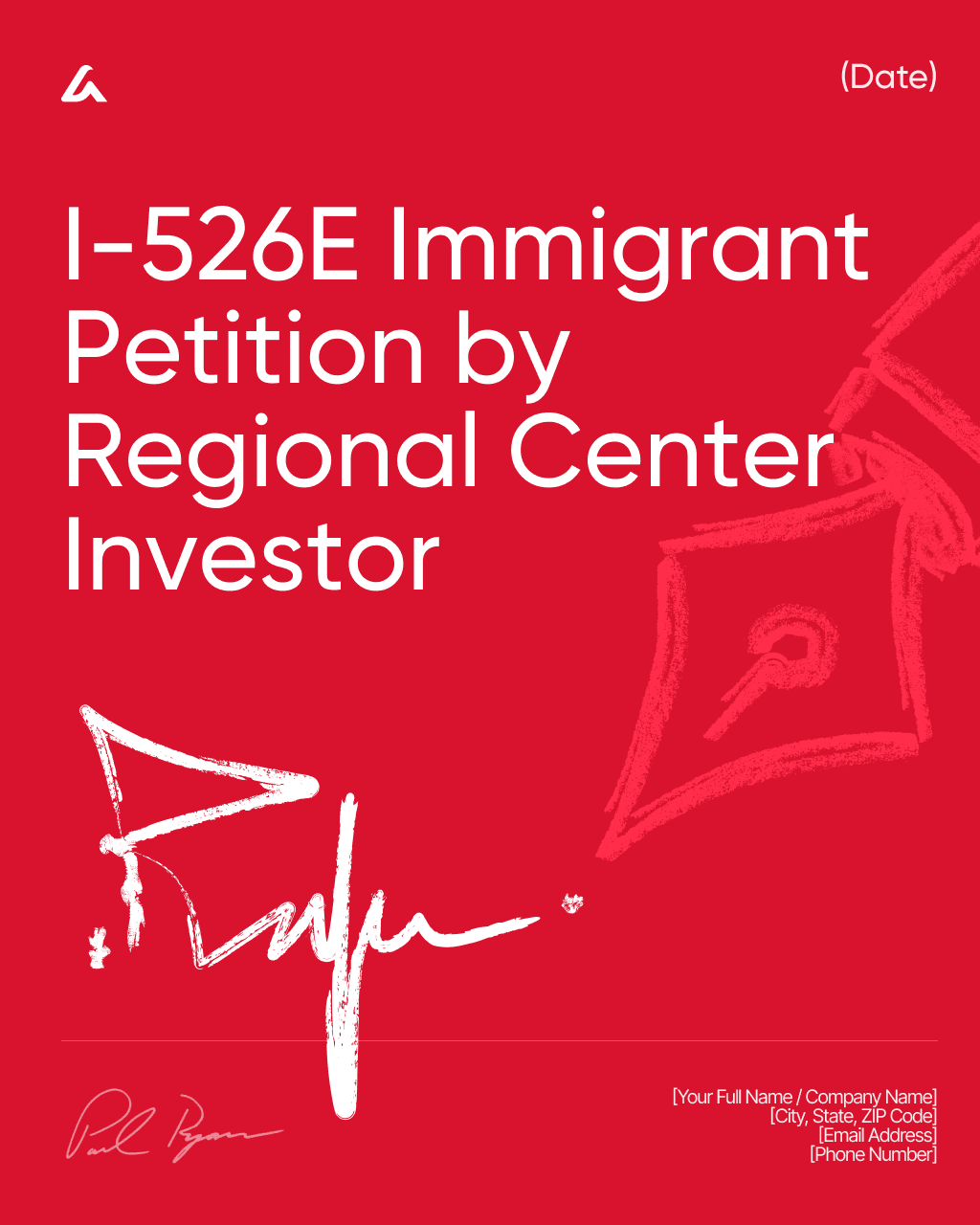
An I-526E Immigrant Petition by Regional Center Investor Template is a structured document designed to guide EB-5 investors who are filing Form I-526E through a USCIS-compliant presentation of their investment, eligibility, and supporting evidence. This form is used exclusively by investors participating in a USCIS-designated Regional Center project, where job creation is measured through economic modeling rather than direct hiring. Its purpose is to clearly demonstrate that the investor has made a qualifying investment, that the capital was lawfully sourced, and that the Regional Center project meets all statutory and regulatory EB-5 requirements.
Using a standardized I-526E Petition Template ensures that all essential components are properly organized—such as evidence of the investor’s capital contribution, documentation of the lawful source and path of funds, Regional Center affiliation, project offering documents, job creation analysis, and required disclosures under the EB-5 Reform and Integrity Act. The template may also include structured sections for presenting wire transfers, tax returns, business ownership records, loan agreements, escrow documentation, private placement memoranda (PPM), economic impact reports, and the investor’s subscription agreement. AI-powered tools like AI Lawyer help investors produce clear, professional, and USCIS-compliant petition packets that reduce errors, streamline evidence presentation, and improve adjudication clarity. This results in a strong, well-organized submission that enhances credibility and supports approval under the updated EB-5 regulatory framework.
Download Template: I-526E Immigrant Petition by Regional Center Investor Template
For more information please refer to our article: U.S. Immigration Forms and Documents: Complete Guide
Or create your own document yourself with the help of AI.
1.75 I-589 Application for Asylum and for Withholding of Removal Personal Statement Template

An I-589 Application for Asylum and for Withholding of Removal Personal Statement is a critical written narrative submitted alongside Form I-589 to explain, in detail, why the applicant fears returning to their home country. This personal statement is often the most important part of an asylum case. Its purpose is to provide a clear, chronological account of the applicant’s past persecution, threats, or trauma; the reasons they fear future harm; and how their experiences relate to a protected ground such as race, religion, nationality, political opinion, or membership in a particular social group.
Using a standardized I-589 Personal Statement template ensures that all essential elements are properly covered—such as the applicant’s background, the specific events of persecution, dates and locations, responsible actors, attempts to seek protection, ongoing threats, and why relocation within the home country is not possible. The template may also include sections that connect the harm suffered to the legal basis for asylum, describe psychological and emotional impacts, outline country conditions, and confirm that the statement is truthful under penalty of perjury. AI-powered tools like AI Lawyer help applicants create clear, structured, and USCIS-appropriate personal statements that are detailed, consistent, and aligned with asylum law requirements. This results in a compelling and credible narrative that strengthens the overall asylum application and supports a fair adjudication of the claim.
Download Template: I-589 Application for Asylum and for Withholding of Removal Personal Statement Template
For more information please refer to our article: U.S. Immigration Forms and Documents: Complete Guide
Or create your own document yourself with the help of AI.
1.76 I-601 Application for Waiver of Grounds of Inadmissibility Personal Statement Template

An I-601 Application for Waiver of Grounds of Inadmissibility Personal Statement is a detailed written explanation submitted with Form I-601 to address the specific immigration violations or inadmissibility issues that prevent an applicant from obtaining a visa, green card, or other immigration benefit. This personal statement is one of the most important components of the waiver request. Its purpose is to explain the circumstances that led to the inadmissibility, demonstrate remorse and accountability, and show why a favorable exercise of discretion is justified—most commonly by proving extreme hardship to a qualifying relative.
Using a standardized I-601 Personal Statement template ensures that all legally relevant elements are included—such as a clear explanation of the ground(s) of inadmissibility, the applicant’s personal background, the circumstances leading to the violation, evidence of rehabilitation or good moral character, and a detailed hardship analysis focused on the qualifying U.S. citizen or lawful permanent resident relative. The template may also incorporate sections on medical, financial, emotional, psychological, educational, and safety-related hardships, as well as supporting documentation and references to country conditions. A sworn declaration under penalty of perjury is typically included at the end of the statement. AI-powered tools like AI Lawyer help applicants produce thorough, organized, and USCIS-compliant personal statements that clearly address waiver criteria, strengthen the hardship argument, and present a compelling case for discretionary approval.
Download Template: I-601 Application for Waiver of Grounds of Inadmissibility Personal Statement Template
For more information please refer to our article: U.S. Immigration Forms and Documents: Complete Guide
Or create your own document yourself with the help of AI.
1.77 I-601A Application for Provisional Unlawful Presence Waiver Personal Statement Template

An I-601A Application for Provisional Unlawful Presence Waiver Personal Statement is a detailed written narrative submitted with Form I-601A to explain the circumstances surrounding an applicant’s unlawful presence in the United States and to demonstrate the extreme hardship their U.S. citizen or lawful permanent resident spouse or parent would suffer if the waiver is not granted. This personal statement is one of the most important components of the provisional waiver application, as it provides the emotional, factual, and contextual foundation for the hardship claim.
Using a standardized I-601A Personal Statement template ensures that all essential waiver-related elements are addressed—such as the applicant’s immigration history, explanation for the unlawful presence, acknowledgment of responsibility, and evidence of good moral character. The template also guides the applicant in presenting a thorough hardship analysis covering the qualifying relative’s medical needs, financial dependence, psychological or emotional hardship, family disruption, educational challenges, and country conditions that make relocation unsafe or impossible. It may also include sections for describing rehabilitation, family ties, community involvement, and long-term consequences of separation. A sworn declaration under penalty of perjury is typically included to reinforce credibility. AI-powered tools like AI Lawyer help applicants produce clear, organized, and USCIS-ready personal statements that meet the legal standard for “extreme hardship” and significantly strengthen the overall waiver submission.
Download Template: I-601A Application for Provisional Unlawful Presence Waiver Personal Statement Template
For more information please refer to our article: U.S. Immigration Forms and Documents: Complete Guide
Or create your own document yourself with the help of AI.
1.78 I-751 Petition to Remove Conditions on Residence Personal Statement Template

An I-751 Petition to Remove Conditions on Residence Personal Statement is a detailed written narrative submitted with Form I-751 to explain and document the authenticity of a marriage when removing the two-year conditional status from a green card holder. This personal statement is particularly important in cases filed jointly by the married couple, as well as in waiver cases (divorce waiver, abuse waiver, or extreme hardship waiver). Its purpose is to show USCIS that the marriage was entered into in good faith and not solely for immigration benefits.
Using a standardized I-751 Personal Statement template ensures that all key elements are included—such as how the couple met, major milestones in the relationship, shared responsibilities, financial interdependence, daily life routines, family involvement, and the emotional bond between the spouses. For waiver cases, the template may also include explanations of separation or divorce, evidence of domestic abuse, or hardship factors. It typically provides space to reference supporting documentation such as joint leases, bank accounts, tax returns, photos, travel records, and affidavits. A sworn declaration under penalty of perjury is usually included at the end. AI-powered tools like AI Lawyer help applicants create clear, well-organized, and USCIS-compliant personal statements that effectively demonstrate the marriage’s legitimacy and strengthen the overall I-751 petition.
Download Template: I-751 Petition to Remove Conditions on Residence Personal Statement Template
For more information please refer to our article: U.S. Immigration Forms and Documents: Complete Guide
Or create your own document yourself with the help of AI.
1.79 I-765 Application for Employment Authorization Cover Letter Template

An I-765 Application for Employment Authorization Cover Letter is a professional document submitted at the front of an I-765 application package to help USCIS clearly understand the basis for eligibility and the supporting evidence included. Although USCIS does not require a cover letter, providing one helps organize the application, reduce confusion, and ensure that adjudicators can quickly verify the category under which the applicant is requesting work authorization. This type of cover letter is commonly used for adjustment of status applicants, DACA recipients, asylum applicants, spouses of certain visa holders, and individuals renewing or replacing an EAD card.
Using a standardized I-765 Cover Letter template ensures that all essential elements are presented—such as the applicant’s full identifying information, the specific eligibility category (e.g., (c)(9), (c)(8), (c)(26), etc.), receipt numbers for related filings, explanations for any missing or corrected information, and a detailed list of enclosed forms and supporting documents. The template may also include clarifications of special circumstances, notes about concurrent filings (I-485, I-131), or updates to personal information. AI-powered tools like AI Lawyer help applicants create polished, structured, and USCIS-compliant cover letters that improve clarity, reduce the chance of RFEs, and support smooth and efficient processing of employment authorization requests.
Download Template: I-765 Application for Employment Authorization Cover Letter Template
For more information please refer to our article: U.S. Immigration Forms and Documents: Complete Guide
Or create your own document yourself with the help of AI.
1.80 I-821 Application for Temporary Protected Status Personal Statement Template
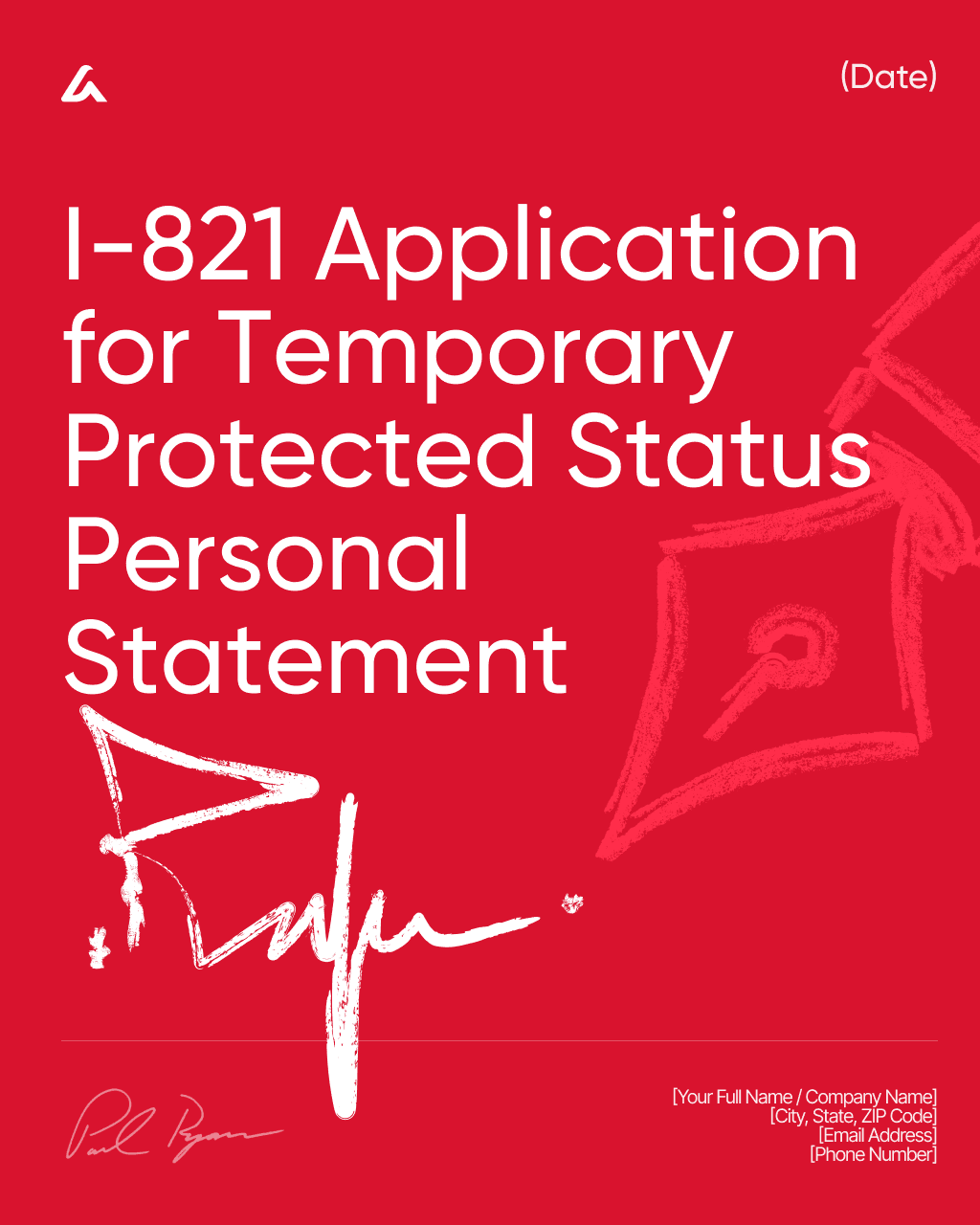
An I-821 Application for Temporary Protected Status (TPS) Personal Statement is a written narrative submitted alongside Form I-821 to explain how the applicant meets TPS eligibility requirements and why they qualify for protection. This personal statement is especially important when the applicant needs to clarify their arrival history, continuous residence, humanitarian circumstances, or reasons preventing them from safely returning to their home country. Its purpose is to present a clear, credible account that supports the application by detailing the applicant’s background, experiences, and connection to the designated TPS country conditions.
Using a standardized I-821 Personal Statement template ensures that all critical elements are properly addressed—such as the applicant’s identity, date and manner of entry into the United States, continuous physical presence, lack of disqualifying factors, and personal circumstances demonstrating the need for protection. The template may also include sections describing dangerous or extraordinary conditions in the home country (such as conflict, natural disaster, or humanitarian crisis), the applicant’s ties to the U.S., family responsibilities, and any hardships they would face if forced to return. A sworn declaration under penalty of perjury is typically included to affirm the truthfulness of the statement. AI-powered tools like AI Lawyer help applicants craft clear, organized, and TPS-compliant personal statements that strengthen the overall application and support a fair and efficient adjudication by USCIS.
Download Template: I-821 Application for Temporary Protected Status Personal Statement Template
For more information please refer to our article: U.S. Immigration Forms and Documents: Complete Guide
Or create your own document yourself with the help of AI.
1.81 I-821D Consideration of Deferred Action for Childhood Arrivals Personal Statement Template

An I-821D Consideration of Deferred Action for Childhood Arrivals (DACA) Personal Statement is a written narrative submitted with Form I-821D to explain the applicant’s background, arrival history, education, challenges, and reasons they qualify for deferred action. Although not required, a personal statement greatly strengthens a DACA request by presenting a clear and human understanding of the applicant’s life, contributions, and circumstances. Its purpose is to provide USCIS with context that supports eligibility, good moral character, and the applicant’s need for protection from removal.
Using a standardized I-821D Personal Statement template ensures that all essential elements are included—such as the applicant’s childhood arrival story, continuous residence in the United States, school attendance and accomplishments, community involvement, employment history, and any hardships faced due to lack of legal status. The template may also include sections addressing challenges such as financial instability, family responsibilities, language barriers, discrimination, or personal goals tied to remaining in the U.S. It typically ends with a declaration under penalty of perjury confirming that the information is truthful. AI-powered tools like AI Lawyer help applicants create clear, well-structured, and USCIS-appropriate personal statements that highlight their character, achievements, and ties to the United States, resulting in a compelling document that strengthens the overall DACA submission.
Download Template: I-821D Consideration of Deferred Action for Childhood Arrivals Personal Statement Template
For more information please refer to our article: U.S. Immigration Forms and Documents: Complete Guide
Or create your own document yourself with the help of AI.
1.82 I-90 Application to Replace Permanent Resident Card Cover Letter Template

An I-90 Application to Replace Permanent Resident Card Cover Letter is a professional document submitted along with Form I-90 to notify USCIS of the reason for requesting a replacement green card and to organize the supporting evidence included with the application. While USCIS does not require a cover letter, providing one helps ensure clarity, reduces processing errors, and makes it easier for officers to understand the context of the request—whether the card was lost, stolen, damaged, expired, contains incorrect information, or needs renewal.
Using a standardized I-90 Cover Letter template ensures that all key components are clearly presented—such as the applicant’s identifying information, A-number, expiration date of the current card, the specific reason for replacement, and a concise list of all supporting documents enclosed (e.g., passport copy, police report for stolen cards, marriage certificate for name changes, old/damaged card, or evidence of USCIS error). The template may also include explanations for special circumstances, notes about unavailable documents, and confirmation that the applicant is submitting the most recent edition of Form I-90. AI-powered tools like AI Lawyer help applicants generate polished, organized, and USCIS-ready cover letters that support efficient processing, reduce confusion, and strengthen the overall quality of the filing.
Download Template: I-90 Application to Replace Permanent Resident Card Cover Letter Template
For more information please refer to our article: U.S. Immigration Forms and Documents: Complete Guide
Or create your own document yourself with the help of AI.
1.83 N-400 Application for Naturalization Cover Letter Template
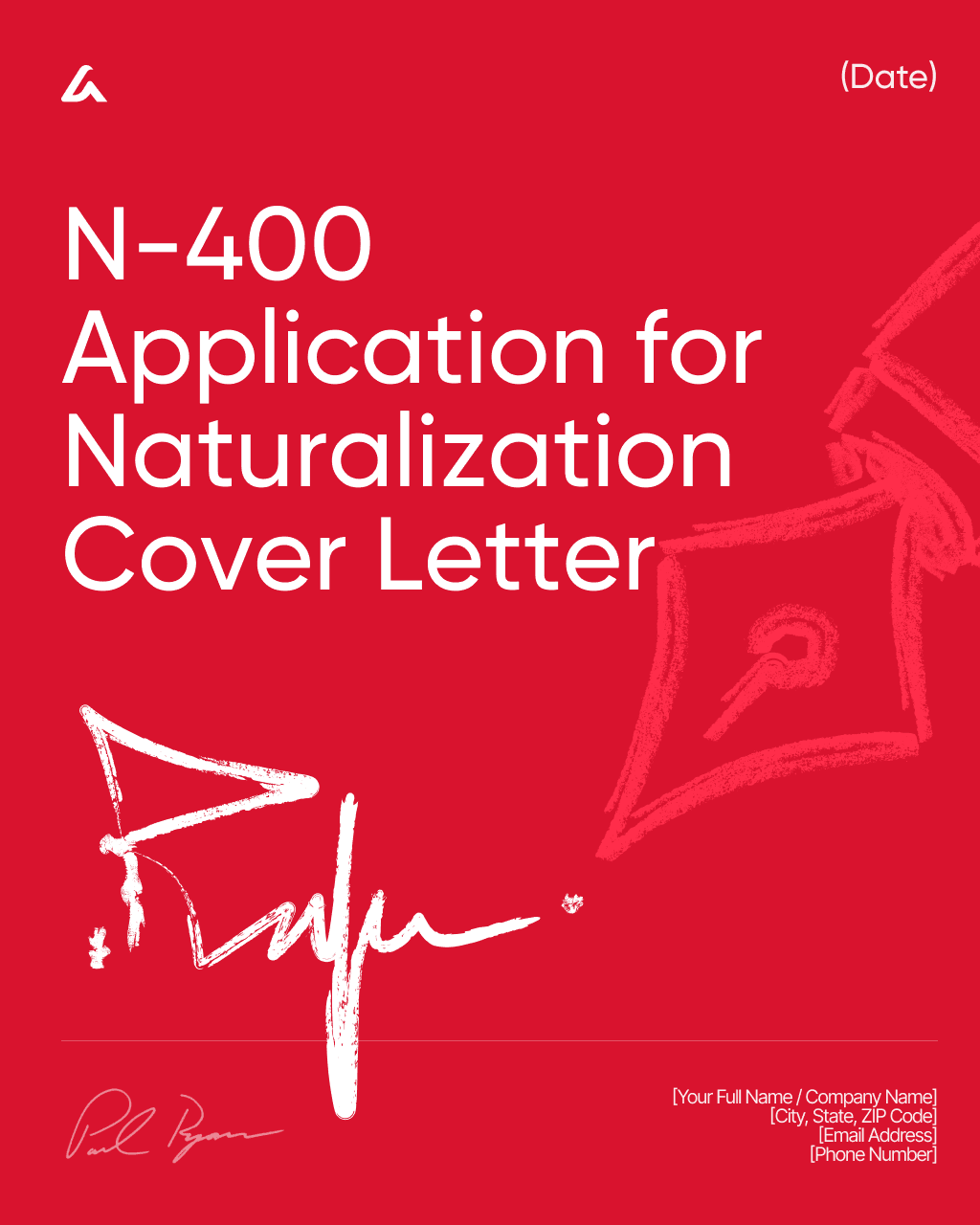
An N-400 Application for Naturalization Cover Letter is a professional document submitted with Form N-400 to help USCIS officers quickly understand the basis for the applicant’s eligibility for U.S. citizenship and to clearly organize all supporting evidence. Although USCIS does not require a cover letter, including one strengthens the application by improving clarity, providing helpful context, and ensuring that the officer can easily locate key documents during review. This type of cover letter is commonly used in cases involving marriage-based eligibility, military service, medical disability exceptions, name changes, or complex immigration histories.
Using a standardized N-400 Cover Letter template ensures that all essential components are included—such as the applicant’s identifying information, eligibility category (e.g., 5-year rule, 3-year rule based on marriage, or military service), explanations for any complicated issues (extended travel, arrests, tax history, selective service registration), and a detailed list of included evidence. The template may also note requests for disability accommodations, name changes to be granted during the oath ceremony, or clarification of discrepancies in prior immigration filings. AI-powered tools like AI Lawyer help applicants create clear, well-structured, and USCIS-compliant cover letters that reduce confusion, highlight eligibility, and support smooth and efficient case processing.
Download Template: N-400 Application for Naturalization Cover Letter Template
For more information please refer to our article: U.S. Immigration Forms and Documents: Complete Guide
Or create your own document yourself with the help of AI.
1.84 N-565 Application for Replacement Naturalization/Citizenship Document Cover Letter Template
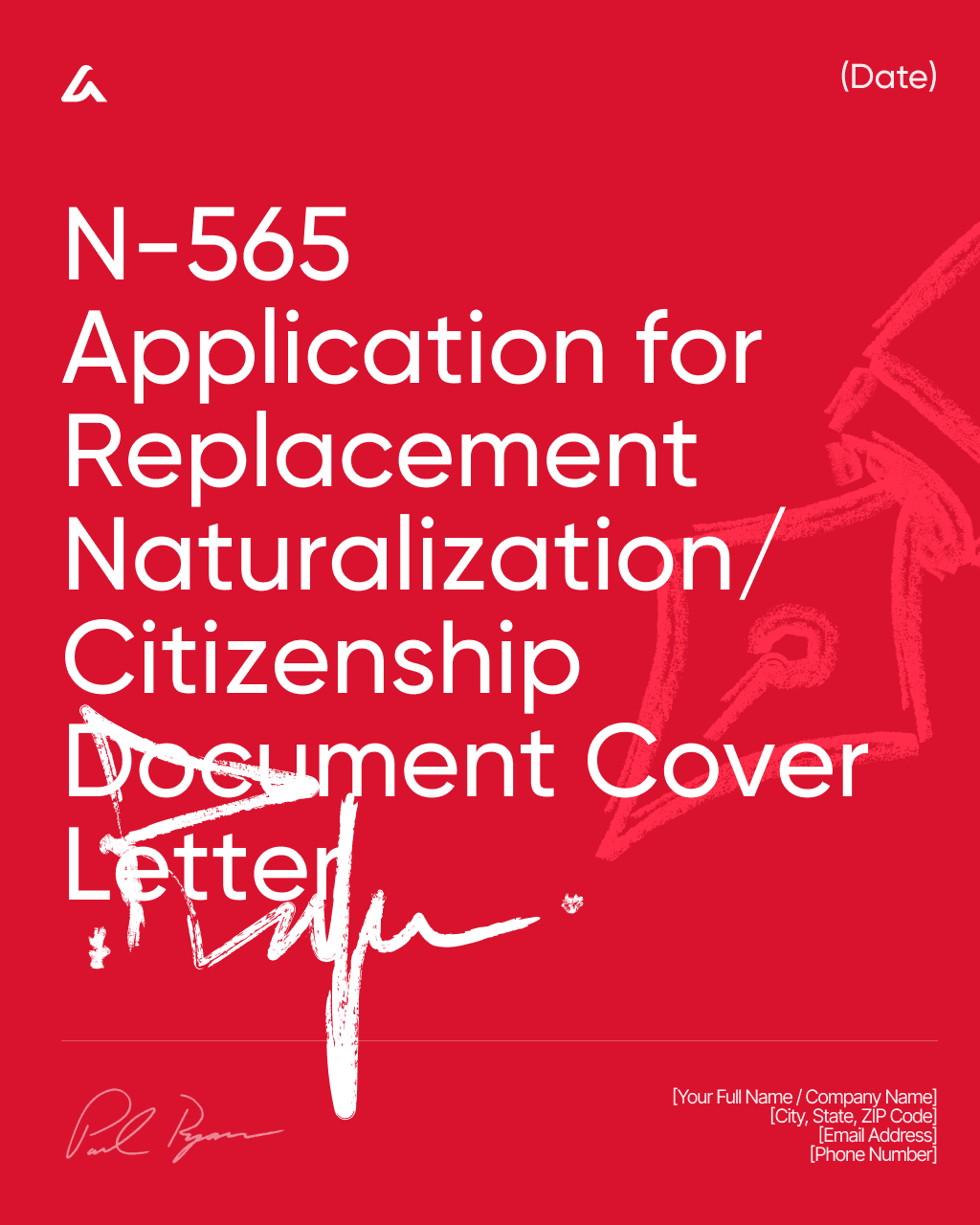
An N-565 Application for Replacement Naturalization/Citizenship Document Cover Letter is a professional document submitted with Form N-565 to explain why a new certificate is needed and to organize the supporting evidence included. Applicants use Form N-565 to replace a lost, stolen, damaged, or incorrect Certificate of Naturalization, Certificate of Citizenship, Repatriation Certificate, or Declaration of Intention. The purpose of the cover letter is to provide USCIS with a clear summary of the situation, ensuring the case is easy to understand and properly documented.
Using a standardized N-565 Cover Letter template ensures that all essential elements are included—such as the applicant’s full identifying information, the type of document being replaced, the reason for replacement (loss, theft, damage, name change, USCIS error, etc.), and a detailed list of enclosed evidence (e.g., police report, court order for name change, damaged original certificate, passport copy, or proof of USCIS error). The template may also include clarifications regarding unavailable documents, explanations of unique circumstances, and confirmation that the applicant is submitting the correct version of Form N-565. AI-powered tools like AI Lawyer help applicants create clean, well-organized, and USCIS-ready cover letters that streamline officer review, reduce confusion, and support efficient and accurate processing of replacement document requests.
Download Template: N-565 Application for Replacement Naturalization/Citizenship Document Cover Letter Template
For more information please refer to our article: U.S. Immigration Forms and Documents: Complete Guide
Or create your own document yourself with the help of AI.
1.85 N-600 Application for Certificate of Citizenship Cover Letter Template
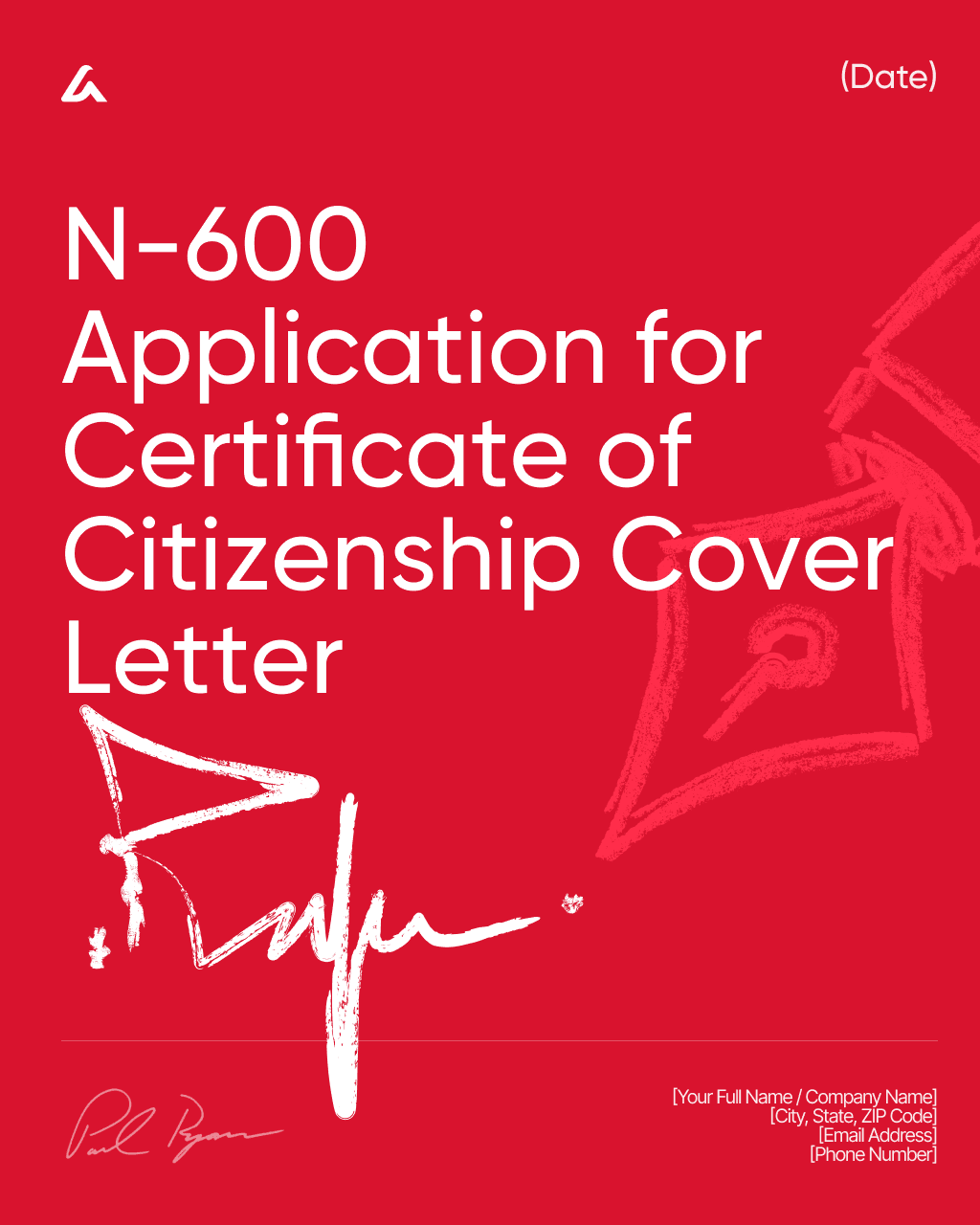
An N-600 Application for Certificate of Citizenship Cover Letter is a professional document submitted at the front of an N-600 filing to help USCIS quickly understand the basis for the applicant’s claim to U.S. citizenship and to clearly organize supporting evidence. Form N-600 is used by individuals who automatically acquired or derived U.S. citizenship through their parents, but must obtain an official Certificate of Citizenship as proof. Although not mandatory, including a cover letter significantly improves clarity and reduces the likelihood of delays or missing-document issues.
Using a standardized N-600 Cover Letter template ensures that all essential components are included—such as the applicant’s personal information, the legal basis for the citizenship claim (acquisition or derivation), parent(s)’ immigration and citizenship status, relevant dates (birth, lawful permanent residence, naturalization), and a detailed list of supporting documentation. The template may also include explanations of complex family histories, legal custody issues, name changes, adoption-related circumstances, or discrepancies in records. AI-powered tools like AI Lawyer help applicants generate clear, organized, and USCIS-compliant cover letters that improve officer understanding, support efficient case processing, and strengthen the overall application by presenting evidence in a professional and easy-to-review structure.
Download Template: N-600 Application for Certificate of Citizenship Cover Letter Template
For more information please refer to our article: U.S. Immigration Forms and Documents: Complete Guide
Or create your own document yourself with the help of AI.
📘 Overview: Which Letter or Notice Should You Use?
Not sure whether you need a reference letter, an LOI, or a demand letter? Each document serves a specific purpose in protecting your business or personal interests – from endorsing a valued employee to warning a bad actor. The table below will help you understand when and why to use each type, and how much legal “weight” it carries.
Document Type | Purpose | When to Use | Legal Weight |
|---|---|---|---|
Endorse someone’s qualifications or character | Supporting a job applicant, student, or visa case | Low (mostly persuasive, not binding) | |
Define internal rules and ownership for an LLC | Forming a new LLC or adding members | High (legally binding contract among owners) | |
Outline preliminary terms of a future agreement | Negotiation stage of a major deal (M&A, partnership) | Medium (generally non-binding, but can bind) | |
Request remedy for a wrong, with a threat of legal action | Before suing for payment, contract breach, etc. | Medium-High (not a court order, but establishes evidence) | |
Demand that someone stop unlawful behavior | When facing IP infringement, harassment, defamation, etc. | Medium (non-binding but strong formal warning) | |
Last formal notice before taking legal action | After prior reminders were ignored | Medium-High (often prerequisite before litigation) | |
Provide firsthand factual account for legal/investigative purposes | Court cases, insurance claims, workplace investigations | High (can serve as sworn testimony) | |
Notify manufacturer/seller of defect and request repair/refund | After discovering product defect | Medium (creates written record; may trigger protections) | |
Inform debtor of missed payments and remedies | After missed payments on loans, leases, contracts | Medium-High (often required pre-foreclosure/collections) | |
Report property loss/damage to insurer | Immediately after discovering damage | Medium (required under insurance policy terms) | |
Formally inform employees of layoffs | Before/on date of layoff; must comply with labor laws | High (heavily regulated; improper notice = penalties) | |
Invite foreign guest and confirm travel purpose | Visa applications or border checks | Low (support document, not binding) | |
Endorse moral character for immigration | During immigration/naturalization | Low (persuasive, non-binding) | |
Academic/professional endorsement for immigration | Student or skilled worker immigration | Low (informational, persuasive only) | |
Request government records | When seeking disclosure under FOIA | Medium (legally recognized request) | |
Release organizers from injury liability | Before events, activities, training | High (enforceable if properly drafted) | |
Request employment verification/reference | During job applications or HR checks | Low (administrative, non-binding) | |
Request immediate payment | After invoices unpaid; before legal claim | Medium-High (records intent to recover debt) | |
Confirm donation for tax/record purposes | After donating vehicle to nonprofit | Medium (IRS-required documentation) | |
Endorse company’s reliability/quality | Vendor partnerships, B2B | Low (reputational, not binding) | |
Support student/researcher application | During academic or grant applications | Low (persuasive, not binding) | |
Last notice before filing a lawsuit | After repeated failures to pay/comply | Medium-High (supports claim of good-faith efforts) | |
Release organizer from liability for injuries | Before participating in risky activities | High (enforceable if clear and voluntary) | |
Official notice ending a contract | When exiting an agreement per terms/law | Medium (supports lawful termination; prevents disputes) | |
Provide detailed account of DUI incident | Court, attorney review, probation | Low (personal statement; persuasive) | |
Chronological record of DUI-related events | DUI defense, hearings, compliance | Low-Medium (helps clarify facts) | |
Express remorse and accountability | DUI sentencing or review hearing | Low (persuasive character evidence) | |
Request limited driving privileges | After DUI suspension when hardship exists | Medium (supports restricted license review) | |
DUI Financial Hardship Statement for Costs and Fines Template | Request reduced fees/payment plan | When DUI costs cause financial strain | Medium (supports fee modification) |
DUI Treatment and Sobriety Summary Letter for Court Template | Provide treatment progress summary | Court sentencing, probation review | Medium (credible evidence from treatment) |
Explain medical conditions affecting field tests | During DUI defense | Medium (can influence evidence interpretation) | |
Outline compliance and safety steps | Sentencing, probation planning | Medium (shows responsibility and mitigation) | |
Driver’s License Reinstatement Letter to DMV or Licensing Authority Template | Request restoration of driving privileges | After suspension; when eligible | Medium (administrative decision support) |
Request removal of IID after compliance | After completing IID program | Medium (requires compliance proof) | |
DMV Administrative Hearing Request Letter after DUI Arrest Template | Request hearing to contest suspension | Within strict legal deadlines | High (must be timely; preserves rights) |
DUI Explanation Letter for Job Application or Background Check Template | Explain DUI to employer | When background checks reveal record | Low (persuasive, not binding) |
DUI Explanation Letter to Current Employer (HR Notification) Template | Notify employer/HR about DUI | When policy or license requires disclosure | Low (informational) |
Professional License Disclosure Letter Explaining DUI (Board Notification) Template | Notify licensing board of DUI | During renewal or mandatory reporting | Medium (required for compliance) |
DUI Explanation Letter for College / University / Graduate Program Application Template | Explain DUI to admissions | Academic program applications | Low (persuasive, character-based) |
DUI Explanation Letter for Rental Application / Tenant Screening Template | Explain DUI for housing application | When background checks reveal DUI | Low (persuasive) |
Track AA/NA meeting attendance | Court, probation, treatment programs | Medium (compliance documentation) | |
Confirm AA/NA sponsorship | Court/probation/treatment proof | Medium (credible participation evidence) | |
Therapist / Counselor Treatment Verification Letter (DUI-Related) Template | Confirm counseling participation | DUI cases, probation, court | Medium-High (professional verification) |
Probation Compliance Progress Report (Client Statement) Template | Summarize compliance with probation | During check-ins or review hearings | Medium-High (supports early termination) |
Outline sobriety strategies | Treatment, probation, long-term recovery | Medium (shows proactive mitigation) | |
Cover Letter for DUI Expungement / Record-Sealing Petition Template | Introduce expungement request | Filing record-sealing/expungement | Medium (persuasive support document) |
Early Termination of Probation Request Letter (DUI Case) Template | Request early probation release | After full compliance | Medium-High (can influence court decision) |
General Letter of Support Template for DUI Case (Family / Friends / Employer) | Provide character reference | Sentencing, probation review | Low-Medium (persuasive) |
Apply for a teaching position | When submitting job application | Low (professional presentation only) | |
Provide sworn testimony supporting an applicant’s character, relationship, or circumstances | Family-based petitions, hardship waivers, marriage cases, asylum support | Medium (sworn statement; persuasive but not binding) | |
Challenge a USCIS denial and request reconsideration or appeal | Filing an AAO/BIA appeal or Motion to Reopen/Reconsider (I-290B) | Medium-High (can change outcome if supported by evidence/law) | |
Confirm authenticity of a couple’s marriage through third-party testimony | I-130, I-485, I-751 marriage-based filings | Medium (persuasive relationship evidence) | |
Summarize filing and organize evidence for USCIS review | With any USCIS petition or application | Low (organizational, not binding) | |
Affirm financial backing for applicant to prevent public charge concerns | I-134, I-864 support filings, student/visitor visas | Medium (supports financial eligibility) | |
Attest to applicant’s integrity and positive behavior | N-400, waivers, VAWA, hardship cases | Medium (persuasive character evidence) | |
Confirm legitimacy of a marital relationship | Marriage-based petitions & interviews | Medium (relationship evidence) | |
Explain extreme hardship to a qualifying relative | I-601 / I-601A waivers, cancellation of removal | High (critical legal evidence) | |
Support asylum seeker’s credibility and describe known dangers | Asylum (I-589) or immigration court | Medium (persuasive corroboration) | |
Provide character or relationship testimony | Family petitions, N-400, I-751 | Medium (supportive personal evidence) | |
Request congressional assistance for case delays or issues | When USCIS/NVC processing is delayed | Low-Medium (can expedite through inquiry) | |
Explain reasons for overstay and acknowledge responsibility | I-601/I-601A waivers, consular processing | Medium-High (important for overcoming inadmissibility) | |
Organize and summarize employer’s petition | Filing I-129 (H-1B, L-1, O-1, etc.) | Low (organizational only) | |
Summarize and organize K-1 fiancé(e) petition | Filing Form I-129F | Low (organizational only) | |
Request accelerated processing for urgent cases | Severe financial loss, humanitarian need, USCIS error | Medium (discretionary approval) | |
Explain and confirm authenticity of relationship | Marriage-based immigration interviews | Medium (relationship evidence) | |
Request voluntary withdrawal of a pending petition | Divorce, changed circumstances, duplicates | High (legally ends processing) | |
Summarize and organize I-130 petition | Filing a family-based petition | Low | |
I-130A Supplemental Information for Spouse Beneficiary Cover Letter | Explain and organize spouse background info | Filing Form I-130A | Low |
I-131 Application for Travel Document (Advance Parole) Cover Letter | Explain travel purpose & list evidence | Filing Form I-131 | Low |
Structure petition and evidence for EB-1/EB-2/EB-3 | Filing Form I-140 | High (central petition evidence) | |
I-212 Application for Permission to Reapply for Admission After Deportation or Removal | Request legal permission to reenter after removal | After deportation/removal before visa processing | High (required legal authorization) |
I-485 Application to Register Permanent Residence or Adjust Status | Organize evidence for green card application | Filing Form I-485 | High |
Structure EB-5 investment evidence | Filing Form I-526 (Standalone) | High | |
Structure evidence for regional center EB-5 filings | Filing Form I-526E | High | |
I-589 Application for Asylum and for Withholding of Removal Personal Statement | Provide narrative of persecution and fear | Filing Form I-589 | High |
I-601 Application for Waiver of Grounds of Inadmissibility Personal Statement | Explain inadmissibility and hardship | Filing Form I-601 | High |
I-601A Application for Provisional Unlawful Presence Waiver Personal Statement | Demonstrate extreme hardship for unlawful presence waiver | Filing Form I-601A | High |
I-751 Petition to Remove Conditions on Residence Personal Statement | Prove good-faith marriage or hardship | Filing Form I-751 | High |
Summarize EAD eligibility | Filing Form I-765 | Low | |
I-821 Application for Temporary Protected Status Personal Statement | Explain TPS eligibility & country conditions | Filing Form I-821 | Medium-High |
I-821D Consideration of Deferred Action for Childhood Arrivals Personal Statement | Provide personal background supporting DACA | Filing Form I-821D | Medium |
I-90 Application to Replace Permanent Resident Card Cover Letter | Explain reason for replacement | Filing Form I-90 | Low |
Summarize eligibility for citizenship | Filing Form N-400 | Low | |
N-565 Application for Replacement Naturalization/Citizenship Document Cover Letter | Explain need for citizenship document replacement | Filing Form N-565 | Low |
N-600 Application for Certificate of Citizenship Cover Letter Template | Summarize claim to derivative/acquired citizenship | Filing Form N-600 | Medium |
2. Jurisdictional Peculiarities of Letters & Notices in the USA
Letters/notices in the U.S. are driven by state law, not federal. Each state sets its own pre-suit notice rules, wording, timing, and limits on what you can threaten or demand (e.g., non-competes, defamation retractions, consumer claims).
Below we review the four main U.S. regions — West Coast, Northeast, South, and Midwest — focusing on California, New York, Texas, Florida, Washington, and Illinois. Each section outlines actual documents, key legal requirements, and how AI Lawyer keeps you compliant.
2.1 West Coast: California and Washington
California: LOIs and non-competes under strict scrutiny
Actual Documents: Non-Binding Letter of Intent (LOI), CLRA 30-day demand, Rosenthal Act debt notice, anti-SLAPP-aware defamation cease-and-desist, harassment/stalking cease-and-desist. For early deal discussions, using a Letter of Intent (LOI) — California helps set expectations and avoid language that could accidentally create a binding agreement.
Requirements and nuances: Under Bus. & Prof. Code §16600, employee non-competes are void; attempts to enforce out-of-state non-competes can violate SB 699/AB 1076. Consumer claims under the CLRA require a 30-day notice (Civ. Code §1782). When escalation is needed beyond the initial notice, a Demand Letter — California can formalize the claim and push for resolution before litigation. Debt collection letters must comply with the Rosenthal Act (Civ. Code §1788). For overdue balances, a Demand for Payment — California helps request payment in a structured, compliant way before involving collectors. Speech-related threats risk California’s anti-SLAPP (CCP §425.16). If harmful conduct or defamation continues, a Cease and Desist Letter — California can request that the behavior stop while carefully avoiding anti-SLAPP exposure. LOIs: courts may enforce a duty to negotiate in good faith (see Copeland v. Baskin Robbins—summary).
Common Searches:
“Is a California LOI binding?”, “CLRA 30-day demand letter”, “California cease and desist defamation (anti-SLAPP)”.
Common Mistakes:
Using non-compete threats in CA; skipping CLRA timing; Rosenthal-noncompliant debt wording; LOIs that read like binding contracts.
How AI Lawyer helps:
Auto-inserts “Non-Binding” LOI clauses; builds CLRA-compliant 30-day demands; formats debt letters to Rosenthal; flags any non-compete language that would violate §16600; adds anti-SLAPP-safe phrasing.
Washington: non-compete crackdown + privacy signals
Actual Documents: Non-compete/solicit caution letters, Consumer Protection Act (CPA) demand, My Health My Data consent/ deletion demand, harassment/impersonation cease-and-desist. For pre-dispute negotiations, a Letter of Intent (LOI) — Washington helps frame expectations without implying an enforceable non-compete, keeping the approach compliant with RCW 49.62.
Requirements and nuances:
WA’s non-compete law (RCW 49.62) voids many covenants, blocks choice-of-law workarounds, and penalizes attempts to enforce invalid agreements. Deceptive-practice demands leverage the CPA (RCW 19.86). When a formal pre-suit notice is needed, a Demand Letter — Washington helps outline the violation and request corrective action under CPA without immediate litigation. Health-data notices/consent under the My Health My Data Act (AG overview). In cases of harassment or impersonation, a Cease and Desist Letter — Washington can demand the conduct stop while avoiding language that could backfire under state law. E-signs recognized via RCW 1.80.
Common Searches:
“Washington non-compete letter”, “CPA demand template WA”, “My Health My Data notice”.
Common Mistakes:
Sending a non-compete threat that’s illegal under RCW 49.62; ignoring CPA leverage; missing consent language for health-adjacent data. Another oversight is failing to send a proper Demand for Payment — Washington before escalating a billing dispute, which can weaken the business’s position if the matter progresses.
How AI Lawyer helps:
Warns when enforcement would trigger RCW 49.62 penalties; pivots to trade-secret/ non-solicit theories; adds CPA demand framing and RCW 1.80 e-consent blocks.
2.2 Northeast: New York
Actual Documents: Plain-English demand letters, payment/settlement notices, LOIs with explicit non-binding terms, carefully tailored restrictive-covenant letters. At the pre-deal stage, using a Letter of Intent (LOI) — New York helps preserve non-binding intent while meeting the state’s plain-language expectations under GOL §5-702.
Requirements and nuances:
The Plain Language Law (GOL §5-702) sets the readability tone for consumer-facing docs. For pre-suit issues, a Demand Letter — New York helps present claims in clear, plain English, strengthening the request and reducing the risk of it being dismissed as overly legalistic. E-signs via ESRA (state overview). Non-competes remain possible if narrow and tied to legitimate interests, with ongoing legislative pressure to limit them. When reputation or harassment concerns arise, a Cease and Desist Letter — New York can request the offending behavior stop while staying consistent with NY’s speech-sensitive standards.
Common Searches:
“NY LOI non-binding wording”, “Plain-language demand letter NY”, “Are NY non-competes enforceable?”.
Common Mistakes:
Dense legalese that flunks §5-702 expectations; overbroad non-compete threats; missing clear “no obligation until definitive agreement” in LOIs. Another misstep is skipping a formal Demand for Payment — New York before escalating overdue invoices, which weakens a business’s position in settlement discussions.
How AI Lawyer helps:
Front-loads a one-sentence bold summary; adds ESRA e-delivery/e-signature consent; narrows restrictive-covenant letters to NY-typical reasonableness tests.
2.3 Southern States: Texas and Florida
Texas: statute-driven pre-suit demands
Actual Documents: DTPA 60-day demand, Insurance Code §541 notice, Defamation Mitigation Act retraction demand, bad-check statutory notice, non-compete cease-and-desist calibrated to §15.50. To keep early negotiations clearly non-binding, a Letter of Intent (LOI) — Texas helps frame discussions without triggering unintended obligations under Texas law.
Requirements and nuances:
DTPA requires 60-day notice with detailed damages (Bus. & Com. Code §17.505). To present claims clearly before filing suit, a Demand Letter — Texas helps outline damages and requested remedy in a structured, statute-aware way. Insurance bad-faith needs Ins. Code §541.154 notice. Retractions under the Defamation Mitigation Act (CPRC §73.055). If harmful statements continue, a Cease and Desist Letter — Texas can request the behavior stop before invoking a formal DMA retraction demand. Non-competes must meet §15.50 (reasonable scope, ancillary consideration).
Common Searches:
“Texas DTPA demand letter”, “DMA retraction request”, “Texas non-compete demand”.
Common Mistakes:
Skipping DTPA/541 notice; vague damages; wrongful threats (criminal/immigration) in civil disputes. Another pitfall is failing to send a proper Demand for Payment — Texas before escalating overdue invoices, missing a chance to resolve the matter without collections or legal costs.
How AI Lawyer helps:
Builds statute-perfect DTPA/541 notices with timelines; inserts DMA retraction blocks; tunes covenants to §15.50; scrubs wrongful-threat language.
Florida: pre-suit notice traps + media-defamation rule
Actual Documents: Chapter 558 construction-defect notice, insurance civil-remedy notice, media-defamation 5-day notice, fee-shift §57.105 safe-harbor letters. For early, non-binding settlement positioning, a Letter of Intent (LOI) — Florida helps outline proposed terms without waiving statutory notice rights or creating enforceable obligations.
Requirements and nuances:
Construction defects: §558.004 notice and cure window. Insurer bad-faith practice via §624.155 (DFS portal). For non-construction disputes, a Demand Letter — Florida helps present claims and requested remedies in a clear pre-suit format before escalating to statutory notices or litigation. Media defendants require 5-day pre-suit notice with the exact statements (§770.01). When harmful statements spread, a Cease and Desist Letter — Florida can request the content be removed or corrected before invoking the formal §770.01 notice period. Anti-SLAPP: §768.295; fee-shift warnings: §57.105.
Common Searches:
“Florida 558 notice template”, “§770.01 defamation notice”, “57.105 safe harbor letter”.
Common Mistakes:
Suing media without §770.01 notice; sloppy 558 defect descriptions; overbroad speech demands triggering anti-SLAPP. A frequent oversight is skipping a proper Demand for Payment — Florida before involving collections or legal counsel for overdue service or rental fees, losing an easy opportunity for early resolution.
How AI Lawyer helps:
Auto-drafts §558.004 packages; injects §770.01 language; offers optional §57.105 paragraph; screens for anti-SLAPP risk.
2.4 Midwest: Illinois
Actual Documents: BIPA demand (biometric consent/deletion/damages), ICFA deceptive-practice demand, non-compete/non-solicit letters aligned to wage thresholds. To set a non-binding framework before exchanging drafts, a Letter of Intent (LOI) — Illinois helps outline terms without triggering enforceability and keeps negotiations aligned with 820 ILCS 90 limits.
Requirements and nuances:
Biometric claims under BIPA, 740 ILCS 14 (consent + retention policy; per-scan damages). If ongoing misuse of biometric or personal data occurs, a Cease and Desist Letter — Illinois can request that the practice stop immediately before escalating to a formal BIPA demand. Restrictive covenants limited by the Freedom to Work Act (820 ILCS 90) — income floors, 14-day review, counsel notice. Deception demands often cite ICFA, 815 ILCS 505. To address unfair or deceptive conduct before filing a claim, a Demand Letter — Illinois helps outline the issue and requested remedy in a statute-aware, pre-suit format.
Common Searches:
“BIPA demand letter sample”, “Illinois non-compete salary threshold”, “ICFA demand template”.
Common Mistakes:
Ignoring BIPA’s per-scan exposure; sending broad non-compete threats to sub-threshold earners; missing the 14-day/counsel advisement. Another recurring issue is skipping a proper Demand for Payment — Illinois before escalating overdue invoices or service fees, missing a low-friction opportunity to resolve the debt.
How AI Lawyer helps:
Prepares BIPA-specific demands (consent, deletion, policy reference); tailors covenants to 820 ILCS 90; frames ICFA letters to preserve fee/treble leverage.
3. News & Legal Updates (2024–2025)
Staying current on legal developments is crucial when drafting letters and notices – laws can change the best practices or even the enforceability of certain demands. Here we highlight recent legal changes and trends (from 2024 through mid-2025) that are particularly relevant to the documents we’ve discussed: reference letters, operating agreements, LOIs, demand letters, and cease & desist letters.
3.1 📍 Federal & State Moves on Non-Competes (2023–2025)
The FTC’s proposed nationwide ban on non-compete clauses in 2024 sparked a wave of state action — even after courts set it aside. California now penalizes attempts to enforce out-of-state non-competes (SB 699, effective Jan 1, 2024), Minnesota fully banned them in 2023, and Washington broadened its restrictions in 2024. More states, including New York, are considering similar laws.
Businesses must review cease and desist letters and contracts: referencing a non-compete could now backfire in many states. Instead, focus on enforceable protections like trade secrets and confidentiality. AI Lawyer’s 2025 templates help ensure your agreements reflect the latest legal standards.
📜 Read full analysis →
✨ Generate Cease and Desist Letter →
🚀 Generate your own document with AI →
3.2 📍 NLRB Ruling Reshapes Employment Agreements (2023–2025)
The NLRB’s McLaren Macomb decision (2023) made broad non-disparagement and confidentiality clauses in severance agreements unlawful for most non-supervisory employees. By 2024, NLRB guidance confirmed that even presenting such clauses could be an unfair labor practice.
When drafting severance, settlement, or response letters, avoid blanket “no discussion” or “no disparagement” terms. Instead, include carve-outs recognizing employees’ NLRA Section 7 rights. AI Lawyer’s updated employment templates now reflect this standard, helping you stay compliant and avoid invalid agreements.
📜 Read full analysis →
✨ Generate Layoff Notice Letter →
🚀 Generate your own document with AI →
3.3 📍 Corporate Transparency Act & LLC Agreements (2024–2025)
The U.S. Corporate Transparency Act (CTA), effective January 1, 2024, requires most companies to report beneficial ownership to FinCEN. While not altering LLC terms directly, it’s prompting updates to operating agreements — clarifying ownership shares, management roles, and requiring members to provide accurate data for reporting.
In disputes, FinCEN filings may serve as proof of ownership or authority. Letters citing member rights or authority should reference current CTA records. Many states also revised LLC laws in 2024–2025, so ensure operating agreements and related notices align with updated statutes.
📜 Read full analysis →
✨ Generate Operating Agreement →
🚀 Generate your own document with AI →
3.4 📍 Cease and Desist Letters Go Public (2024–2025)
More recipients are posting cease & desist letters online — often to expose or ridicule the sender. In 2024, several viral cases over product reviews and social media posts led to public backlash, prompting even the ABA to caution lawyers about tone and optics in such letters.
When drafting a C&D, assume it could be shared publicly. Keep language factual, proportional, and professional. Aggressive or baseless threats can damage credibility and reputation. AI Lawyer’s updated templates balance firmness with fairness, helping you protect rights without fueling a PR crisis.
📜 Read full analysis →
✨ Generate Cease and Desist Letter →
🚀 Generate your own document with AI →
3.5 📍 Demand Letters as Evidence of Good Faith (2024–2025)
Courts increasingly treat demand letters as evidence of good — or bad — faith. In 2024, Texas courts limited attorney fees when a pre-suit demand exaggerated damages, while New Jersey judges used detailed letters to justify treble damages for willful inaction. Across states, precise, reasonable demand letters can shape outcomes and penalties.
Many consumer laws, like Massachusetts’ Chapter 93A or New Hampshire’s CPA, link damages to the response after a demand. Failing to reply fairly can double or triple liability. AI Lawyer’s updated templates now tailor demand letters to each state’s rules, helping you meet notice requirements and preserve every legal advantage.
📜 Read full analysis →
✨ Generate Operating Agreement →
🚀 Generate your own document with AI →
3.6 📍 AI and Legal Letters Under Regulatory Scrutiny (2024–2025)
Regulators are paying close attention to how AI is used in legal drafting. In 2024, the ABA issued ethics guidance urging lawyers to ensure accuracy and confidentiality when using AI tools. A New York court even sanctioned attorneys for submitting an AI-generated brief with fake citations — a warning that applies equally to letters. Always verify every legal reference before sending.
AI tools like AI Lawyer make drafting faster and more precise, but responsibility remains human. Personalized, fact-checked letters show professionalism and credibility, while generic templates can undermine your position. The key is balance — using AI for efficiency without losing authenticity or legal rigor.
📜 Read full analysis →
✨ Generate Reference Letter →
🚀 Generate your own document with AI →
4. Conclusion: Clear Templates = Confidence and Trust
In a world of constant change and information overload, using AI-generated, legally sound templates for your letters and notices is like having a professional guide. They ensure every message you send is clear, compliant, and persuasive — so you can focus on the substance rather than the fine print. By standardizing reference letters, notices, and agreements, you project professionalism and show that your organization values precision and accountability.
AI Lawyer templates turn communication into an asset, not a liability. Each document is structured to cover essential clauses, avoid risky language, and include jurisdiction-specific details that reinforce fairness and enforceability. Instead of improvising or relying on generic samples, you send documents that are consistent, compliant, and tailored to the situation — from a simple reference letter to a formal cease-and-desist notice.
This approach builds trust and authority. Recipients immediately recognize diligence and clarity, while courts and partners view well-drafted correspondence as a mark of good faith. By combining technology with legal expertise, AI Lawyer helps you communicate with confidence, reduce risk, and maintain professionalism at every level. With smart templates handling the legal structure, your words can focus on what truly matters — your message, your relationships, and your reputation.
How it works
How to Get a Ready-Made Document in Minutes?
Choose a Category
Browse available categories or use search to quickly find the document you need.
Edit with AI
Use the built-in AI chat to quickly customize and adapt the template to your needs.
Download the Document
Download your ready-made document in a convenient format
Use It Hassle-Free
Your document is fully prepared—send, sign, or use it as needed.
Most popular



























































































































